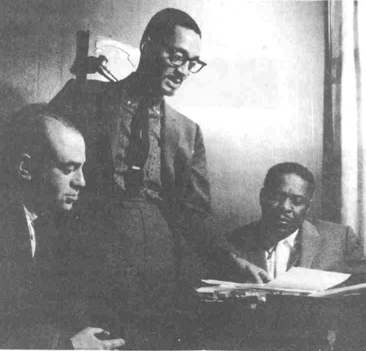
Revision note: We have updated our coverage of Duke Groner; newspaper research shows that he kept a quintet going into the early 1960s, and was leading a trio as late as 1973. A Cash Box comment by Calvin Carter about Jo Anne Raven's session makes August 8, 1955 the likely date and the El Dorados her likely backup. We have added some details about Vee-Jay 102 by Pro McClam and 104 by Wellington Blakey, from the company's first year. We have pinned the date of the Spaniels' fourth session, done under the direction of a New York-based producer named Joel Turnero, to the week of July 24, 1954. We have added information about the obscure Kelly Brothers release on C. H. Brewer (which had the same two songs on it as their release on Vee-Jay 220, but was apparently made three or four months earlier).
Vee-Jay was one of Chicago's most successful labels. Until the advent of Motown in the early 1960s, it was the country's largest black-owned record company. Four individuals were most responsible for the success of the label: James Bracken and Vivian Carter, who founded the company in mid-1953; Vivian's brother, Calvin Carter, who was the principal producer and A&R man; and Ewart Abner, Jr. A fifth individual, Art Sheridan, was a secret partner in the company.
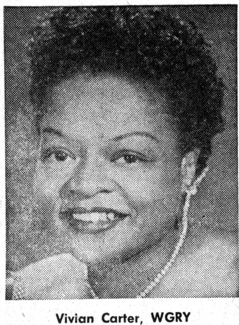
Jimmy Bracken was born in Oklahoma on May 23, 1909, grew up in Kansas City, Kansas, and attended Western University in Quindaro, Kansas. In 1944, while living in Chicago, he met Vivian Carter, who was working in the Signal Corps in the city. Carter was born in Tunica, Mississippi on March 25, 1921. Her family moved to Gary, Indiana when she was young, and she graduated from Roosevelt High in 1939. In 1948 she won a talent contest for new deejays conducted by Al Benson of WGES. She worked three months at WGES, then moved to WWCA and later to WGRY, both in her hometown of Gary, Indiana. In 1950, Carter and Bracken became business partners when they founded Vivian's Record Shop in Gary. After three years of scrimping and saving the couple decided to start a record label in the late spring of 1953. Meanwhile, Vivian continued her deejaying, which was undoubtedly significant in attracting talent to their label.
At this time two acts, a vocal group called the Spaniels and a blues singer by the name of Jimmy Reed, entered the store inquiring about recording opportunities. They would become two of Vee-Jay's biggest recording acts during the 1950s. James and Vivian set up headquarters at the record shop, at 1640 Broadway. As the couple was now tied by business interests, on December 16, 1953, they got married—at the headquarters of Ernie and George Leaner's United Distributors.
The first Spaniels and Reed records were released in the summer of 1953 and became strong local hits. The company was firmly established following the release in March of 1954 of the Spaniels' third release, "Goodnite Sweetheart, Goodnite," which became a top r&b hit and, as covered by the McGuire Sisters, a million seller.
Ewart Abner, Jr. entered Vee-Jay through his executive position at Art Sheridan's Chance Records and Sheridan Distribution Company. When Vivian Carter and James Bracken decided to form Vee-Jay they went to Abner, whom they knew through Sheridan’s distribution company, which sold records to their store in Gary. He told interviewer Portia Maultsby, "I assisted them in the paperwork, the administrative legal work for Vee-Jay and handling the incorporation of the company." As the company grew, Abner and Sheridan continued to assist Vee-Jay in this manner and gradually becoming intertwined with the Brackens helping them run the company. In December 1954 Abner and Sheridan decided to close Chance. Abner then worked briefly as an accountant for George and Ernie Leaner’s United Distributors before the Brackens appointed him as general manager of Vee-Jay around March of 1955.
In 1954, most of the company's communications with the trade papers went through one Leo Kolheim. (After leaving Vee-Jay, Kolheim went into the pressing business. Cash Box for January 21, 1956, p. 31, placed him at Musical Products.) At the beginning of 1955, Calvin Carter took over the role for a short while. Then on April 2, 1955, Cash Box mentioned that at the upcoming MOA convention, "Cal Carter and 'Ab' of the Vee-Jay diskery […] will be saying 'hi' to the ops who have helped build hits for them" (p. 62). "Ab" was used one more time in Cash Box, on April 23, 1955 (p. 21). As of May 7, it was "Ewart G. Abner, Jr., otherwise known to one and all in this man's town as just plain 'Abner' of Vee-Jay" (Cash Box, p. 21). From then on he would have his name attached to nearly every item.
One of the musicians at Vee-Jay, Red Holloway, said, "Abner's role in Chance had been as administrator. In fact, he learned his tools of trade at Chance Record Company, he learned the business there. Vivian and Jimmy didn't really know all that much about business things when it got into the real paperwork, so since Abner had been doing that at Chance, they just made a deal with him and he went over there. Abner became pretty much the boss. Jimmy and Vivian still called the shots, because they owned the label, but when it came to the final details of making deals and stuff, that's where Abner was boss, because he knew more about it and had more insight into what was happening."
Art Sheridan had no direct hand in the operation of Vee-Jay but was ever present through his part ownership, and his friendship and business relationships with Ewart Abner. He was born in Chicago on July 16, 1925, the son of an owner of an electronics factory. After World War II he caught the bug of the record business. His first experience was in the pressing plant business. He became more involved when he married Aristocrat label co-owner Evelyn Aron, after which she left the label and set up a distribution firm with Sheridan. In 1950 Sheridan started Chance and eventually brought in Ewart Abner Jr. as a partner in the operation.
Sheridan’s involvement in Vee-Jay was unknown until 1993, when he was interviewed by Robert Pruter. Sheridan in so many words alluded to his ties with Vee-Jay, but did not convey them directly. For example, when Pruter asked if nightclub ownership was his only involvement in the music business after the closure of Chance in 1954, Sheridan replied, "You have to remember the same group who ran the nightclubs were basically Vee-Jay people. We were really very much intertwined all those years. It was just not very politic for a period of time to have too many white owners." He later talked of how important that Vee-Jay should be seen as a black-owned company, saying, "You had well-educated black people who wanted to be recognized, who wanted to be in business, and Abner always felt that was something that should be fostered. Philosophically he was very avant-garde [in black advancement] and Jimmy and Vivian were very pro-black." About a decade later, Sheridan was interviewed by Nadine Cohodas, and she related Sheridan was far more direct in asserting his part-ownership.

Calvin Carter, Vivian's brother, became the label's A&R man and principal producer. He was born in Indiana, on May 27, 1925, and his first experience in the record business was when he joined his sister's and brother-in-law's firm in 1953. He took to it like a duck to water. While Carter was the producer in name, there was often a collective approach in producing the sessions. Said Holloway:
Calvin Carter was in charge of the recording sessions. Calvin was a singer, and when we recorded singers he would be saying things like, "Hey, you all didn't sing the do-do-wop right," or "you're out of tune with this one." When it came to the musicians' parts, certain fellows in the band, usually Lefty and I, would listen to the playback and take it upon ourselves to say, "let's take that over," or "you're not doing this or that," or "hey, that's not right, let's straighten that up." We in the band basically directed our part of it. When it came to vocals, though, Calvin Carter would do that. He had a good idea of what harmonies were supposed to sound like. Abner would come around to the sessions every once in a while, but he didn't usually have much to say. Musically, Abner wasn't that sharp, but he was good at making deals and doing things administratively.
The Vee-Jay house band began to coalesce in the middle of 1954, and was firmly established by the end of that year. The rhythm section usually included William "Lefty" Bates (guitar) and veteran Chicago musician Quinn B. Wilson (bass). Paul Gusman, Vernel Fournier, and Alrook "Al" Duncan alternated in the drum chair, and Horace Palm and Norman Simmons handled most of the piano duties. James "Red" Holloway was the designated tenor saxophonist in the early going; later on he would share those responsibilities, which included nearly all of the horn soloing, with Lucius Washington (aka "Little Wash") and Cliff Davis. McKinley "Mac" Easton, long a mainstay of the Red Saunders band, was the baritone saxophonist everyone wanted for session work in Chicago.
The house band at Vee-Jay was under the leadership of bassist Al Smith (musicians made fun of his prowess on the instrument, which others had to tune for him, but everyone respected his ability to get gigs and make deals). He also was in charge of rehearsing and preparing Vee-Jay acts for recording sessions; he held these rehearsal sessions in his home. Moving over from Chance, as it began to wind down, he and his musicians handled about 1/5 of the tracks that Vee-Jay released, from June 30 through the end of 1954. Smith continued to lead a combo in the clubs during this period, and was not under exclusive contract to Vee-Jay. His band was also doing session work for Parrot, and occasionally for the declining United/States operation.
For its recording sessions, Vee-Jay went to Universal Studios on the near North Side. Said Pirkle Lee Moses, "Vee-Jay always used Universal Studios. They did it in three hour or six hour sessions, that's the way they did it. They would rent the studio for a half a day and they would cut maybe two or three artists." The organizing principle of this discography makes use of the matrix system established while the company worked out of Universal—a five digit number, the first two ostensibly for the year, followed by a hyphen and a three digit number (the series would eventually add a fourth digit, toward the end of 1958). The series was opened with 53-100 for the Spaniels’ "Baby It’s You."
Early on, Vee-Jay became involved in gospel music and recorded many of the top acts in the field, notably the Staple Singers, the Swan Silvertones, the Original Five Blind Boys, and the Highway QC’s. Early jazz performers included Willie Jones, Tommy Dean, Turk Kincheloe, and Julian Dash. During its first three years in operation, Vee-Jay released the gospel and jazz items on the same numbering system as the blues and vocal group recordings.
But Vee-Jay established itself as a hitmaker with doowop groups and blues singers. The biggest groups were the Spaniels, the El Dorados, and the Dells, but the label carried a host of lesser names, such as the Magnificents, the Kool Gents, and the Rhythm Aces. The biggest blues acts were Jimmy Reed and John Lee Hooker, but the label also recorded Snooky Pryor, Billy Boy Arnold, Floyd Jones, Billy "The Kid" Emerson, L. C. McKinley, and Eddie Taylor.
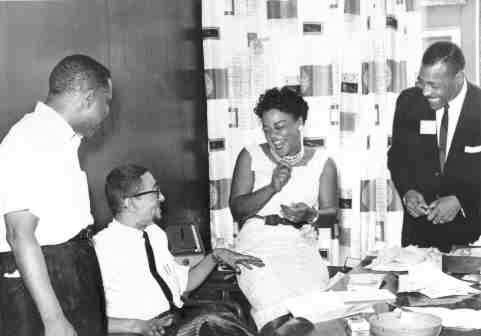
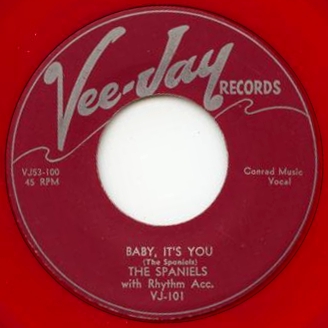
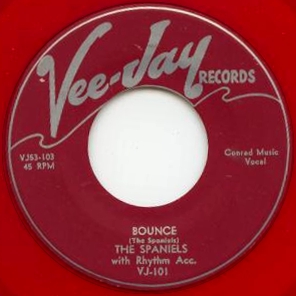
The Spaniels were probably Vee-Jay’s first signing. The group originally consisted of James "Pookie" Hudson (lead tenor), Gerald Gregory (bass), Willis C. Jackson (baritone), Opal Courtney (baritone), and Ernest Warren (first tenor). They were accompanied by a rhythm unit from the Red Saunders band. From this first session on May 4, 1953, when the group was less than six months old, the Spaniels proved remarkably adept. The session yielded their delightful minor hit, "Baby It's You." The record was Vee-Jay's second release, but it proved too potent for the tiny company to handle. In July 1953, Carter and Bracken leased the record to Art Sheridan's Chance Records for national distribution and it was on Chance 1141 that the record was heard through most of the country. In the fall of 1953, "Baby It's You" lasted two weeks on Billboard's r&b chart and went to #10.
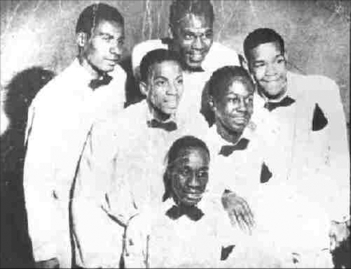
Vee-Jay 202, featuring "Since I Fell For You" from this first session, was a single released in July 1956. Vee-Jay 202 was reviewed in Cash Box on July 28, 1956 (p. 83). It was included in a big company ad for the NAMM Convestion, in the same issue (p. 79) and readvertised on August 4 (p. 31).
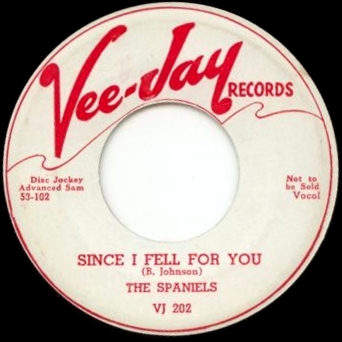
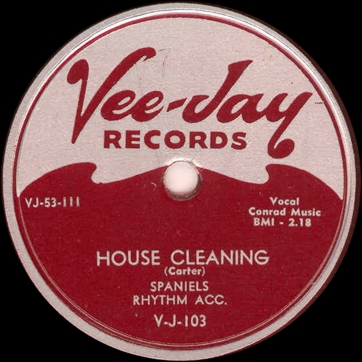
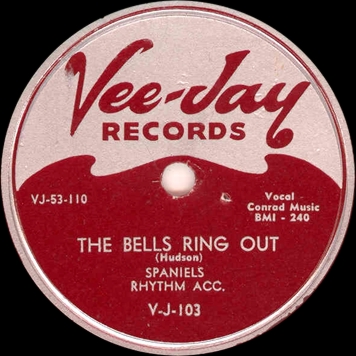
A second session (dated September 23, 1953 on a Charly reissue) not only established the Spaniels, but also helped immensely to establish Vee-Jay as a viable business entity. The big song they did at their second session was "Goodnite Sweetheart, Goodnite." The unidentified backing is by a tenor sax, piano (very simple), guitar, bass, and drums.
Surprisingly, the company chose a different first release from the session, "The Bells Ring Out," which was also deemed worthy of reissue in 1960. The side appeals to collectors today but did nothing then. The flip, "House Cleaning," is a blues with a lead by Gerald Gregory and plenty of solo spaces for the tenor saxophonist.
But when the company did get around to releasing it, "Goodnite Sweetheart" lasted 16 weeks on the Billboard R&B charts and went to #5 in the Spring of 1954. It sold a ton of copies in the pop market. A cover by the McGuire Sisters was an even bigger hit, earning a lot of money for Vee-Jay publishing arm.
The band behind the Spaniels consists of tenor sax, piano, electric guitar, bass, and drums. It seems to be same as on the Pro McClam session, which has been given the same date, and the Wellington Blakey session (which existing sources haven't bothered supplying a date for).
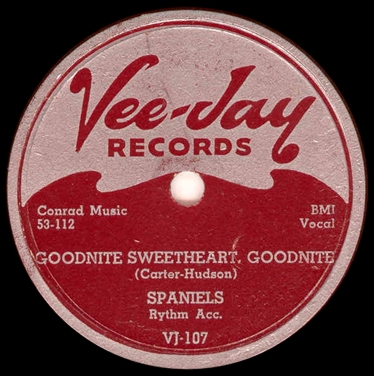
The Spaniels' third session (53-124 through 53-126, December 1953) produced a treasured street-corner song, "Do-Wah." Robert Stallworth says, "The instrumentation is very sparse leaving the voices to carry the song. The interplay of James Hudson doing lead and Gerald Gregory on bass is classic. The high tenor rounds out these three voices, which seem to be challenging each other for dominance. Listen to Gerald's voice 68 seconds into the song as he grunts Pookie from the microphone. Imagine hearing this song in Washington Park in Chicago on a Saturday night; it is pure street corner harmony. The other two voices are more complementary than dominant."
This was the last session by the full early group. "Do-Wah" had to wait till April 1955 for a release on Vee-Jay 131. It was coupled with "Don'cha Go" from the mystery session of February 19, 1955. Vee-Jay 131 was already being talked up in Cash Box on February 26, 1955 (p. 29), but advertisements didn't follow till April 9 (jointly with Vee-Jay 133 by L. C. McKinley, Cash Box, p. 26), April 23 (jointly with Vee-jay 132 by Jimmy Reed, Cash Box, p. 22), and April 30 (solo ad, p. 28). Vee-Jay 131 was only a modest hit, appearing on some territorial charts (it did best in Saint Louis).
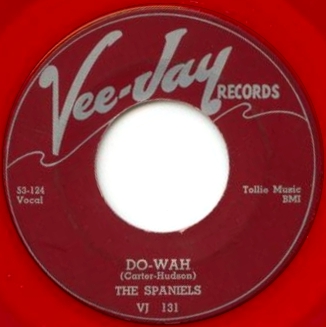
The third session also provided a flip side for "Goodnite Sweetheart, Goodnite," a gospelly account of rejection titled "You Don't Move Me." The Charly notes say the band on the December 20 session was led by tenor saxophonist Al Pitts, and included Henry Porter (trumpet), Ernest Robinson (piano), Jimmy Johnson (bass), and George Green (drums). We suppose Vee-Jay used such a band to back someone, but on the December 20 session we hear just tenor sax, piano, bass, and drums. This was the personnel on the "Count Morris" instrumental (see below), which was obviously cut to fill out the 3-hour session.
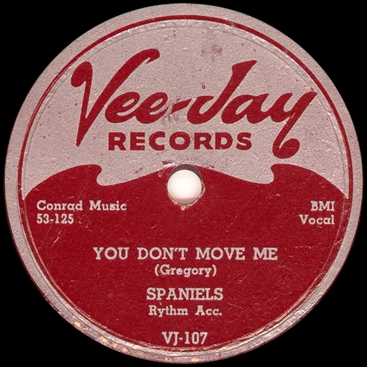
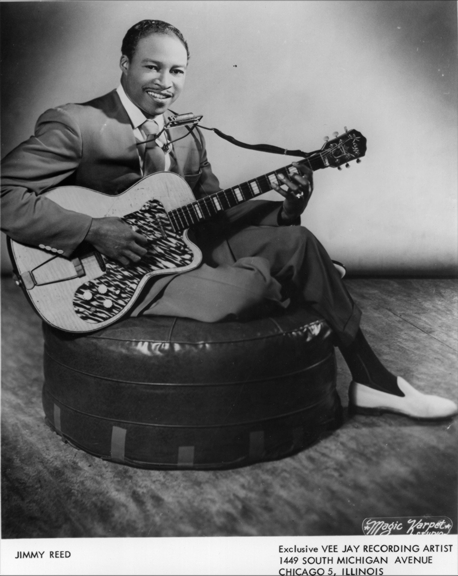
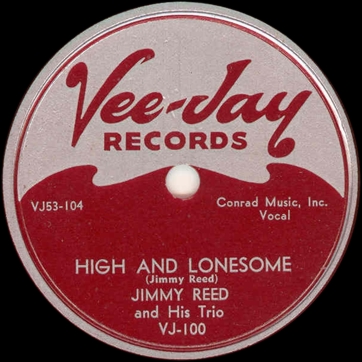
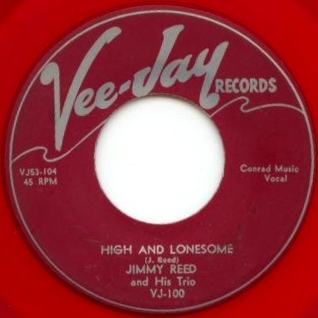
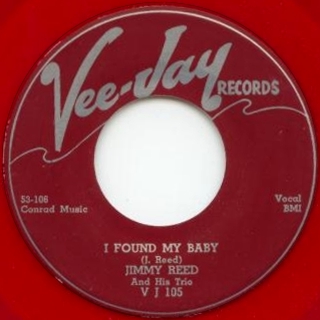
Jimmy Reed, famous for his laid-back drawling delivery accompanied by his harmonica blowing and rudimentary guitar strumming, was Vee-Jay’s second signing. He was born Mathis James Reed on September 6, 1925, on a plantation near Dunleith, Mississippi. Reed moved to Chicago in 1943, and after service in the Navy during World War II settled in Gary, Indiana. The first session in June 1953 produced no hits, but Vee-Jay 100 sold enough under both Vee-Jay and Chance imprints to keep the fledgling company interested.
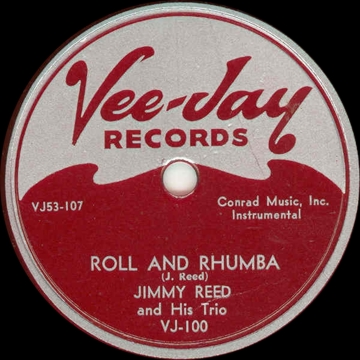
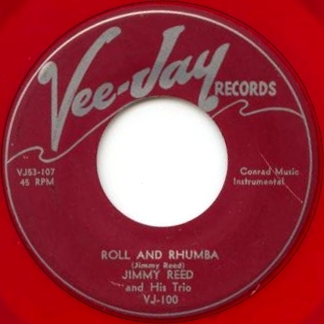
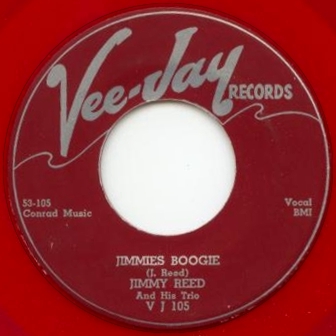
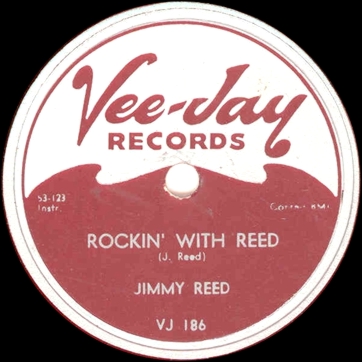
A second session at the end of the year produced Reed’s first national hit, "You Don’t Have to Go." Vee-Jay 119 wasn't released until November 1954, and even then it took time to catch on. It followed a trajectory like Vee-Jay 107. When Vee-Jay 119 broke into the charts it lasted 10 weeks and went to #5 on the Billboard R&B chart. The company bought ads for it in Cash Box for January 15, 1955 (p. 24), February 5, 1955 (p. 31)—and on they went, for quite a while.
Between "Goodnite Sweetheart" and "You Don't Have to Go," Vee-Jay had a single cut in 1953 that scored sales for most of 1954, then a second single cut in 1953, not released till nearly the end of the next year, that sold for at least six months in 1955. It's fair to say that Vee-Jay 107 and 119 kept the company in business. But once they'd enabled Vee-Jay to build a national profile, with reliable distribution across the country, such slow-building sleepers could not be repeated.
The key ingredient in the Jimmy Reed sound was the addition at his second session of guitarist Eddie Taylor, who provided a firm drive to the songs. Reed would now emerge as one of the biggest blues acts in the country.
A third track from the late December 1953 session, 'Rockin' with Reed" wasn't used until April 1956, when it served as the flip to Vee-Jay 186. (The fourth side was eventually released on an LP.) Vee-Jay 186 was talked up (p 32), advertised (p. 31), and reviewed in Cash Box on April 28, 1956 (p. 30). 186 was given an ad the next week that reproduced the review (Vee-Jay often did this when a record had received a spotlight review; May 5, 1956, p. 30). The company kept pushing the record for a while, buying ads on May 12 (p. 64) and July 7 (p. 27).
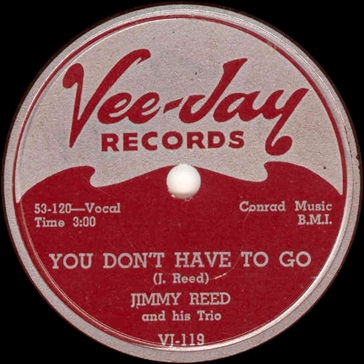
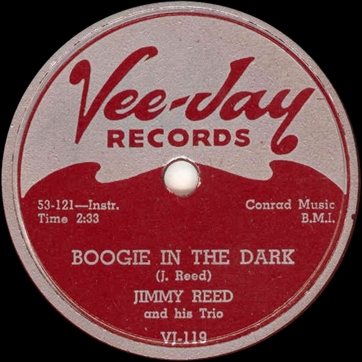
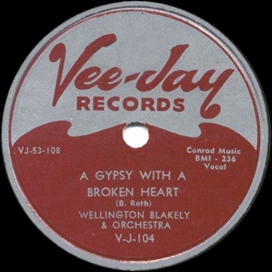
Wellington Blakey was a native of Gary, Indiana, who performed regularly in local venues. He was a cousin of the famed jazz drummer and bandleader Art Blakey (1919-1990). A baritone vocalist who sounded a lot like Roy Milton, Wellington Blakey was usually given more of a pop production. In 1952, he sang on one side of each of two singles by Max Miller and (the) Life Record All Stars. Max Miller (1911-1985) was a locally renowned pianist and vibraphonist who did little recording because he didn't want record companies getting control of his compositions. Instead, Miller made a lot of private recordings in his own studio; Life Records got him on board in 1950 by making him its music director. When the company made a new and (as it turned out) final effort at recording in February1952, Max Miller was running his own studio. For the date he assembled the Life Record All Stars, a quintet of jazz musicians led by Miller on vibes, but Blakey's sides with them are best described as bluesy pop performances. (On Life 1011/5001 and 1012/5002, the singer's name came out as "Blaky.") Life, a tiny Chicago-based operation, was out of business by the time Blakey got a chance to record for Vee-Jay, which decided to call him "Blakely."
What was apparently the only release to come out under the singer's own name, Vee-Jay 104, hit the stores in October 1953, when the company was still located in Gary. Both of his songs on Vee-Jay 104 were written by local songwriter Bernard Roth (they had been collaborating for a while—both of the tunes Blakey performed for Life the previous year were Roth compositions). "Gypsy" is a tango, sung semi-operatically with accompaniment by violin, tenor sax, organ, electric guitar, string bass, and Latin percussion; the violinist gets a solo. Danny Overbea wished he could sing this way. "Sailor" is a pop-calypso with organ doubling piano, tenor sax, electric guitar, bass, and more congas and bongos; the faster tempo leaves room for guitar and piano solos and a percussion break.
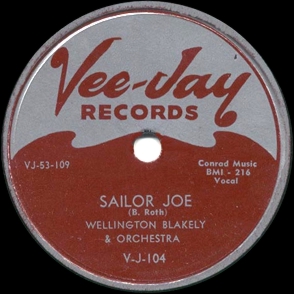
Wellington Blakey continued to perform locally without getting more offers from record companies. In October 1960, he had a lacquer made at Bud Pressner's studio on Washington Street in Gary, presumably as a demo. The actual recordings, of four standards, were made in a club on a cheap tape machine. This time the studio got his name right. We don't know to whom Blakey presented his lacquer. Pressner was about to start his own label called Steeltown, but according to Jason Yoder, an authority on Steeltown, he did not release anything on Blakey.
Wellington Blakey last appeared on record in February 1964, when his cousin invited him to New York to sing on a track while the Jazz Messengers were recording for Riverside. "Wellington's Blues," released on Art Blakey's Kyoto album, featured good smooth stand-up blues singing in the Roy Milton manner, with sterling accompaniment to Wellington's final chorus by tenor saxophonist Wayne Shorter. What Wellington Blakey did after making what was by far his most widely distributed recording remains a mystery to us.
According to a conversation that Big Joe Louis had with Kevin Chess (Phil Chess's son), Bernie Roth was a butcher in Gary, Indiana, who wrote songs. He brought more songs to Vee-Jay after the company lost interest in Wellington Blakey. Roth songs that the company recorded included "You Painted Pictures" and "False Love," which the Spaniels cut in July 1955, and "Dear Heart," which they would cut in January 1956 (along with a remake of "False Love"). Starting around 1955, Roth would also offer songs to Chess. His most famous compositions are "Just to Be with You" and "Forty Days and Forty Nights," two blues classics recorded by Muddy Waters; he was also responsible for "Who," a song recorded by Little Walter. We'd thought that Roth's songwriting activity was over in 1956, but it turns out that in 1965 one "David" Roth was given part credit for two songs that were recorded by a rock band called The Jokers; these were released on Destination 614 in October 1965. The Jokers were from Valparaiso, Indiana, not far from Gary; they recorded in Chicago; and the Library of Congress shows Bernard Roth as the sole composer of both songs. Chris Bishop's post on The Jokers says that Roth was a pharmacist, but if that was really the case he must have gone to school at some point during the past decade.
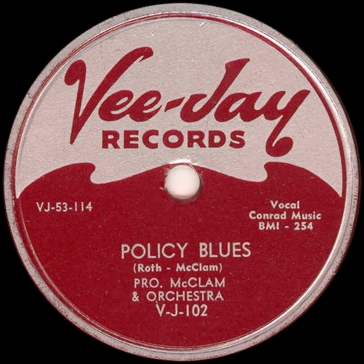
Blues shouter Clarence "Pro" McClam was born in Mississippi on August 28, 1919, served in World War II, and was probably a resident of Gary when his first record came out on Vee-Jay. The company’s third release paired "Policy Blues." on which Bernard Roth was credited as co-composer, with "Boot-um." The record was originally advertised in October 1953 as by "Professor of the Blues," but it was listed on the label as by "Pro. McClam & Orch." McClam might have objected to Vee-Jay leaving his name off the billing! McClam was accompanied by John Goosby on piano, Floyd Dungy on bass, and Delbert Scott on drums. Dungy, who had previously recorded with Schoolboy Porter for Chance, on June 25, 1951, had his name spelled "Dungee" on this occasion. In fact, the company could afford more than three rhythm on the date. Goosby, if he is the one, doubles on organ, and somebody missed a tenor saxophonist, not to mention an electric guitarist with a hard attack. "Policy Blues" features a hard-charging guitar solo and barwalking tenor sax. "Boot-um" has a guitar intro and the obligatory ensemble chorus of "Boot 'em up, baby." Another guitar solo in the T-Bone manner, and more barwalking. Previously, McClam had made "Strange Strange Lover" with the Chicago All Stars, who recorded for Columbia in December 1947. That same month he appeared as a vocalist for Sax Mallard's All Stars on their Aristocrat single, "Rolling Tears."
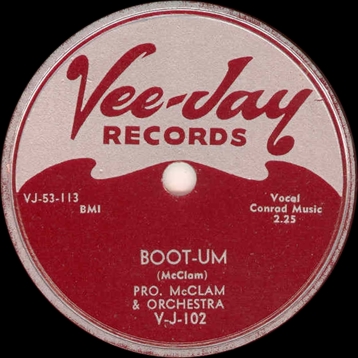
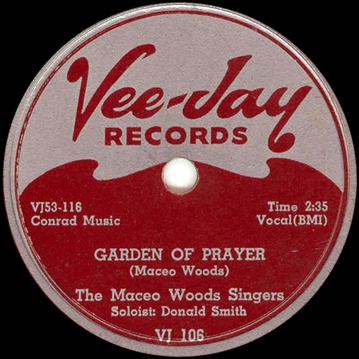
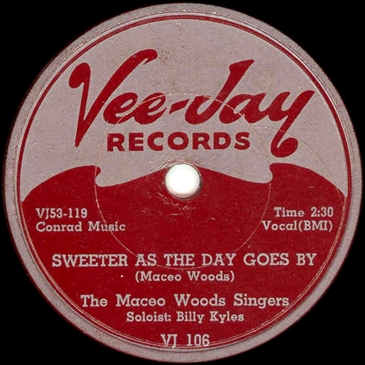
Vee-Jay began to establish a presence in gospel music when the label signed organist Maceo Woods. Maceo Woods was born in the Morgan Park neighborhood in Chicago, on April 23, 1932. Woods organized his first group, the Maceo Woods Male Chorus, from members of the Mt. Calvary Baptist Church. Out of the chorus came The Maceo Woods Singers, consisting of Norman Murchison, Billy Kyles, and Donald Smith. Woods’ first recordings were for Apollo in 1952, and the following year he joined the fledging Vee-Jay company. The session from the fall of 1953 featured Norman Murchison leading on "Keep Trusting," Billy Kyles leading on "Run to Jesus" and "Sweeter as the Day Goes By," and Donald Smith on "Garden of Prayer."
The first relase on the Maceo Woods Singers, Vee-Jay 106, was held till February 1954. The second, on Vee-Jay 108 ("Keep Trusting" b/w "Run to Jesus") was advertised in Cash Box on April 24, 1954 (p. 25), but not reviewed there till July 10 (p. 22).
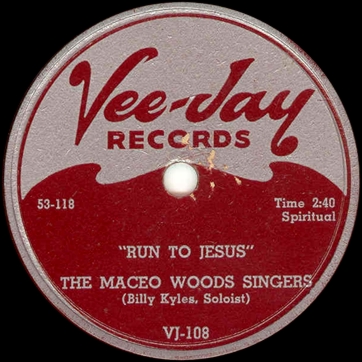
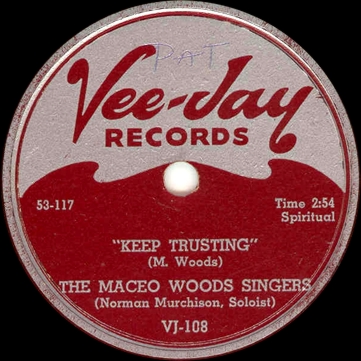
Count Morris was pianist Floyd Morris, accompanied by a rump unit of the Red Saunders band—identifiable as Leon Washington on tenor sax, probably Jimmy Richardson on bass, and definitely Red himself at the drums. The track was recorded on December 20, 1953, but was only released in April of 1955 on Vee-Jay 134, as a flip side for a Dells record, "Tell the World." (Vee-Jay 134 was reviewed in Cash Box on May 7, 1955, p. 24). Jørgen Jepsen's Jazz Records lists this session—but he credits Count Morris with vocals, and there aren't any!
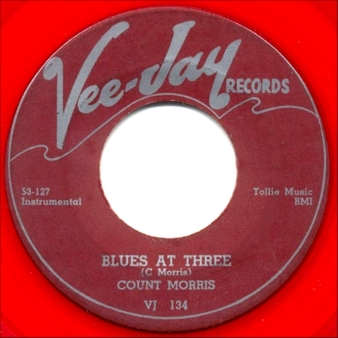
By the end of 1953, Vee-Jay had recorded 28 sides by seven artists. (Matrix number 53-115 appears to have been left blank.) As is our custom, we have marked in bold the matrix numbers that we are able to confirm from the 78 and 45-rpm singles that Vee-Jay released at the time. We have also identified artists and titles as they appeared on the singles.
Twenty-seven sides over a half-year of business actually seems fairly vigorous for a company that was just a mom and pop operation. The only substantial sales for the company came from one national hit, "Baby It’s You," by the Spaniels. The necessary national distribution for that hit was attained only by placing the record with Chance. At year's end, just five releases (100 through 104) were in the catalogue. The prospering record store in Gary was probably keeping the record business afloat in these tenuous early months. But the next year would see an acceleration in activity, and an even larger national hit by the Spaniels.
| 53-100 | Spaniels | Baby It's You | Vee-Jay 101, Chance 1141 | May 4, 1953 | Jul 1953 |
| 53-101 | The Spaniels | Sloppy Drunk | unissued | May 4, 1953 | |
| 53-102 | The Spaniels | Since I Fell for You | Vee-Jay 202 | May 4, 1953 | Jul 1956 |
| 53-103 | Spaniels | Bounce | Vee-Jay 101, Chance 1141 | May 4, 1953 | Jul 1953 |
| 53-104 | Jimmy Reed and His Trio | High and Lonesome | Vee-Jay 100, Chance 1142 | poss. June 6, 1953 | Jul 1953 |
| 53-105 | Jimmy Reed and His Trio | Jimmies Boogie | Vee-Jay 105 | poss. June 6, 1953 | Jan 1954 |
| 53-106 | Jimmy Reed and His Trio | I Found My Baby | Vee-Jay 105 | poss. June 6, 1953 | Jan 1954 |
| 53-107 | Jimmy Reed and His Trio | Roll and Rhumba | Vee-Jay 100, Chance 1142 | poss. June 6, 1953 | Jul 1953 |
| 53-108 | Wellington Blakely [sic] & Orchestra | A Gypsy with a Broken Heart | Vee-Jay 104 | prob. September 23, 1953 | Oct 1953 |
| 53-109 | Wellington Blakely & Orchestra | Sailor Joe | Vee-Jay 104 | prob. September 23, 1953 | Oct 1953 |
| 53-110 | Spaniels | Rhythm Acc. | The Bells Ring Out | Vee-Jay 103 Vee-Jay 342 |
Sept 23, 1953 | Oct 1953 Mar 1960 |
| 53-111 | Spaniels | Rhythm Acc. | House Cleaning | Vee-Jay 103 | Sept 23, 1953 | Oct 1953 |
| 53-112 | Spaniels | Rythm Acc. | Goodnite Sweetheart, Goodnite | Vee-Jay 107 | Sept 23, 1953 | Mar 1954 |
| 53-113 | Pro. McClam & Orchestra | Boot-Um | Vee-Jay 102 | Sept 23, 1953 | Oct 1953 |
| 53-114 | Pro. McClam & Orchestra | Policy Blues | Vee-Jay 102 | Sept 23, 1953 | Oct 1953 |
| 53-115 | |||||
| 53-116 | The Maceo Woods Singers | Soloist: Donald Smith | Garden of Prayer | Vee-Jay 106 | Oct/Nov 1953 | Feb 1954 |
| 53-117 | The Maceo Woods Singers (Norman Murchison, Soloist) | Keep Trusting | Vee-Jay 108 | Oct/Nov 1953 | May 1954 |
| 53-118 | The Maceo Woods Singers (Billy Kyles, Soloist) | Run to Jesus | Vee-Jay 108 | Oct/Nov 1953 | May 1954 |
| 53-119 | The Maceo Woods Singers | Soloist: Billy Kyles | Sweeter as the Day Goes By | Vee-Jay 106 | Oct/Nov 1953 | Feb 1954 |
| 53-120 | Jimmy Reed and his Trio | You Don’t Have to Go | Vee-Jay 119 | poss. Dec 29/30, 1953 | Nov 1954 |
| 53-121 | Jimmy Reed and his Trio | Boogie in the Dark | Vee-Jay 119 | poss. Dec 29/30, 1953 | Nov 1954 |
| 53-122 | Jimmy Reed | Shot My Baby | (Vee-Jay LP 7303) | poss. Dec 29/30, 1953 | |
| 53-123 | Jimmy Reed | Rockin’ with Reed | Vee-Jay 186 | poss. Dec 29/30, 1953 | Apr 1956 |
| 53-124 | The Spaniels | Do-Wah | Vee-Jay 131 | Dec 20, 1953 | Apr 1955 |
| 53-125 | Spaniels | Rythm Acc. | You Don’t Move Me | Vee-Jay 107 | Dec 20, 1953 | Mar 1954 |
| 53-126 | Spaniels | Gerald Blues | unissued | Dec 20, 1953 | |
| 53-127 | Count Morris | Blues at Three | Vee-Jay 134 | Dec 20, 1953 | Apr 1955 |
Early in 1954 the Brackens would move Vee-Jay's headquarters from Gary to a modest dwelling at 412 East 47th. Red Holloway called it a converted "garage on 47th Street." The new headquarters placed Vee-Jay in the midst of Chicago’s rhythm and blues record row, near United, Chess, Parrot, and Chance. By August, the company had grown so much that Vee-Jay moved around the corner to larger headquarters at 4747 South Cottage Grove.
Vee-Jay did hardly any recording from January through March—we have only two blues sessions from that period listed, one by Floyd Jones and one by Sunnyland Slim. The company’s experience with these deep blues artists must not have been satisfactory. It never recorded Floyd Jones again and it kept the Sunnyland Slim sides in the can. Vee-Jay avoided recording any downhome blues artists for the remainder of the year, not even bringing Jimmy Reed back. The Brackens most likely felt that such artists were not commercially viable. It was only after Reed’s third single, "You Don’t Have to Go," slowly grew into a hit after becoming the last release of the calendar year, Vee-Jay 119 in November 1954, that the Brackens decided there might be sales potential in down-home blues.
In contrast to its low level of blues recording, Vee-Jay was unusually vigorous in recording gospel acts during 1954. Vee-Jay resumed recording with a marathon session on April 11 that featured one gospel group after another—Brother Isaiah’s Church of God in Christ Choir, the Lockhart Singers, Singing Sammy Lewis, and the Holy Gospel Singers. Three days later Vee-Jay would take into the studio organist Maceo Woods, who must have been selling some platters, because he would become the label’s most prolifically recorded gospel act. Among the additions to the secular artist stable in 1954 were the El Dorados, the Five Echoes, the Rhythm Aces, Julian Dash, and Tommy Dean.
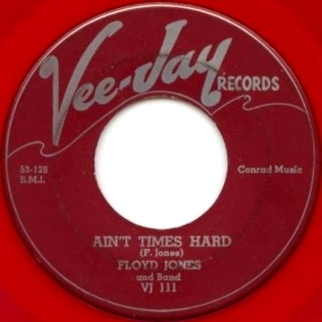
Guitarist Floyd Jones specialized in dark, brooding blues that often spoke to depressed economic and social conditions—"Stockyard Blues" for Marvel (1948), "Hard Times" and "School Days" for Tempo-Tone (1949), and two versions of "Dark Road," for JOB (1951) and Chess (later in 1951). He made another session for Chess in 1952 and another for JOB in 1953, before moving to Vee-Jay, where he cut "Ain’t Times Hard." In fact, two of his four sides were remakes of his Tempo-Tones. Leadbitter and Slaven give a date of February 3, 1953 for his Vee-Jay session, but this would be months before Vee-Jay opened, and the matrix numbers postdate those applied to the label's December 1953 sessions. The date was obviously February 3, 1954. The rest of the band on this session consisted of Snooky Pryor (harmonica), Sunnyland Slim (piano), Eddie Taylor (guitar), and Alfred "Fat Man" Wallace (drums).
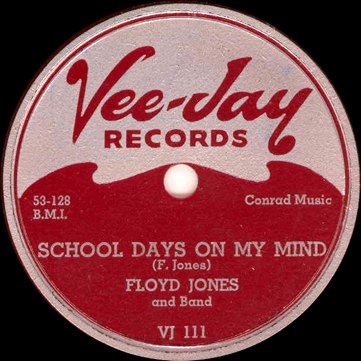
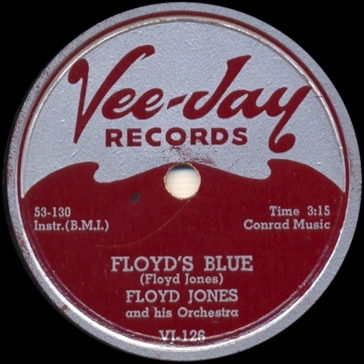
Floyd Jones was born on July 21, 1917, in Marianna, Arkansas. After several years of dabbling with the guitar, he began playing it in earnest when Howlin’ Wolf gave him an instrument. Through much of the 1930s and early 1940s he worked the South as an itinerant musician. After visiting Chicago a couple of times, Jones moved to the city permanently in 1945, settling in the Maxwell Street neighborhood. In the city, the blues became more electrified, and Floyd Jones, who had been playing an acoustic guitar with an electric pickup, switched to a Gibson electric. He began playing on Maxwell Street and in non-union venues with such artists as Snooky Pryor, Little Walter, John Henry Barbee, and Sunnyland Slim. He joined the union in 1949.
The first Floyd Jones release got a lot of advertising (it was just the 12th single from a company that was still working slowly and methodically). The initial ad appeared in Cash Box on July 24, 1954 (p. 20), though a review of Vee-Jay 111 didn't follow till August 28 (p. 22).
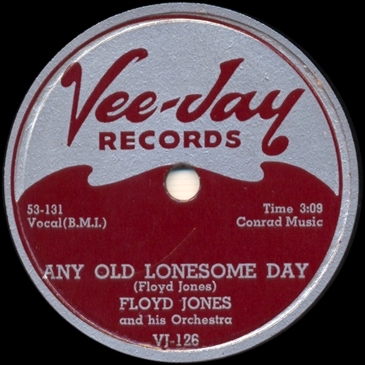
The sales on Vee-Jay 111 prompted no quick decision about the other two sides from the date, but in March 1955, after Jimmy Reed had finally scored a blues hit, the company put "Floyd's Blue" and "Any Old Lonesome Day" on Vee-Jay 126. Vee-Jay 126 enjoyed the rare distinction of being reviewed in Cash Box (April 2, 1955, p. 67) even though the company never ran an ad for it and hadn't put anything about into the magazine's Chicago-based R&B news.
The Vee-Jay session proved to be Jones’s last before the blues revival of the 1960s. A new White audience created a market for the pioneers of Chicago blues, and in 1966 Pete Welding recruited Floyd Jones to record an LP with Eddie Taylor for his Testament label. Jones subsequently recorded for the Swedish Magnolia label (with Big Walter Horton in 1970) and Earwig (with Honey Boy Edwards, Sunnyland Slim, and Kansas City Red in 1979, and with Big Walter in 1980). Floyd Jones died in Chicago on December 19, 1989.
On the same date, Vee-Jay recorded four tracks with Sunnyland Slim as the leader, and two with Eddie Taylor as the leader, but left them all in the can. The Sunnyland Slim items stayed unreleased for half a century, finally apperaring on a Classics CD in 2006; the Eddie Taylors are still languishing. (The Vee-Jay Master Book gives February 7, 1953 as the date on the Eddie Taylor items, but they are obviously not from 1953 and February 3, 1954 is what makes sense to us.)
The four sides that Slim did for Vee-Jay must be counted among his best work from the early 1950s, for both performance and sonics. He used Eddie Taylor and Floyd Jones (guitars), Snooky Pryor (harmonica), and Alfred Wallace (drums). (The notes to the Classics release incorrectly state just one guitarist was present when both are readily audible.) "Worried about My Baby" is the only number redone from previous session as a leader (it was recorded in January 1953 for JOB and also left unreleased at the time.) The first three sides are noteworthy for their clarity and their brooding grandeur; it doesn't hurt that Pryor is in the best form he would attain on record. "Be My Baby" concludes the session with tricky rhythms and two blazing amplified harp solos. We haven't heard Eddie Taylor's tracks and therefore can't evaluate them.
Sunnyland Slim never returned to Vee-Jay. He moved on quickly to Al Benson's Blue Lake operation, cutting four sides later the same year. The tracks didn't end up with the Parrot/Blue Lake material eventually acquired by Chess. We suspect this is because he recorded the sessions himself and sold or leased the sides to Benson. Sunnyland Slim did a little more for JOB, then cut one outstanding single for Club 51 in 1955. The second half of the decade found him doing some accompaniment for Abco and getting one single for Cobra as a leader, but the blues revival of the early 1960s brought him a spate of new recording opportunities. Eddie Taylor, on the other hand, would get many futher opportunities to prove himself to Jimmy Bracken and Vivian Carter.
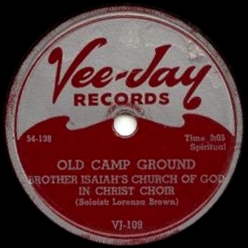
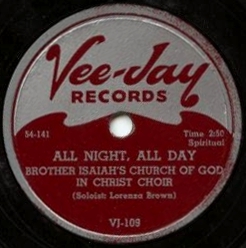
While published accounts routinely refer to the first gospel group to record for Vee-Jay on April 11 as Brother Isaiah’s Choir, the full name of the group was Brother Isaiah’s Church of God in Christ Choir, which identifies the ensemble as coming from the leading black Pentecostal denomination. COGIC, as the denomination often called itself from its acronym, was the greatest moving force in the development of gospel music in the black church. Hayes and Laughton identify Brother Isaiah as Isaiah Pryor, but Bob Marovich believes that Brother Isaiah was actually Isaiah Roberts, who in 1954 was pastoring a COGIC church at 9230 South State and billing himself as "Brother Isaiah." His father, William Roberts, had founded the first COGIC church in Illinois, in 1916, and was still pastoring the church at 4021 South State in early 1954, but died later that year.
In 1955, Isaiah Roberts was called to head his late father's church, now called the Roberts Temple Church of God in Christ. There a regular broadcast of services was begun on WHFC (later moving to WSBC and WVON), and the hymn that opened the broadcast was the choir's first Vee-Jay recording "All Night, All Day" (Vee-Jay 109). The choir’s principal lead singer was the great Lorenza Brown, who would play a large role in Chicago gospel music, notably as lead of the famous Argo Singers. She is heard on both sides of Vee-Jay 109 and on "The Fountain" from Vee-Jay 140. "Climbing High Mountains" featured soloists Jerry Jordan and Clara Mae Stevenson.
The first release from the session, Vee-Jay 109, came out around August of 1954.
Vee-Jay 140 was part of a group of gospel releases from May 1955, along with 137 by the Reverend James Lofton's Choir and 139 by the Lockhart Singers. "Ab" talked them up to Cash Box on May 21, 1955 (p. 21) and the company advertised them in the same issue (p. 22). 140 was reviewed in Cash Box on July 2, 1955 (p. 62).
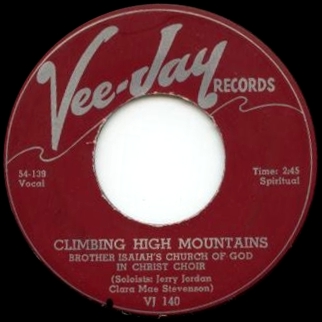
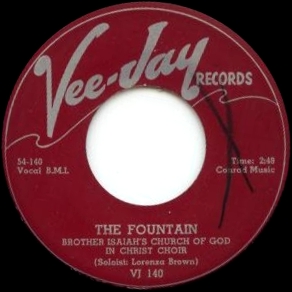
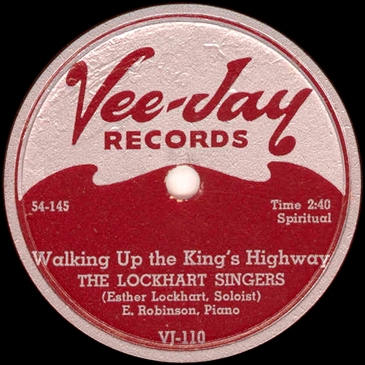
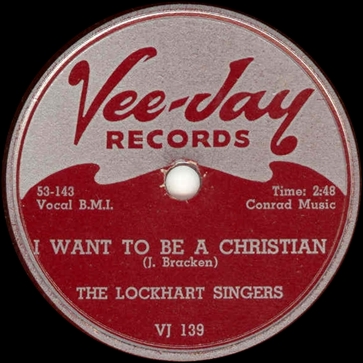
The Lockhart Singers were a mixed Chicago group under the direction of lead singer Esther Lockhart. According to Horace Clarence Boyer, in his book How Sweet the Sound, the other members were two of Esther Lockhart's sisters and a cousin. Ed Robinson played piano on the session, which also included organ (probably by Maceo Woods) and drums.
Of the four sides released on the group, "Own Me as a Child" (Vee-Jay 110), proved to be a hit. Vee-Jay 110 was reviewed in Cash Box on August 21, 1954 (p. 24). Horace Clarence Boyer said that the group rarely toured on the gospel circuit. When they did, audiences "demanded" that they always sing "Own Me as a Child" (p. 232).
The second release from the session, Vee-Jay 139, was grouped with 137 by the Reverend James Lofton's choir and 140 by Brother Isaiah's Choir. "Ab" talked them up to Cash Box on May 21, 1955 (p. 21) and the company advertised them in the same issue (p. 22). Vee-Jay 139 was reviewed in Cash Box on June 25, 1955 (p. 23).
The Lockhart Singers did not record for Vee-Jay again; Boyer reports that they broke up in 1957. Esther Lockhart, who went by the name "Little Esther," got married and continued her gospel career as Evangelist Esther V. Smith. In the early 2000s, her home church was the International Gospel Center in Ecorse, Michigan.
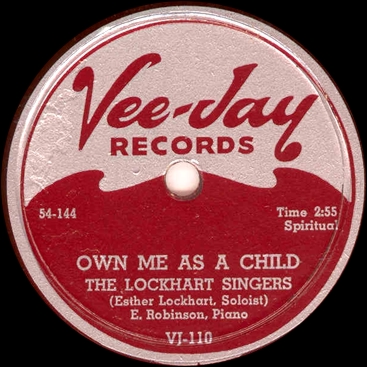
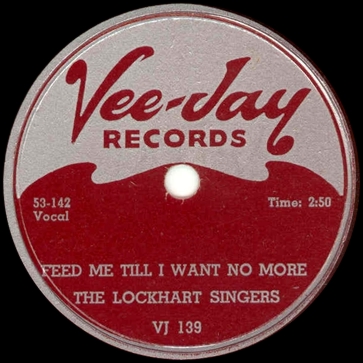
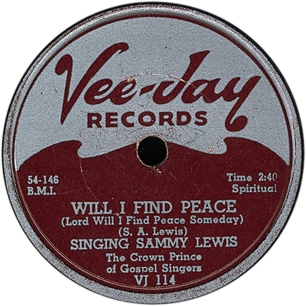
Sammy Lewis was usually billed as Singing Sammy Lewis. Born in 1921, he was a long-time star on Chicago's gospel circuit. As a boy he was a member of the Roberta Martin singers. In 1949, he recorded under his own name for Aristocrat and in 1954 he cut two sessions for Vee-Jay, in April and October. Accompaniment for the April session consisted of piano (Robinson), organ (Woods), and drums. In his liner notes to Working the Road: The Golden Age of Chicago Gospel (Delmark), Anthony Heilbut points up the influence of Mahalia Jackson in Lewis's singing, with his "bluesy runs and impassioned interjections." His last session, shared with the Lucy Smith Singers, was done for United in June 1956. Sammy Lewis died in 1994.
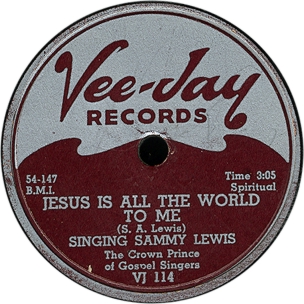
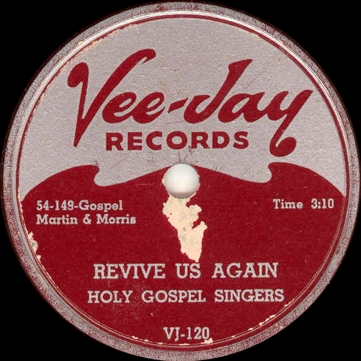
The Holy Gospel Singers, a female vocal group whose personnel is unknown to us, recorded four sides at the April session. Accompaniment was by paino and drums. Two were released in the company's January 1955 batch as Vee-Jay 120: "Revive Us Again" and "Move Up." (Vee-Jay 120 was advertised on January 22, 1955, p. 29, then reviewed in Cash Box on February 5, 1955, p. 29.) The other two sides, "In the Morning When I Rise" and "Hold on to God's Unchanging Hand," remained in the can.
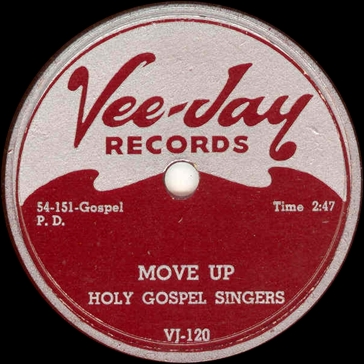
Said gospel maven Bob Marovich, "’Revive Us Again’ is arranged very neatly and delivered very neatly by the group. What is most striking about this recording is the alto section. The altos get so low I had to listen a couple of times to make certain these were not men singing! The Holy Gospel Singers really let loose on ‘Move Up,’ their fourth and final recording that day. Buoyed by what must have seemed a successful recording date and encouraged by a rocking piano and drum backbeat, the group sunk their teeth into this gospel chestnut. Soloist and choir let out all the stops as they rendered this song in the Pentecostal tradition."
Besides recording his singing group, Vee-Jay recorded Maceo Woods as a solo artist playing his Hammond organ. The first session of the year, in April, produced four sides by the group. The second session, double the length of the first, took place in September 1954 and included 2 organ solos along with 6 tracks the group. It produced Woods' gospel hit, "Amazing Grace," which according to gospel expert Lee Hildebrand remains the "best-selling instrumental in African-American gospel history."
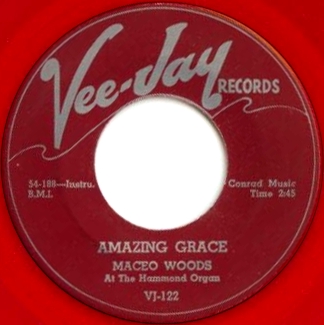
"Amazing Grace" came about from Woods’ work on Vivian Carter’s radio show. Woods' job was to play organ interludes, and at one point he was noodling around on "Amazing Grace." Carter was taken with the number, immediately taped a complete run-through of the gospel classic, and made it the theme for her show. It then appeared on a single, Vee-Jay 122. Vee-Jay 122 ("Amazing Grace" b/w "Leaning on the Everlasting Arm") was part of a 5-disk release in January 1955 (Vee-Jay 120, 121, 122, 124, and 125, advertised in Cash Box, January 22, 1955, p. 29). Occasionally, Cash Box would forget what it was doing and review the same record twice. The first review ran on January 29 (p. 31); the second, giving higher ratings to each side of the single, ran on March 26 (p. 27). Maybe the double review convinced the company it didn't need to pay for more advertisements on 122. At the end of 1956, the company mentioned Maceo Woods in a big Cash Box ad—with "Amazing Grace as the title (December 29, 1956, p. 41).
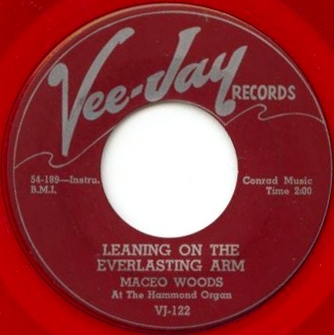
"Amazing Grace" sold so well that Vee-Jay didn't put out anything from the April 1954 session until October 1955. "Never Grow Old" and "In the Sweet Bye and Bye" were paired on Vee-Jay 152, which Cash Box reviewed on October 22, 1955 (p. 33). By the middle of 1955, Vee-Jay had temporarily quit advertising gospel releases in Cash Box. The rationale was presumably that the company now had plenty of new releases, the magazine catered to juke box operators, and gospel singles were rarely played on juke boxes. Cash Box still reviewed a couple of "Spiritual" releases each week, and Vee-Jay 152 was one of those selected even though no promotion for it had appeared elsewhere in the magazine.
The other two sides by the Maceo Woods Singers from April 1954 were never issued. The group sides from September 1954 were not released on singles either, but Vee-Jay eventually used some of them on a gospel LP.
On June 30, it appears Vee-Jay held a marathon recording session of secular acts that included Pro McClam, Floyd Valentine, Willie Jones, and almost certainly the El Dorados. That four acts were recorded on the same day at the very end of the month suggests that Vee-Jay was saving its pennies, but also feeling great urgency about getting back into the secular market.
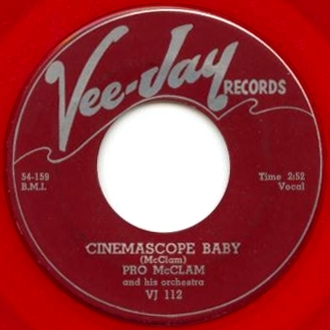
Pro McClam recorded his best known number at the June 30 session, "Cinemascope Baby." This could not have been more topical in 1954, when Hollywood was desperately trying to fight the inroads of television with large screen presentations. It served as the perfect answer to Big Joe Turner's "TV Mama," which had been a hit a few months earlier. (Both women were praised for having a "big wide screen.") Pro McClam acquits himself well on this 12-bar blues with a gentle swinging lope. The tenor saxophonist gets a nice long swinging solo on the break. McClam probably used the same accompaniment as Floyd Valentine on his two numbers recorded the same day, which would make John Gooseby the tenor soloist. So far as we know, this was McClam's last recording session. He died in complete obscurity in Gary, Indiana, on April 24, 2005.
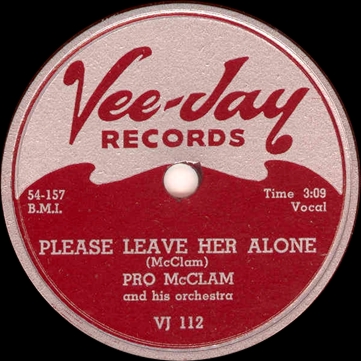
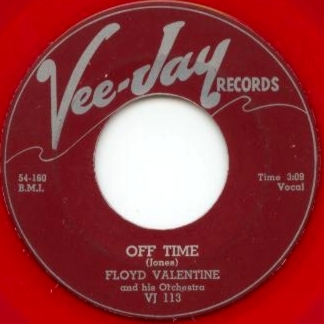
Floyd Valentine, who played trumpet and sang, was born Floyd Jones (he changed his name so as not to be confused with the down-home blues singer whom Vee-Jay had just recently recorded). He had previously recorded with Sonny Thompson's band on two sessions for Miracle, in April and June 1949 (he got a solo spot on "The Fish-I," from the April session); he also appeared on Thompson's first session for King, in January 1950. Valentine is accompanied on his Vee-Jay session by John Gooseby (tenor sax), Leroy Harrison (piano), Dresden Thomas (guitar), Floyd Dungy (bass), and Delbert Scott (drums). [At least, that's what our sources have said... we note that on Pro McClam's 1953 session, Gooseby was credited with playing piano. And the bassist's name came out "Dingy" this time around.] The Vee-Jay session—his only one as a leader, according to Lord—took place on June 30.
In 1963, Vee-Jay established a reissue label called Oldies 45. One side of Oldies 45 OL90, released in January 1964, is "Fussing and Loving," as it's rendered there. It would be interesting to know why the Floyd Valentine side was chosen; the only earlier Vee-Jay masters to get attention in the Oldies 45 series were by The Spaniels.
Inquiring minds want to know: is this the same Floyd Jones who was a member of Lionel Hampton's trumpet section in 1960?
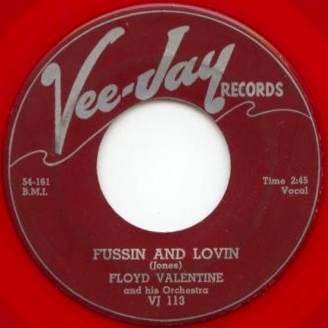
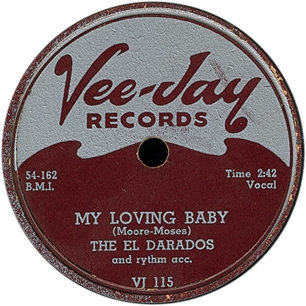
The El Dorados were a West Side group that consisted of Pirkle Lee Moses (lead), Louis Bradley (tenor), Jewel Jones (second tenor-baritone), Arthur Bassett (tenor), and Richard Nickens (baritone-bass). The group was signed to Vee-Jay on June 1, 1954. During that year they recorded a session in June—we suspect it was June 30—and one in September. The group's early numbers tended to be slow and bluesy, and Vee-Jay got no hits from them. The June session, which marked the Al Smith Band's first appearance for Vee-Jay, was only for two numbers; Vee-Jay 115 was released in July 1954. There are no instrumental solos on either side. Pirkle Lee Moses sings the lead on "My Loving Baby;" Arthur Bassett is responsible for the lead on "Baby I Need You." On early pressings of Vee-Jay 115, the name of the group was misspelled "El Darados."
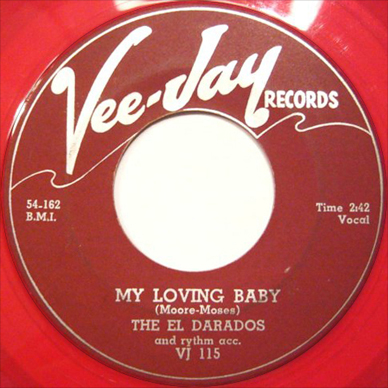
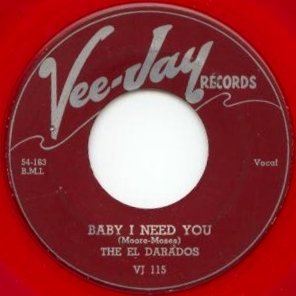
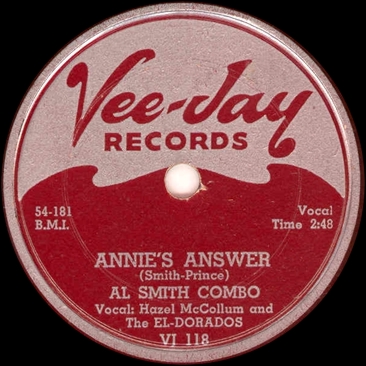
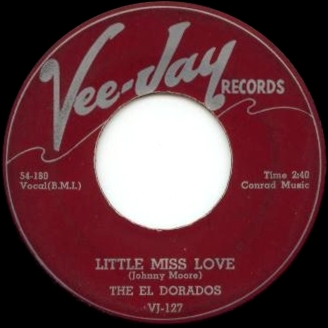
In September, the El Dorados returned for a second session, now featuring the standard four numbers. The backing unit again was the Al Smith Combo, but a female singer, Hazel McCollum, also made an appearance. At the time, she was married to Robert McCollum (i.e., blues guitarist and singer Robert Nighthawk). She can be heard leading on "Annie’s Answer," which, of course, responded to the Midnighters’ "Work with Me Annie" and "Annie Had a Baby." Lefty Bates gets a guitar solo on "Annie’s Answer." The El Dorados sang on "One More Chance’ and "Little Miss Love," two exceedingly weak numbers. The fourth side, "Livin’ with Vivian," is a Count Basie-style instrumental, on which Horace Palm deftly imitates the master, but the main attraction is baritone saxophonist Mac Easton. Mac rarely got an extended solo opportunity on record; he made the most of it on this tour de force.
Vee-Jay 118 was the priority release, because of the answer song. It was out in November 1954. Vee-Jay 127, featuring the El Dorados on both sides, was talked up in Cash Box on February 26, 1955 (p. 28), advertised in Cash Box on March 5, 1955 (p. 24), and reviewed there on April 2, 1955 (p. 67).
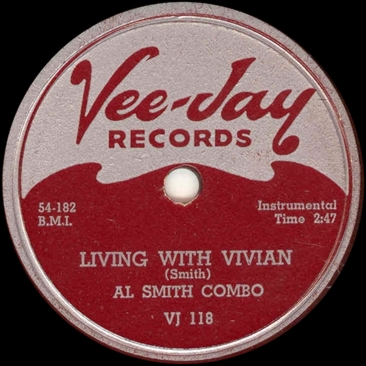
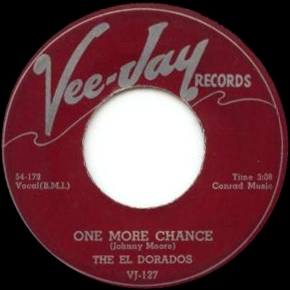
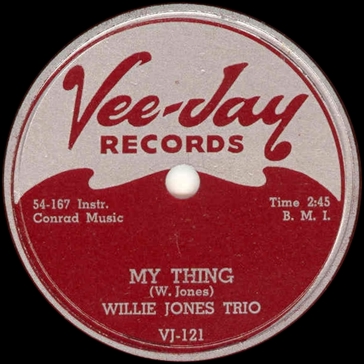
Willie Jones was born William Marvin Jones in Vicksburg, Mississippi, on February 21, 1920. He served in the military in World War II and joined the Musicians Union in Chicago on November 26, 1945. For three decades, Willie Jones regularly played the clubs and worked as a backing musician on jazz, blues, and R&B recording dates. His Vee-Jay recording date in 1954 stemmed from a trio he formed in April to play at the Esquire Lounge, which included Betty Dupree (bass) and Earl Phillips (drums). Betty Dupree Overton (to use her married name—her husband was tenor saxophonist Timothy Overton) was the contractor on the gig. The trio then moved to the Streamliner for several weeks. After these two engagements, it appears that the entire trio (Willie Jones, Betty Dupree, and Earl Phillips) became the rhythm section for tenor saxophonist Melvin Scott, when he took over at the Flame Lounge at the end of May.
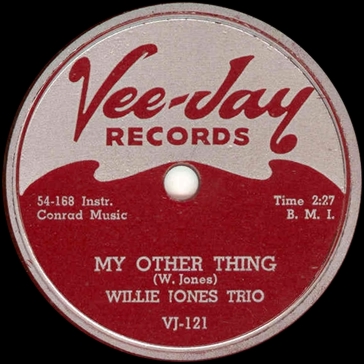
While they were working the Flame, Vee-Jay signed the trio up and recorded a session. It would be the only session Jones made as a leader. Jones's showmanship had gained him a following in the clubs, but what did Chicago record buyers make of this material when it hit the stores in January 1955? Vee-Jay 121 was part of a batch release that month, along with Vee-Jay 120, 122, 124, and 125. It got the least publicity of the five, being mentioned in one Cash Box ad and one pre-release blurb—and it was not reviewed. The record is very rare today.
Willie Jones' wildest solos were often done on the simple framework of the 12-bar blues (e.g., "My Other Thing"). His mature style resembled a cross between Milt Buckner and Cecil Taylor (but Cecil would not be making his first record for another 2 years). Willie Jones appeared on three sessions for Parrot and Blue Lake in 1955, backing vocal groups. In 1957 he appeared on albums for Argo under the leadership of two of Duke Ellington's musicians, Paul Gonsalves and Clark Terry, and in 1960 he got onto a session by Singing Sam for Bea & Baby. His last appearances on record were with tenor saxophonist Tommy Jones (not a relative) in 1963 and in the early 1970s. Willie Jones died of arteriosclerotic cardiovascular disease in Chicago on December 31, 1977.
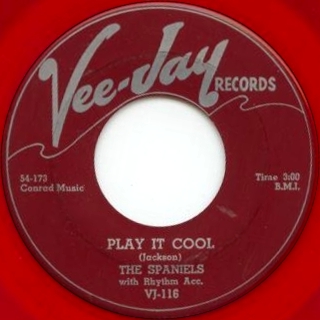
The Spaniels' fourth session for Vee-Jay in July 1954 featured some strong songs. Remakes appear to have been necessary, as three Spaniels sides were rejected outright. "Play It Cool" was a tremendously appealing novelty, where the rarely used Willis Jackson employed his rough-hewn voice on a story that made use of liquor and cigarette brand names. "Let’s Make Up" was a lovely but conventional ballad. "Danny Boy" was always popular with African-American singers and this was the Spaniels' first take on the old chestnut. Vee-Jay kept it in the can; it wasn't released until 1993.
The Spaniels were accompanied by this occasion by Morris Wilkerson (piano); Ike Perkins (electric guitar); George Green (bass); and Frank Collins (drums), according to the Mohr-Flückiger-Demeusy files. A special credit for session supervision (unique in the early history of Vee-Jay) went to an arranger and producer from New York City. As explained by an item from "Chicago Tidings" in a July 1954 issue of Cash Box: "Joel Turnero, visiting Cash Box columnist, in town to supervise the Spaniels' latest wax session at the invitation of Jimmy and Vivian Bracken and Leo Kolheim of Vee-Jay Records" (see Galen Gart, The History of Rhythm & Blues Vol 4: 1954, p. 74, published by Big Nickel Publications). Turnero had an office on West 125th Street; he announced that he'd been in Chicago supervising the session in his "Stars over Harlem" column (Cash Box, July 31, 1954, p. 19), indicating a date around July 24. In June 1953, Turnero had supervised a session by blues pianist Willie Mabon for Chess.
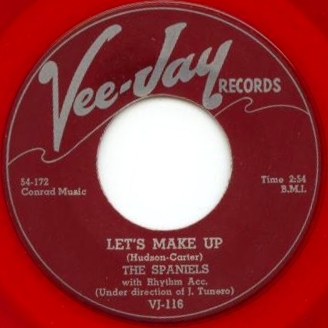
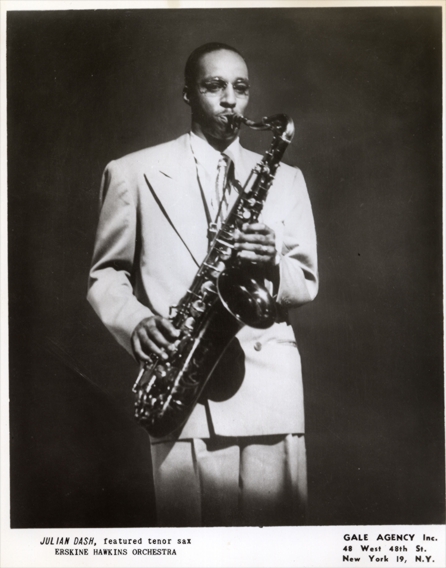
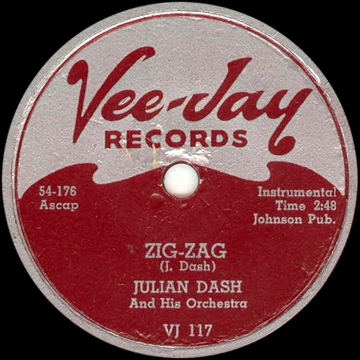
When tenor sax player Julian Dash joined Vee-Jay in 1954 for his first recording session, he had already achieved fame as a long-time member of the great Erskine Hawkins band. Joining Hawkins in 1938, Dash played on such hits as "After Hours" and "Tuxedo Junction." He was born St. Julian Bennett Dash, on April 9, 1916, in Charleston, South Carolina. Before the Vee-Jay sessions, Dash had recorded under his own name for Mello-Roll (1950), Signature, Sittin' in With (1951), Mercury (1951), and Coral. Dash cut for Vee-Jay with his working group: Hank Marr (piano), Warner E. Stephens (electric guitar), Lee Stanfield (bass), and Bill English (drums). From his four-number session in August, Vee-Jay released one single in November, "Zig-Zag" backed with "So Let It Be," but neither side found an audience. According to Dr. Robert Stallworth and Tom Kelly, both 78 and 45 rpm releases of Vee-Jay 117 suffer from reversed labels.
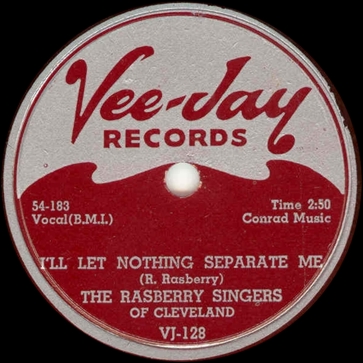
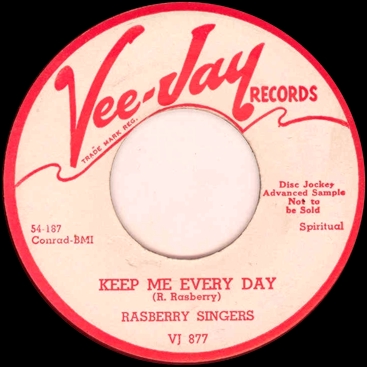
Raymond Rasberry, who played piano and sang, was one of the most significant gospel songwriters in the post-World War II era. He was born Waymon Raymond Rasberry Jr., on March 10, 1930, in Akron, Ohio. He learned to play the piano by ear when he was 8 years old and gained experience accompanying the congregation at his Pentecostal church. After accompanying Wynona Carr, Mahalia Jackson, and Clara Ward, he started the Rasberry Singers, a group of five men, not long before this session. The Rasberry Singers were national stars and toured regularly from their base in Cleveland. Carl Hall, who is identified as a soloist on one side from the Rasberry Singers' first session, was considered one of the top male sopranos in gospel during the period; we do not know the names of the other singers.
The Rasberry Singers got their session in September 1954. According to Cash Box (March 12, 1955, p. 23), "Seems the Rasberry Singers heard about the fact that VJ co-prexy Viv Carter was a disc jockey and brought their tapes for her to hear." Vee-Jay 128 was released in March, in the company's third batch for 1955. The record was advertised in Cash Box on March 12, 1955 (p. 29), along with two doowop records (127 the El Dorados and 129 by the Five Echoes) and another gospel release (130 by the Boyer Brothers. Two other sides from the session eventually appeared on Vee-Jay 877, after the gospel releases veered off from the main Vee-Jay series at 243/843.
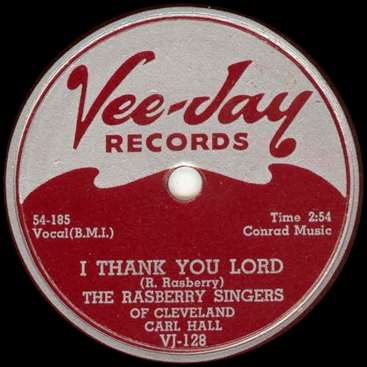
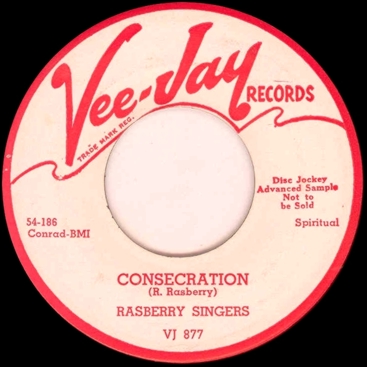
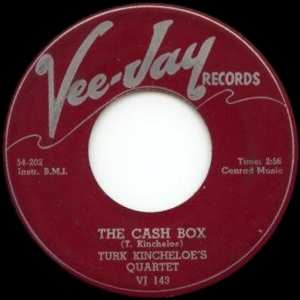
The Turk Kincheloe Quartet, which recorded in October, was a jazz ensemble. The band was led by a pianist, Stuart G. Kincheloe (born in Charleston, West Virginia, on April 13, 1934). At the time he was going as Turk Kincheloe. At age 18, Kincheloe was already active in Chicago, as a member of Duke Groner's trio. The band was working Marty's Hi-Note on Howard Street, and the gig got a mention in the Chicago Sunday Tribune (November 9, 1952, part 7 p. 2). The entertainment columnist, who couldn't spell Kincheloe's last name, thought they were producing "some weird jazz interpretations," in part because Luther Jones was doubling on guitar and bongos. We should note that the guitarist, bassist, and drummer on Kincheloe's Vee-Jay session have not been identified.
Six tracks were laid down. Two contrasting sides saw release eight months later, in June 1955 (the company advertised the single in Cash Box on June 25, p. 24, along with Vee-Jay 141 by Tommy Dean and 142 by Big Jay McNeely). Vee-Jay 143 is a tough record to find today. "Modern Trend," as the title suggested, was a fluent bop number featuring Kincheloe's piano. "The Cash Box" was pointed straight at the jukebox market; Kincheloe played organ with one hand and piano with the other, on a blues with a whomping backbeat. Vee-Jay didn't just have jukebox routes in mind; it let everyone know that the piece was being named after the juke box operators' magazine (officially, The Cash Box). As that very periodical had it, it was "'Cause, they say, they feel we here have been their friends" (Cash Box, March 5, 1955, p. 25). Cash Box had indeed been running a lot of favorable coverage on Vee-Jay. This didn't prevent a three-month delay in releasing the record, till the last week of May. The diplomatic explanation (June 4, 1955, p. 23) was that "The Cash Box" had been held for the magazine's 13th anniversary, in June 1955. A short article by Vivan Carter ("Rhythm and Blues Has Definitely Not Hit the Skids," Cash Box, July 2, 1955, p. 67) made sure to mention the dedication.
Tommy Dean, whose first release was already out in January 1955, became the company's go-to artist for organ and piano with a whomping backbeat. But when Vee-Jay's Abner subsidiary was revived in 1962, the first Abner single in the 7000 series coupled two R&B instrumentals probably intended for use as interludes on the radio. "The Cash Box" fit right in, despite being 8 years older than the Bill Sheppard number it was paired with.
Kincheloe accompanied The Dells on their "Oh What a Nite" session (May 1956) and recorded another jazz session for Vee-Jay in July 1956, as a member of Duke Groner's aggregation. He subsequently accompanied Billie Holiday, Della Reese (1957-1959), and Sarah Vaughan (1961-1963). Changing his marquee name to Kirk Stuart, he recorded with Reese for Jubilee in 1958 (including an LP supposedly done live at Mister Kelly's in Chicago, and a gospel LP done in Detroit). While Sarah Vaughan was under contract to Roulette, she did her sessions with large studio orchestras, but in July 1963, Mercury recorded her with her touring trio (Kirk Stuart, piano; Charles Williams, bass; George Hughes, drums) at a club in Copenhagen, generating several CDs worth of material. In the early 1960s, Stuart was still leading jazz combos in the Chicago area. He recorded with Al Grey in New York in 1965. He subsequently moved to Los Angeles, recording there with Della Reese for ABC-Paramount in June 1967. For years, Stuart led a trio that backed singers, notably Joe Williams, but he also worked as an arranger and played in other jazz bands. He caught work in Las Vegas, and taught for a while at Howard University. Not long after a final appearance with Joe Williams in Washington, DC, Kirk Stuart died on December 17, 1982, on the operating table during surgery on his spleen.
On Kincheloe's session, Big Miller was featured on two jazz vocal sides with the group. Both the guitarist and the leader (playing organ on "Shop" and organ and piano together on "Crazy Donna Lee") are easily recognizable.
Clarence Horatio Miller (middle name sometimes rendered as "Horatius") was born in Sioux City, Iowa, on December 18, 1922, and grew up in Topeka, Kansas. He played trombone and string bass and got his first full-time job in Jay McShann's band. But it was as a blues shouter that he was mainly known.
Miller was in his 30s before he got a chance to record anything under his own name. His powerful but agile bass-baritone was getting some exposure in the Chicago clubs during 1954—in October, the Crown Propeller Lounge was promoting his "sensational blues"—and clearly this is what led Jimmy Bracken and Vivan Carter to sign him. The really gone bebop scatting on "Shop" must have scared them off issuing his sides. That was too bad, because Miller was as capable with lyrics in English ("Crazy Donna Lee") as with nonsense syllables. Miller's two Vee-Jay tracks lay unissued till 2006, when they finally appeared on a Charly download collection titled Blues Classics: Blues Get off My Shoulder. Meanwhile, Kincheloe's two other instrumentals are still unreleased after all these years.
After failing to score a release on Vee-Jay, Big Miller appears to have moved his base of operations to New York City. As soon as his Vee-Jay contract expired, he signed with Savoy, cutting two sides ("All Is Well" b/w "Try to Understand") on November 10, 1955 with backing by a doowop group, The 5 Pennies (for more see Marv Goldberg, "The 5 Pennies," at http://www.uncamarvy.com/5Pennies/5pennies.html). In October 1958, Miller sang on two tracks of Bob Brookmeyer's Count Basie LP for United Artists, Kansas City Revisited, which featured Al Cohn and Paul Quinichette. "A Blues" incorporates a tiny bit of the scatting he had employed on "Shop." The liner notes (pardonably) declared the album to be his recording debut. The Kansas City album led to appearances on two more United Artists LPs in 1959: one with Rex Stewart's Fletcher Henderson reunion band, the other a solo outing, Did You Ever Hear the Blues?. He recorded two LPs for Columbia in the early 1960s.
In the 1970s, Big Miller went on tour with Big Joe Turner, then moved to Edmonton, Alberta, where he spent the rest of his life. He recorded with bands led by Tommy Banks, and was a major contributor to the Edmonton Jazz Society. He died in Edmonton on June 9, 1992.
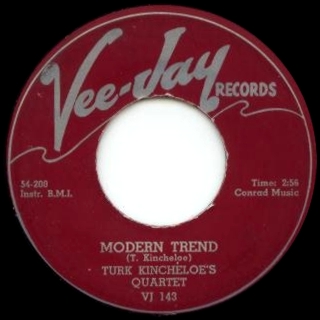
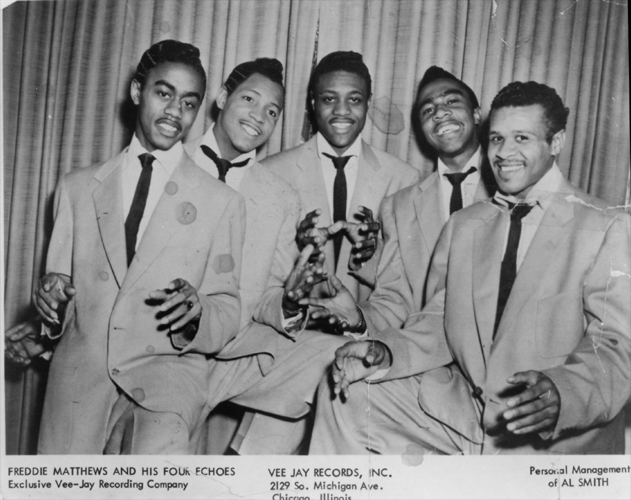
The Five Echoes were one of the many acts that migrated over to Vee-Jay as Chance wound down its business (it would close for good in December 1954). During their Chance years, the Five Echoes included such luminaries as Johnnie Taylor and Tommy Hunt. By the time of the Vee-Jay session, Hunt was gone, and the members consisted of Earl Lewis (first tenor); Johnnie Taylor (second tenor); Constant "Count" Sims (baritone); Herbert Lewis (baritone); Jimmy Marshall (bass). Taylor appears to be the lead on the jumps "Tell Me Baby" and "Tastee Freeze, and the blues "Evil Woman." A different lead was used on the two blues ballads, "I Really Do" and "Fool’s Prayer."
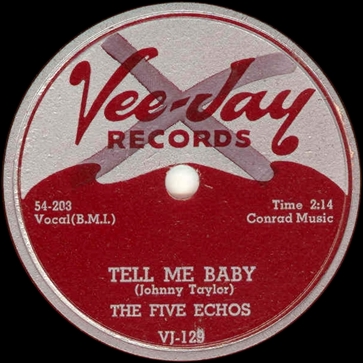
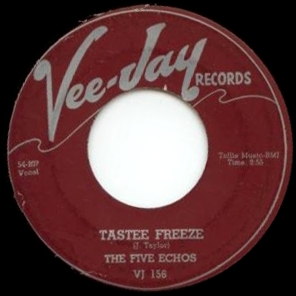
The group was backed by the Al Smith band. The Al Smith combo also recorded on October 28 and 31, 1954, with singer Hazel McCollum, but everything was rejected and no matrix numbers were assigned; most likely the titles with the Five Echoes were done on October 31. Making one of his few appearances on an Al Smith-led session, Harold Ashby gets unmistakable tenor sax solos on "Evil Woman," "Tell Me Baby," "Fool’s Prayer," and "Tastee Freeze," plus a brief tag at the end of "I Really Do." Mac Easton's baritone sax is relegated to a secondary role. Lefty Bates has guitar solos on "I Really Do" and "Tastee Freeze," and Vernel Fournier’s drumming is clearly apparent. In all, the session shows off the Al Smith group with Harold Ashby to advantage; even Al’s elementary bass playing (if it is Al on this session, and not Quinn Wilson) is flattered by the recording process.
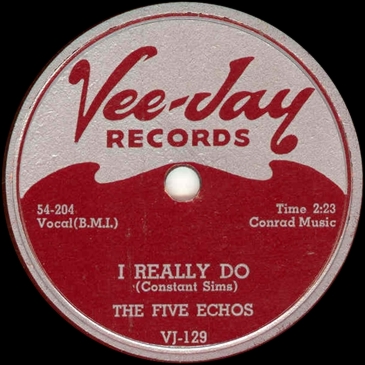
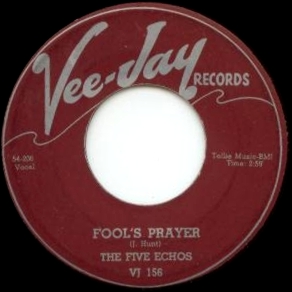
Collectors beware: The so-called "Five Echoes" who appear on a phony "Vee-Jay 190" are not the Five Echoes of Chance and Vee-Jay fame. The group that appears on this bootleg was called just the Echoes; their songs originally appeared on an obscure EP on the EP 4 Hits label number 11. The name Five Echoes and the Vee-Jay label were used to "enhance" the bootleg. The real Vee-Jay 190 is an Arnett Cobb release (see below, under 1956). The Cobb single is so rare that the perpetrator of the bogus Five Echoes 45 picked a number he thought had never been used for a Vee-Jay release.
When nothing happened with the two genuine Five Echoes releases—the group had no teen appeal—Vee-Jay dropped the group, which never recorded again. Lewis insisted to interviewer Robert Pruter that the group stayed together until the end of the decade. That seems unlikely. The Five Echoes probably became moribund in 1956, when Tommy Hunt, who had returned to them for a time, left again to join the Flamingos.
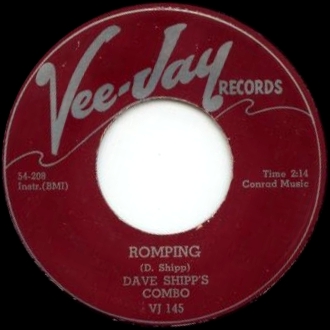
The one Vee-Jay session by Dave Shipp's Combo featured an extraordinary array of jazz talent—David Shipp (bass), Melvin Moore (trumpet), Porter Kilbert (tenor sax), Andrew Hill (piano), and William Hobbs (drums), playing top-quality bebop. Two sides were released in 1955 on Vee-Jay 145; the other two had to wait till 1961, when they were included on a Top Rank LP compiled by Kurt Mohr. Andrew Hill said that this session was his first recording opportunity. The Shipp session, taped on November 4, 1954, looks to a casual reader of the matrix number series to have been shared with the Rhythm Aces. However, the Aces appear to have used different accompaniment (the tenor saxophonist on their sides doesn't sound at all like Kilbert), and there is an uncomformity in the master number series that suggests that the ledgers weren't being kept up to date. A further sign of confusion: a CD reissue of Vee-Jay material included "Let's Live" from this session but gave it the title of another track, "Swinging Easy." But then the Vee-Jay Master Book gives both titles for 54-214.
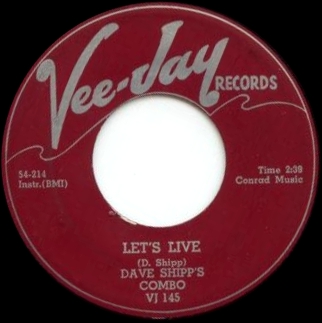
During the 1970s, Shipp played in the Von Freeman Quartet—along with John Young (piano) and Wilbur Campbell (drums)—and appeared on three of Freeman’s albums. Lord's Jazz Discography mentions these LPs but not his Vee-Jay single.
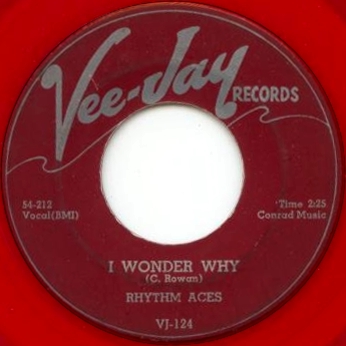
The Rhythm Aces were not a rhythm and blues group as such. Their style actually harked back to the 1940s and was a type of vocal jazz. The group was formed in Germany around 1950, where the members were stationed as soldiers in the U.S. Army. Members were Billy Steward (first tenor), Chuck Rowan (second tenor), Clyde Rhymes (baritone), and Vic House (baritone/bass). House and Rowan were cousins. Upon their discharge in 1954, the Rhythm Aces decided to make a go of it in the entertainment world, and started a tour in the Midwest. When they hit Chicago, they went to the Crown Propeller Lounge and replaced the Moonglows. This was in October 1954. Ewart Abner, who was still officially with Chance, saw the group and signed them up for Vee-Jay. Their session apparently took place in November 1954, with accompaniment by unidentified tenor sax, piano, electric guitar, bass, and drums. The Aces' first release was "I Wonder Why," which is the best example of the their modern harmony approach, a beautiful ballad where the emphasis is on the entire group singing in harmony as opposed to the R&B style of lead vocals backed by riffing from the other members.
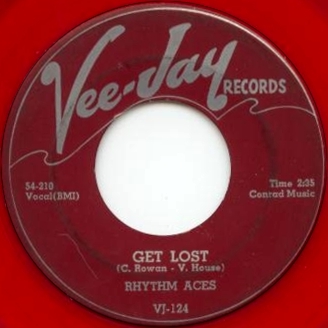
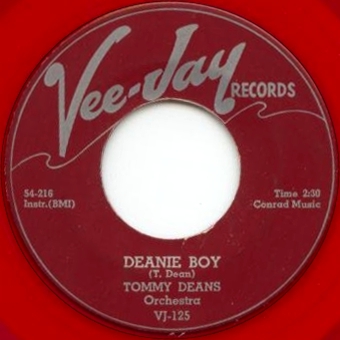
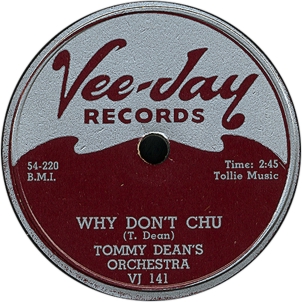
Pianist Tommy Dean was born in Franklin, Louisiana, on September 6, 1909, and grew up in Beaumont, Texas. By the time he reached adulthood he was a full-time musician. During much of the 1930s he worked in carnivals and circuses, then near the end of the decade was hired by the Eddie Randle Band in St. Louis. He eventually left Randle and formed his own band, and by 1945 was working the clubs in Chicago. Before he joined Vee-Jay, Tommy Dean recorded for Town & Country in St. Louis, and Miracle, States, and Chance in Chicago. His band for Vee-Jay included Oliver Nelson (alto sax), Chuck Tillman (tenor sax), Arthur Burnside (bass), Edgar Plaes (drums), and Joe Buckner (a blues singer who was born in St. Louis in 1924). The group's first session, in December 1954, yielded two outstanding Buckner-led bluesy ballads "Eventime" and "How Can I Let You Go," plus "Why Don't Chu," a light R&B workout where the group sings ensemble, and an instrumental, "Deanie Boy."
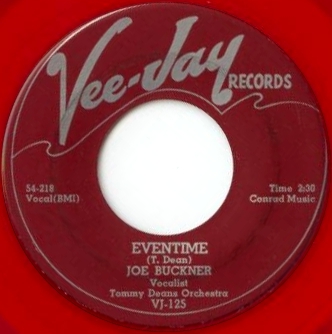
Vee-Jay 125 was given priority treatment. It was released in January 1955, in a batch with Vee-Jay 120, 121, 122, and 124 (jointly advertised in Cash Box on January 22, 1955, p. 29). As Vee-Jay 124 (by the Rhythm Aces) and Vee-Jay 125 quickly outpaced Vee-Jay 120, 121, and 122 in sales, the company began advertising just 124 and 125; for instance, in Cash Box on February 12, 1955 (p. 35). Vee-Jay 125 was reviewed in Cash Box on February 5 (p. 28). Vee-Jay kept buying ads for the record, though they got shorter and just "Eventime" and Joe Buckner's name were mentioned.
Vee-Jay 141 came out on 78 and 45 in June 1955. Ewart Abner was telling Cash Box about it on June 18, 1955 (p. 31); it was advertised in Cash Box on June 25 (p. 24) and again on July 9, 1955 (p. 27). The review arrived on July 23 (Cash Box, p. 42); in the same issue the single was advertised one more time (p. 40), along with 146 by Billy Boy Arnold.
Vee-Jay 339 (a marketing experiment of some sort, on which "Deanie Boy" was retitled "The Horse") was a 45-rpm single released in 1960.
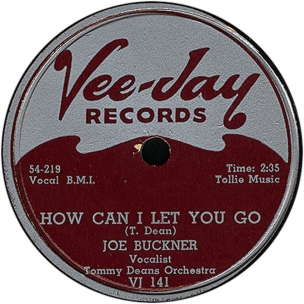
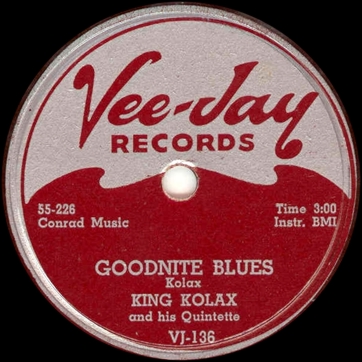
Trumpet player and occasional blues singerKing Kolax was born William Little in Kansas City, November 6, 1912, and grew up in Chicago. He began leading bands in 1936. Through much of the 1940s Kolax-led big bands (after 1947, small combos) were touring nationwide and performing regularly in Chicago clubs. Kolax may have recorded one single in 1947 with his last big band, in Los Angeles for the Miltone label; this still needs verifying. Kolax definitely recorded under his own name for Opera (probably 1948), followed by a session as a leader for JOB (1951). In 1953, Kolax and his combo did studio work for Chance, where they backed the Flamingos on a couple of key sessions.
In December 1954, just after Chance closed its doors, King Kolax was invited to record for the new label. But he got only two sessions out of Vee-Jay, and just one single. The session on December 22 produced at least 8 tracks when complete alternate takes are included. Vee-Jay 136, released around June of 1955, paired a late-night blues with a Latin exotica number, named after Vivian Carter, that features an outstanding tenor sax solo from Harold Ousley.
Even an obvious R&B number like "Right Now" would not see release until 1962, when Kurt Mohr put it on a Top Rank LP of Vee-Jay material titled Jazzville Chicago Volume 2, and some items did not become publicly available until they were made available for download in 2006. Nor did his band get further opportunities to accompany vocal acts: Al Smith, Lefty Bates, and Red Holloway had those assignments sewed up.
Kolax’s band on Vee-Jay consisted of himself (trumpet and vocals), Harold Ousley (tenor sax), Prentice McCarey (piano), "Cowboy" Martin (bass), Leon Hooper (drums), and Grant Jones (vocals). Kolax was using Sun Ra as an arranger during this period, and "Vivian" as though it could have been lifted from the Arkestra's repertoire.
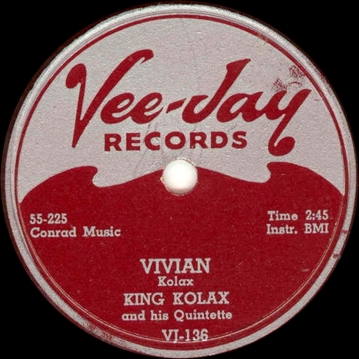
During 1954, Vee-Jay recorded 103 tracks, and released another 6 sides that had been acquired from outside sources. One matrix number was left blank. While the company started out slowly in the three months of the year, the huge Spaniels hit, "Goodnite Sweetheart, Goodnite," in April made it possible for Vee-Jay to book a lot more studio time in the the second half of 1954. New releases did not accelerate nearly as much, with 15 coming out during the year: Vee-Jay 105 through 119.
| 53-128 | Floyd Jones and Band | School Days (On My Mind) | Vee-Jay 111 | Feb 3, 1954 | July 1954 |
| 53-129 on 45 52-129 [sic] on 78 |
Floyd Jones and Band | Ain’t Times Hard | Vee-Jay 111 | Feb 3, 1954 | July 1954 |
| 53-130 | Floyd Jones and his Orchestra | Floyd's Blue | Vee-Jay 126 | Feb 3, 1954 | Mar 1955 |
| 53-131 | Floyd Jones and his Orchestra | Any Old Lonesome Day | Vee-Jay 126 | Feb 3, 1954 | Mar 1955 |
| 53-132 | Sunnyland Slim | Trouble of My Own | (Classics CD 5171) | Feb 3, 1954 | |
| 53-133 | Sunnyland Slim | Worried about My Baby | (Classics CD 5171) | Feb 3, 1954 | |
| 53-134 | Sunnyland Slim | I Done You Wrong | (Classics CD 5171) | Feb 3, 1954 | |
| 53-135 | Sunnyland Slim | Be My Baby | (Classics CD 5171) | Feb 3, 1954 | |
| 53-136 | Eddie Taylor | Steady Pistol | unissued | Feb 3, 1954 | |
| 53-137 | Eddie Taylor | Stroll Out West | unissued | Feb 3, 1954 | |
| 53-138 | Brother Isaiah’s Church of God in Christ Choir (Soloist: Lorenza Brown) | Old Camp Ground | Vee-Jay 109 | April 11, 1954 | c. Aug 1954 |
| 54-139 | Brother Isaiah’s Church of God in Christ Choir (Soloists: Jerry Jordan Clara Mae Stevenson) | Climbing High Mountains | Vee-Jay 140 | April 11, 1954 | May 1955 |
| 54-140 | Brother Isaiah’s Church of God in Christ Choir (Soloist: Lorenza Brown) | The Fountain | Vee-Jay 140 | April 11, 1954 | May 1955 |
| 54-141 | Brother Isaiah’s Church of God in Christ Choir (Soloist: Lorenza Brown) | All Night, All Day | Vee-Jay 109 | April 11, 1954 | c. Aug 1954 |
| 53-142 [sic] 54-142 |
The Lockhart Singers | Feed Me till I Want No More | Vee-Jay 139 | April 11, 1954 | May 1955 |
| 53-143 [sic] 54-143 |
The Lockhart Singers | I Want to Be a Christian | Vee-Jay 139 | April 11, 1954 | May 1955 |
| 53-144[sic] 54-144 |
The Lockhart Singers (Esther Lockhart, Soloist) | E. Robinson, Piano | Own Me as a Child | Vee-Jay 110 | April 11, 1954 | Aug 1954 |
| 53-145[sic] 54-145 |
The Lockhart Singers (Esther Lockhart, Soloist) | E. Robinson, Piano | Walking up the King’s Highway | Vee-Jay 110 | April 11, 1954 | Aug 1954 |
| 54-146 | Singing Sammy Lewis | The Crown Prince of Gospel Singers | Will I Find Peace (Lord Will I Find Peace Someday) | Vee-Jay 114 | April 11, 1954 | Oct 1954 |
| 54-147 | Singing Sammy Lewis | The Crown Prince of Gosel Singers | Jesus Is All the World to Me | Vee-Jay 114 | April 11, 1954 | Oct 1954 |
| 54-148 | Holy Gospel Singers | In the Morning When I Rise | unissued | April 11, 1954 | |
| 54-149 | Holy Gospel Singers | Revive Us Again | Vee-Jay 120 | April 11, 1954 | Jan 1955 |
| 54-150 | Holy Gospel Singers | Hold on to God’s Unchanging Hand | unissued | April 11, 1954 | |
| 54-151 | Holy Gospel Singers | Move Up | Vee-Jay 120 | April 11, 1954 | Jan 1955 |
| 54-152 | The Maceo Woods Singers | Jesus Brought Me | unissued | April 14, 1954 | |
| 54-153 | The Maceo Woods Singers | Never Grow Old | Vee-Jay 152 | April 14, 1954 | Oct 1955 |
| 54-154 | The Maceo Woods Singers | My Soul Is Satisfied | unissued | April 14, 1954 | |
| 54-155 | The Maceo Woods Singers | In the Sweet Bye and Bye | Vee-Jay 152 | April 14, 1954 | Oct 1955 |
| 54-156 | Pro McClam and His Orchestra | All Righty | unissued | June 30, 1954 | |
| 54-157 | Pro McClam and his Orchestra | Please Leave Her Alone | Vee-Jay 112 | June 30, 1954 | Oct 1954 |
| 54-158 | Pro McClam and His Orchestra | Why Don’t You Pretty Baby | unissued | June 30, 1954 | |
| 54-159 | Pro McClam and his Orchestra | Cinemascope Baby | Vee-Jay 112 | June 30, 1954 | Oct 1954 |
| 54-160 | Floyd Valentine and his Orchestra | Off Time | Vee-Jay 113 | June 30, 1954 | Sept 1954 |
| 54-161 | Floyd Valentine and his Orchestra | Fussin and Lovin | Vee-Jay 113 | June 30, 1954 | Sept 1954 |
| 54-162 | The El Darados [sic] and rythm acc. / The El Dorados and rythm acc. | My Loving Baby | Vee-Jay 115 | June 30, 1954 | Aug 1954 |
| 54-163 | The El Darados [sic] / The El Dorados | Baby I Need You | Vee-Jay 115 | June 30, 1954 | Aug 1954 |
| 54-164 | |||||
| 54-165 | Willie Jones | Betty’s Mambo | unissued | June 30, 1954 | |
| 54-166 | Willie Jones | Willie’s Blues | unissued | June 30, 1954 | |
| 54-167 | Willie Jones | My Thing | Vee-Jay 121 | June 30, 1954 | Jan 1955 |
| 54-168 | Willie Jones | My Other Thing | Vee-Jay 121 | June 30, 1954 | Jan 1955 |
| 54-169 | Spaniels | unidentified title | rejected | c. July 24, 1954 | |
| 54-170 | Spaniels | unidentified title | rejected | c. July 24, 1954 | |
| 54-171 | Spaniels | Danny Boy | rejected | c. July 24, 1954 | |
| 54-172 | The Spaniels with Rhythm Acc. (Under direction of J. Tunero) | Let’s Make Up | Vee-Jay 116 | c. July 24, 1954 | Oct 1954 |
| 54-173 | The Spaniels with Rhythm Acc. | Play It Cool | Vee-Jay 116 | c. July 24, 1954 | Oct 1954 |
| 54-174 | The Spaniels | Danny Boy | (Vee-Jay NVD2-714) | c. July 24, 1954 | |
| 54-175 | Julian Dash and His Orchestra | Dash Is It | unissued | Aug 13, 1954 | |
| 54-176 | Julian Dash and His Orchestra | Zig-Zag | Vee-Jay 117 | Aug 13, 1954 | Nov 1954 |
| 54-177 | Julian Dash and His Orchestra | So Let It Be | Vee-Jay 117 | Aug 13, 1954 | Nov 1954 |
| 54-178 | Julian Dash and His Orchestra | Mambo | unissued | Aug 13, 1954 | |
| 54-179 | The El Dorados | One More Chance | Vee-Jay 127 | Sept 8, 1954 | Mar 1955 |
| 54-180 | The El Dorados | Little Miss Love | Vee-Jay 127 | Sept 8, 1954 | Mar 1955 |
| 54-181 | Al Smith Combo | Vocal: Hazel McCollum and The El-Dorados | Annie’s Answer | Vee-Jay 118 | Sept 8, 1954 | Nov 1954 |
| 54-182 | Al Smith Combo | Living with Vivian | Vee-Jay 118 | Sept 8, 1954 | Nov 1954 |
| 54-183 | The Rasberry Singers of Cleveland | I’ll Let Nothing Separate Me | Vee-Jay 128 | Sept 1954 | Mar 1955 |
| 54-184 | Rasberry Singers | Will You Answer | unissued | Sept 1954 | |
| 54-185 | The Rasberry Singers of Cleveland | Carl Hall | I Thank You Lord | Vee-Jay 128 | Sept 1954 | Mar 1955 |
| 54-186 | Rasberry Singers | Consecration | Vee-Jay 877 | Sept 1954 | 1959 |
| 54-187 | Rasberry Singers | Keep Me Every Day | Vee-Jay 877 | Sept 1954 | 1959 |
| 54-188 | Maceo Woods at the Hammond Organ | Amazing Grace | Vee-Jay 122 | Sept 1954 | Jan 1955 |
| 54-189 | Maceo Woods at the Hammond Organ | Leaning on the Everlasting Arm | Vee-Jay 122 | Sept 1954 | Jan 1955 |
| 54-190 | Maceo Woods Singers | I’ve Got a New Born Soul | (Vee-Jay LP 5053) | Sept 1954 | |
| 54-191 | Maceo Woods Singers | There Is No Time to Lose | (Vee-Jay LP 5053) | Sept 1954 | |
| 54-192 | Maceo Woods Singers | I'll Be Somewhere Listening | (Vee-Jay LP 5053) | Sept 1954 | |
| 54-193 | Maceo Woods Singers | Jesus Is on the Main Line | unissued | Sept 1954 | |
| 54-194 | Maceo Woods Singers | My Soul Is Satisfied | unissued | Sept 1954 | |
| 54-195 | Singing Sammy Lewis | Jesus Was the One | Vee-Jay 123 | Oct 15, 1954 | Feb 1955 |
| 54-196 | Singing Sammy Lewis | It's a Mighty Hard Road | Vee-Jay 123 | Oct 15, 1954 | Feb 1955 |
| 54-197 | Big Miller | Crazy Donna Lee | (Charly download) | ||
| 54-198 | Big Miller | Shop | (Charly download) | ||
| 54-199 | Turk Kincheloe Quartet | Process | unissued | ||
| 54-200 | Turk Kincheloe's Quartet | Modern Trend | Vee-Jay 143 | May 1955 | |
| 54-201 | Turk Kincheloe Quartet | 201 Blues | unissued | ||
| 54-202 | Turk Kincheloe's Quartet | The Cash Box | Vee-Jay 143 Abner A7001 |
May 1955 1962 |
|
| 54-203 | The Five Echos [sic] | Tell Me Baby | Vee-Jay 129 | Oct 31, 1954 | Mar 1955 |
| 54-203 [alt.] | Five Echoes | Tell Me Baby [alt] | (Vee-Jay NVD2-715 [CD]) | Oct 31, 1954 | |
| 54-204 | The Five Echos [sic] | I Really Do | Vee-Jay 129 | Oct 31, 1954 | Mar 1955 |
| 54-204 [alt.] | Five Echoes | I Really Do [alt] | (Vee-Jay NVD2-709 [CD]) | Oct 31, 1954 | |
| 54-205 | Five Echoes | Evil Woman | (Vee-Jay NVD2-709 [CD]) | Oct 31, 1954 | |
| 54-206 | The Five Echos | Fool’s Prayer | Vee-Jay 156 | Oct 31, 1954 | Oct 1955 |
| 54-206 [alt.] | Five Echoes | Fool’s Prayer [alt] | (Vee-Jay NVD2-715 [CD]) | Oct 31, 1954 | |
| 54-207 | The Five Echos | Tastee Freeze | Vee-Jay 156 | Oct 31, 1954 | Oct 1955 |
| 54-208 | Dave Shipp’s Combo | Romping | Vee-Jay 145 | Nov 4, 1954 | c. Aug 1955 |
| 54-209 | Dave Shipp’s Combo | Swinging Easy | (Top Rank RLP 111) | Nov 4, 1954 | |
| 54-210 | Rhythm Aces | Get Lost | Vee-Jay 124 | Nov 4, 1954 | Jan 1955 |
| 54-211 | Rhythm Aces | I Realize Now | unissued | Nov 4, 1954 | |
| 54-212 | Rhythm Aces | I Wonder Why | Vee-Jay 124 | Nov 4, 1954 | Jan 1955 |
| 54-213 | Rhythm Aces | That's My Sugar | unissued | Nov 4, 1954 | |
| 54-214 | Dave Shipp’s Combo | Let’s Live | Vee-Jay 145 | Nov 4, 1954 | c. Aug 1955 |
| 54-215 | Dave Shipp’s Combo | Nick’s Dance | (Top Rank RLP 111) | Nov 4, 1954 | |
| 54-216 | Tommy Deans Orchestra | Deanie Boy The Horse* |
Vee-Jay 125 Vee-Jay 339* |
Dec. 20, 1954 | Jan 1955 1960* |
| 54-217 | Tommy Dean Orchestra | Just before Day | (Vee-Jay NVD2-716 [CD]) | Dec 20, 1954 | |
| 54-218 | Joe Buckner Vocalist | Tommy Deans Orchestra | Eventime | Vee-Jay 125 | Dec 20, 1954 | Jan 1955 |
| 54-219 | Joe Buckner, Vocalist | Tommy Deans Orchestra | How Can I Let You Go | Vee-Jay 141 | Dec 20, 1954 | June 1955 |
| 54-220 | Tommy Dean’s Orchestra | Why Don’t Chu? | Vee-Jay 141 | Dec 20, 1954 | June 1955 |
| 54-221 | Tommy Dean Orchestra | 221 Rock | (Vee-Jay NVD2-716 [CD]) | Dec 20, 1954 | |
| 54-222 | Grant Jones with King Kolax and his Quintette | What Have You Done to Me | (Charly CRB 1043) | Dec 22, 1954 | |
| 54-223 | Grant Jones with King Kolax and his Quintette | Right Now | (Top Rank [Fr] RLP 111) | Dec 22, 1954 | |
| 54-223 [alt.] | Grant Jones with King Kolax and his Quintette | Right Now | (Charly CRB 1043) | Dec 22, 1954 | |
| 54-224 | King Kolax and his Quintette | Push Out | (Charly download) | Dec 22, 1954 | |
| 55-225 | King Kolax and his Quintette | Vivian | Vee-Jay 136 | Dec 22, 1954 | c. Jun 1955 |
| 55-225 [alt.] | King Kolax and his Quintette | Vivian | (Charly download) | Dec 22, 1954 | |
| 55-226 | King Kolax and his Quintette | Goodnite Blues | Vee-Jay 136 | Dec. 22, 1954 | c. Jun 1955 |
| 55-226 [alt.] | King Kolax and his Quintette | Goodnite Blues | (Charly CRB 1043) | Dec. 22, 1954 |
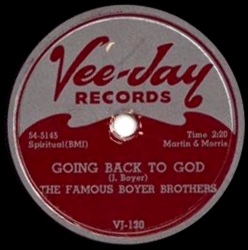
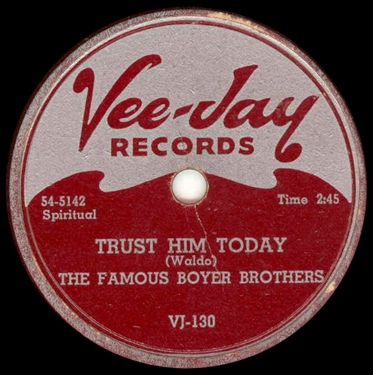
Unlike its Chicago rival Chess, in its early years Vee-Jay did not pick up a lot of outside productions for its release schedule. In 1954, however, the company acquired a Famous Boyer Brothers session originally done in July for Chance, with Alex Bradford on piano and Gerald Spraggins at the organ. Art Sheridan and Ewart Abner were at this time already closely working with Vivian and James Bracken, and for some reason decided that the Famous Boyer Brothers should be added to the Vee-Jay release schedule.
Vee-Jay 130, a straight-up reissue of Chance 5009, was released in March 1955 (mentioned in Cash Box on March 5, p. 23, advertised on March 12, p. 29, along with Vee-Jay 128 by the Raymond Rasberry Singers). Vee-Jay 163, which paired one of the previously unissued Chance sides with one recorded by the brothers in June 1955, came out in December 1955. The last of the four Chance sides appeared on Vee-Jay 209, in October 1956.
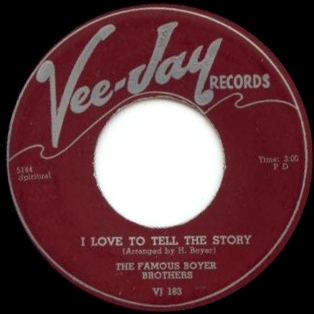
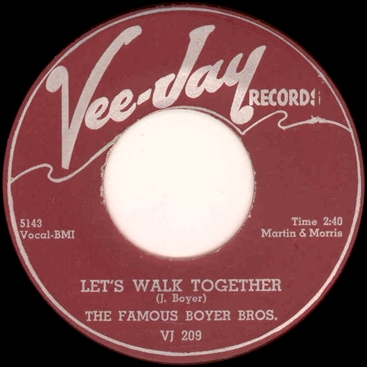
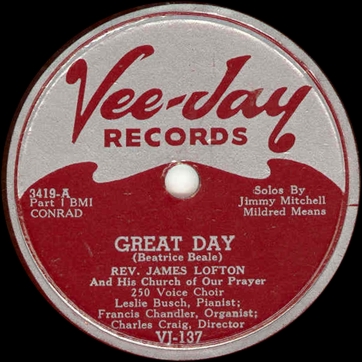
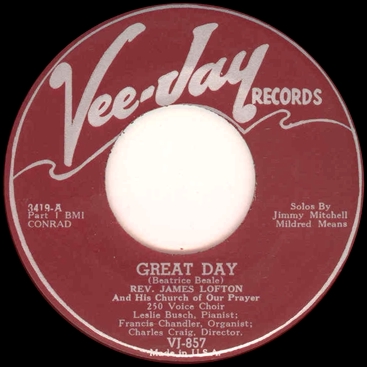
Later in the year, the company purchased two sides by Reverend James Lofton’s Choir—a two-part hymn called "Great Day." The full name of the organization was Reverend James Lofton and His Church of Our Prayer 250 Voice Choir. With credits to Leslie Busch for piano and Francis Chandler for organ, to Charles Craig for directing the choir, and to Jimmy Mitchell and Mildred Means for vocal solos, the label of Vee-Jay 137 filled up with fine print. A listen to the sides indicates that they were recorded live in the church, probably for radio broadcast.
Vee-Jay 137 was part of a clutch of gospel releases, along with 139 by the Lockhart Singers and 140 by Brother Isaiah's Choir. "Ab" talked them up to Cash Box on May 21, 1955 (p. 21) and the company advertised them in the same issue (p. 22). Vee-Jay 137 got its review in Cash Box for July 2, 1955 (p. 62).
Vee-Jay 137 would be re-released later on in Vee-Jay’s 800 gospel series
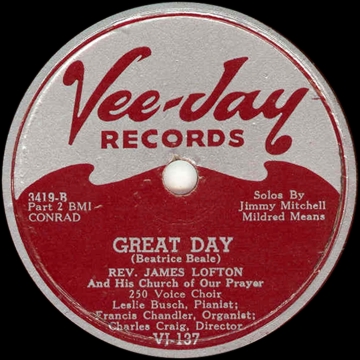
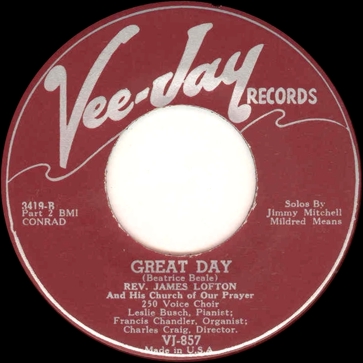
| U5142 54-5142 |
The Famous Boyer Brothers | Trust Him Today | Chance 5009 Vee-Jay 130 |
July 1954 | Mar 1955 |
| U5143 54-5143 |
The Famous Boyer Bros. | Let’s Walk Together | Vee-Jay 209 | July 1954 | Oct 1956 |
| U5144 54-5144 |
The Famous Boyer Brothers | I Love to Tell the Story | Vee-Jay 163 | July 1954 | Dec 1955 |
| U5145 54-5145 |
The Famous Boyer Brothers | Going Back to God | Chance 5009 Vee-Jay 130 |
July 1954 | Mar 1955 |
| 3419-A | Reverend James Lofton and His Church of Our Prayer 250 Voice Choir | Great Day Part 1 | Vee-Jay 137 Vee-Jay 857 |
May 1955 | |
| 3419-B | Reverend James Lofton and His Church of Our Prayer 250 Voice Choir | Great Day Part 2 | Vee-Jay 137 Vee-Jay 857 |
May 1955 |
In late March of 1955 Ewart Abner became the company’s general manager, formalizing a role he'd held silently for a while, maybe since Vee-Jay’s formation in mid-1953. Around the end of June 1955, Vee-Jay followed Chess and other companies north to the record row on Michigan Avenue, just south of Chicago’s downtown—where mainstream companies and distributors had been gathering since after World War II. Vee-Jay established itself at 2129 S. Michigan ("Vee-Jay Records Moves," Cash Box, July 9, 1955, p. 24). From its new, larger offices, the company also began handling its own distribution for Chicago and surrounding areas.
Vee-Jay recorded a full array of talent during the year—jazz, blues, rhythm and blues, doowop, and gospel. An important addition to the company’s jazz line was Wardell Gray, who unfortunately died at age 34, within months of his first recording session with the label. Other jazz acts—perhaps broadly defined—making their debut on Vee-Jay were Baby Face Willette, Jay McShann, and Big Jay McNeely. Three outstanding additions to the gospel lineup were the Highway QC’s, the Famous Boyer Brothers, and the Staple Singers, the latter who would prove the label’s biggest gospel hitmakers. Two significant vocal groups also signed with the company in 1955, the Dells and the Kool Gents.
Vee-Jay in 1955 considerably expanded its stable of blues acts, adding Eddie Taylor (as a reward for his stellar accompaniment to Jimmy Reed), L. C. McKinley, Billy Boy Arnold, Morris Pejoe, Billy "The Kid" Emerson, and the great John Lee Hooker. Outstanding blues stylist Priscilla Bowman joined Vee-Jay when the company signed Jay McShann.
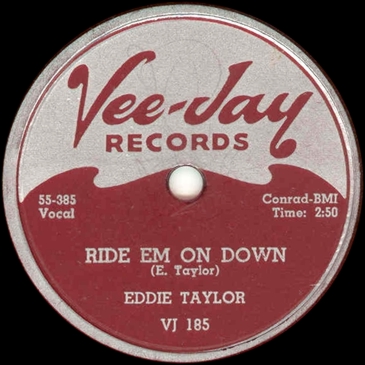
Bluesman Eddie Taylor was born in Benoit, Mississippi, on January 29, 1923. As a youngster he took up guitar. In 1943, he moved to Memphis, and worked in the Beale Street clubs. In 1949 Taylor moved to Chicago, initially playing in Maxwell Street but then moving into the clubs. In 1953 he began working with Jimmy Reed, who was a childhood friend in the Delta. His guitar work played a large role in the success of Jimmy Reed’s records. Taylor had already appeared on the February 1954 sessions with Floyd Jones and Sunnyland Slim, but only the numbers led by Jones were released; two tracks that he sang on were left in the vault. In January 1955, Vee-Jay rewarded Taylor by giving him another chance to record two numbers of his own, on the front end of a Jimmy Reed session. Nothing terrific came out of it for Taylor, though he fared better than Reed, whose three tracks were left in can.
Taylor's two sides, "Bad Boy" and "E. T. Blues," were released in August on Vee-Jay 149. An ad in Cash Box, July 30, 1955, p. 21, plugged the single along with Vee-Jay 147 by the El Dorados and 148 by Morris Pejoe. On August 13, Vee-Jay 149 got a solo ad (p. 23). Then the company forgot about it for a while. It was next advertised on October 1 (Cash Box, p. 32), alongside Vee-Jay 147, now a big hit, Vee-Jay 154 by The Spaniels, which was selling respectably, and Vee-Jay 153 by Jimmy Reed, also doing OK.
Long thought to be lost, Reed's "You Upset My Mind" eventually came out on a Charly LP, and "I'm Gonna Ruin You" from this session showed up by accident on 1992 Vee-Jay reissue CD A Taste of the Blues Vol. 2. The January "Pretty Thing" is still unreleased. The company remade "I'm Going to Ruin You" and "Pretty Thing" on Reed's next session, in March, and chose the later versions for release. According to Dave Sax, who recommended the January version of "I'm Gonna Ruin You" for its second reissue, on a Charly CD, "It's a totally diffferent treatment with Reed taking a more menacing, Willie Mabon-like approach" (email communication, October 2, 2006).
However, when Taylor was given the opportunity to record two songs at the tail end of a Jimmy Reed session in December, with accompaniment by Reed and drummer Ray Scott (we think this was "the other Ray Scott," not Walter Spriggs), he produced the outstanding "Bigtown Playboy." It became Taylor’s signature song.
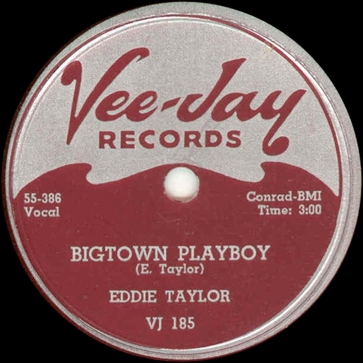
Vee-Jay 185 ("Bigtown Playboy" b/w "Ride em on Down") was released in May 1956; Cash Box reviewed it on May 12 (p. 68) and it was one of 7 singles promoted in a company ad (same issue, p. 64). Subsequent ads ran on May 26 (p. 29) and July 7 (p. 27).
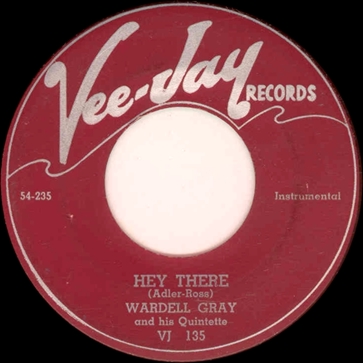
Tenor saxophonist Wardell Gray was born in Oklahoma City on Febuary 13, 1921. He started on clarinet at Cass Tech in Detroit, and began working as a professional musician in that city. Gray was a member of the Lester Young school, who later took on some bebop influences; he played his instrument aggressively with a full tone. He was with Earl Hines from 1943 to 1946, and spent some time in the Billy Eckstine band in 1944. Later he would work with Benny Goodman (1948-49), Tadd Dameron (1948-49), and Count Basie (1948-51). His first recordings with his own band, the Wardell Gray Quartet, were done with Swingtime, in 1946 in Hollywood. His Wardell Gray Quintet playing at Gene Norman’s Just Jazz Concerts in 1947 ended up on the Modern Music label. In late 1948 he was back in the studio, recording his quartet for the Sittin’ in With Label, followed by sessions for Prestige during 1949-52. In the early 1950s he settled in Los Angeles.
His next and last studio recording was done with Vee-Jay on January 19, 1955, featuring accompaniment by Gene Phipps (trumpet), Tate Houston (baritone sax), and the house trio at the Beehive: Norman Simmons (piano), Victor Sproles (bass), and Vernel Fournier (drums). The label designated his group as a quintet. His presence in town got him the session on January 19 and put him on the bill for McKie Fitzhugh's Singing Sax Show and Dance (Cash Box, January 22, 1955, p. 27) at the Pershing Ballroom. Held on January 22, 1955, the event also featured Eddie Chamblee, Leo Parker, and Gene Ammons, joined by three vocal groups—the Five Echoes, the Clouds, and the Fortunes. One of the top jazz musicans of his time, Gray was a model to young Chicago tenor players like Melvin Scott and John Gilmore.
"Oscar's Blues" and "Hey There" were selected for release on Vee-Jay 135, which was reviewed in Cash Box on May 7, 1955 (p. 24).
Wardell Gray died just four months after this session, and a few weeks after his single was released, on May 25, 1955, in Las Vegas. He was apparently the victim of a heroin overdose. He died two months after Charlie Parker, who also played one of his last professional gigs at the Beehive, less than a month after Gray was there.
After Gray's death, the company planned a 45-rpm EP of his "last recorded sides." This would have made room for the sides that had been on Vee-Jay 135 along with the two still unreleased (Cash Box, June 25, 1955, p. 24). The project was dropped, and Vee-Jay would not release an EP until it had adopted the LP (a move the company made in 1957). Another single would probably have worked, but there was none. The other two tracks had to wait till 1962, when Top Rank issued an LP, compiled by Kurt Mohr, of jazz sides that had been recorded for Vee-Jay.
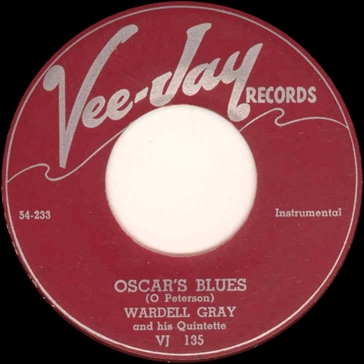
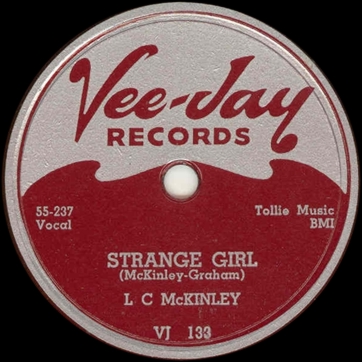
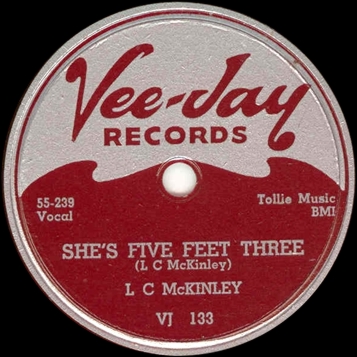
A T-Bone Walker disciple, guitarist L. C. McKinley, was born on 22 October 1918, in Winona, Mississippi, but had relocated to Chicago by 1941. Though his Musicians Union Local 208 membership card and death certificate give only the initials, one of his records bears composer credits to "Larry" McKinley. McKinley did not begin to play professionally until 1947; he joined the union on February 3 of that year. In the early 1950s he was a regular headliner at the famed 708 Club; in 1951 and 1952, he recorded as a sideman with pianist Eddie Boyd for JOB, appearing on Boyd's biggest hit, "Five Long Years." He first recorded as a leader in 1953 for the Parrot label, but label owner Al Benson chose not to release his session. He probably also did some further session work during this period. The guitarist’s next session under his name was with States, in 1954. The following year, he recorded two sessions for Vee-Jay.
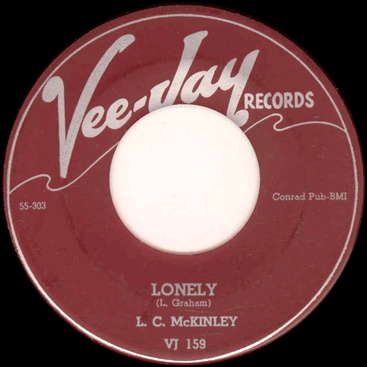
On his January 1955 session, McKinley was accompanied by Red Holloway and Johnny Board on tenor saxes, Bob Call at the piano, James "Hawk" Lee on bass, and Vernel Fournier in the drum chair.
McKinley's first release, Vee-Jay 133, didn't get as much of a buildup in the trades as some of surrounding Vee-Jay releases. It was mentioned in two ads (Cash Box, April 2, 1955, p. 64, and April 9, 1955, p. 26), and snagged a Cash Box review on April 30, 1955 (p. 26). The other two sides from the January session are still unissued.
On McKinley's August session, the saxophonists were John A. Gordon (alto and baritone) and Ernest Cotton (tenor). The rhythm section now consisted of Bob Call (piano), Lafayette Thompkins (bass), and veteran blues drummer Odie Payne, Jr.
Again, two sides were picked for release, on Vee-Jay 159 in November. Cash Box carried an ad for 159 on November 5, 1955 (p. 28), along with 144 and 156 which were new, and 155, which was selling. Another ad, just for the new releases, ran on November 19 (p. 35). The other two sides from August remain unissued.
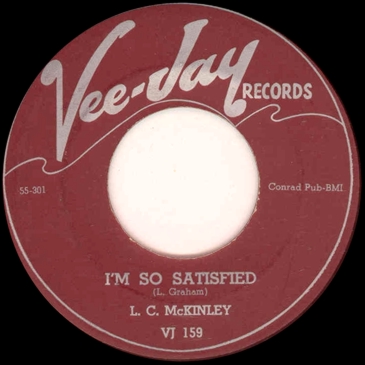
McKinley subsequently recorded for Bea & Baby in 1959, and made a final session for Sunnyland around 1964. When L. C. McKinley died on January 19, 1970, he was working as a presser in a dry cleaning establishment in East Chicago, Indiana.
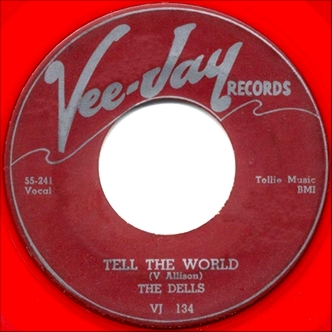
An enigmatic spot in the Vee-Jay matrix list is the session (some sources put it on February 19, 1955) on which two vocal groups, The Spaniels and The Dells, cut three titles with accompaniment by a non-Al Smith group led by Red Holloway. Holloway is instantly recognizable, but who handled the piano, bass, and drums? The Spaniels were responsible for one tune, and The Dells, who had just begun recording for Vee-Jay, for two.
One of the Dells' contributions was left in the can. The other was released on Vee-Jay 134; the flip was an instrumental by Count Morris, which had been sitting around for more than a year after being made at the tail end of the session of December 20, 1953. Vee-Jay 134 was reviewed in Cash Box on May 7, 1955 (p. 24). It doesn't seem to have done anything at the cash register, but the company heard something and was motivated to bring the group back for another session.
The Spaniels' sole contribution, "Don'cha Go," exemplifies street corner singing and nearly rivals "Do-Wah," a side from December 20, 1953 that was chosen as its coupling on Vee-Jay 131. "Don'cha Go" was already being talked up in Cash Box on February 26, 1955 (p. 29), but advertisements didn't follow till April 9 (jointly with Vee-Jay 133 by L. C. McKinley, Cash Box, p. 26), April 23 (jointly with Vee-jay 132 by Jimmy Reed, Cash Box, p. 22), and April 30 (solo ad, p. 28). Cash Box gave Vee-Jay 131 a "Sleeper of the Week" on April 23 (p. 25). In all, the company gave it a hard push, but a listing in "Coming Up in R&B" (Cash Box, May 28, 1955, p. 23, had the record showing promising sales in Chicago, Columbia, South Carolina, Newark, New York City, and St. Louis) marked the peak of its commercial trajectory.
Vee-Jay 134 didn't rattle any cash registers, but the Dells would return for a full session in September, and we will provide background on the group at that point. The Spaniels would be back in July or August.
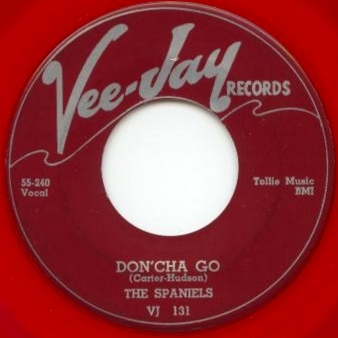
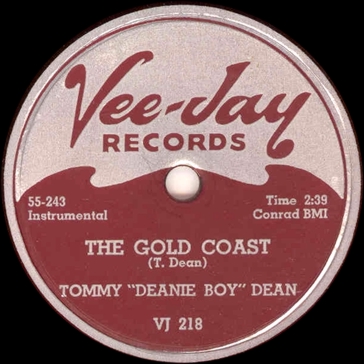
Vee-Jay brought Tommy Dean right back into the studio in February 1955. But for some reason just one track ended up being recorded. "The Gold Coast," an instrumental done by a quartet with Oliver Nelson (alto sax), Archie Burnside (bass), and Edgar Plaes (drums), was eventually released on Vee-Jay 218 in December 1956. Vee-Jay first advertised 218 in Cash Box on December 1, 1956 (p. 35). The single was reviewed on December 22 (p. 38).
Could the rest of the session been scratched because Dean's tenor saxophonist didn't show up?
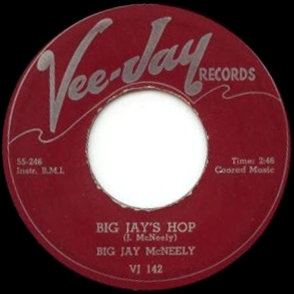
Cecil James "Big Jay" McNeely was born in Los Angeles, on April 29, 1927. McNeely was one of the myriad of acolytes of Illinois Jacquet, whose famous 64-bar solo on Lionel Hampton’s "Flying Home" (1942) created a nationwide craze for wild, physical, honking sax players. McNeely moved to the forefront with his 1949 hit "The Deacon's Hop." During the early 1950s, while McNeely was recording for Federal, he emerged as a sensation of the early rock 'n' roll scene, recording some of the best numbers of his career, notably "3-D" and "Nervous Man Nervous." By 1955, his Federal contract was up, and he and his band were playing in Chicago at the Crown Propeller Lounge on 63rd Street. Representatives from Vee-Jay caught McNeely's performance at the club and signed him. MacNeely recorded in March, and the company announced the signing in April (Cash Box, April 16, 1955, p. 25). Usually such notices signified an imminent release, but in McNeely's case the company waited another two months.
Two of the four numbers were remakes of earlier recordings. "Jay's Rock" was a number he had done for Federal in 1953, originally called "Texas Turkey." "Big Jay's Hop" was an updated version of "The Deacon's Hop," which gave 1955 listeners an idea of what all the excitement was about in 1949. The other two numbers were "All Night Long" and "Three Blind Mice." The latter has been described by McNeely expert Jim Dawson as "a jivey nursery rhyme with a mambo rhythm, complete with vocal grunts, designed to catch the quickly fading mambo craze."
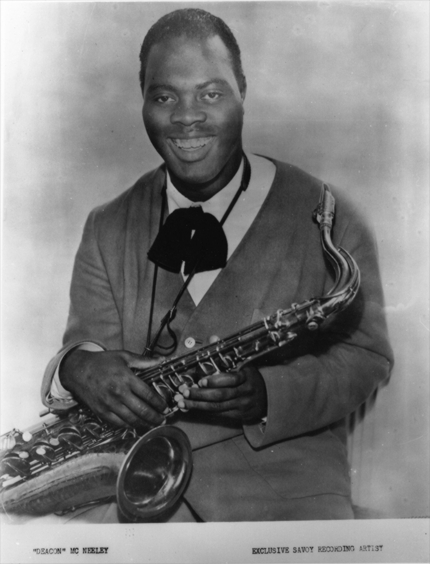
On his session, Big Jay was accompanied by members of his working band: Bob McNeely (baritone sax), Earl DeWitt (piano, organ), and Cecil E. Harris (bass), plus Chicagoan Johnny Walker (drums). This was McNeely's only session for Vee-Jay. It was dismissed by Dawson as "one of Big Jay's most uninspired recording sessions."
In June, Vee-Jay released "Big Jay's Hop" backed with "Three Blind Mice," to little public interest (Vee-Jay 142 was talked up by Ewart Abner in Cash Box for June 18, 1955, p. 31, and was advertised in Cash Box on June 25, 1955, p. 24). The Cash Box reviewer (July 23, 1955, p. 42) liked the mambo aspect of "Three Blind Mice" better than Dawson did.
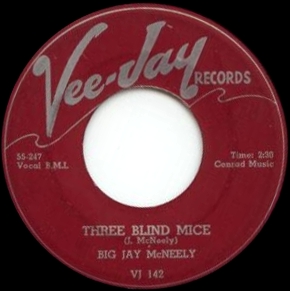
The following year, the company put "Jay's Rock" on the back of a novelty number by the Kool Gents recording as the Delegates. "The Convention" was a send-up of the Republican and Democratic conventions then taking place in a presidential election year. This was a perishable item, so the company recorded the "Delegates" on August 21, 1956, slapped "Jay's Rock" onto the single, and rushed it out at the beginning of September on Vee-Jay 212. Big sales were being alluded to in Cash Box on September 8, 1956 (p. 28). Vee-Jay 212 drew a favorable review on September 15 (p. 33) and the company reproduced it in a Cash Box ad on September 22 (p. 30). The company saw fit to mention it again in its end-of-year ad in Cash Box (December 29, 1956, p. 41). In May 1957, Big Jay was booked into the Crown Propeller Lounge, where he reportedly broke "all attendance records" (Cash Box, May 4, 1957, p. 38; May 25, p. 96), but Vee-Jay had long since let his contract expire.
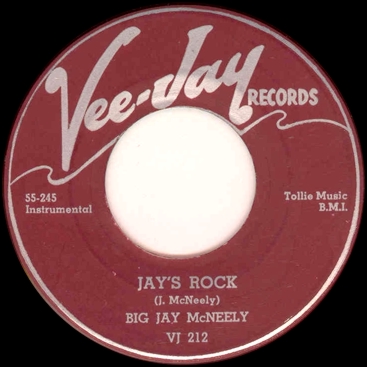
McNeely subsequently recorded for Atlantic, Swingin’, Warner Brothers, Bluesway, and Modern Oldies.
Source: Jim Dawson, Nervous Man Nervous: Big Jay McNeely and the Rise of the Honking Tenor Sax! Milford, New Hampshire: Big Nickel, 1994, p. 123.
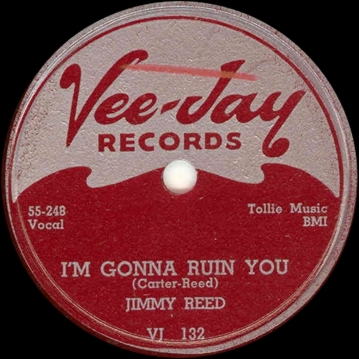
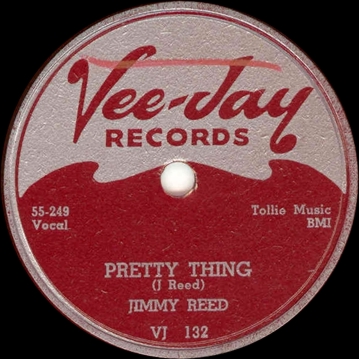
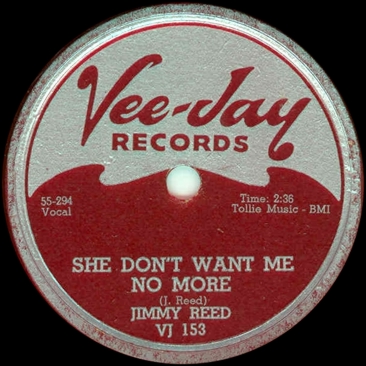
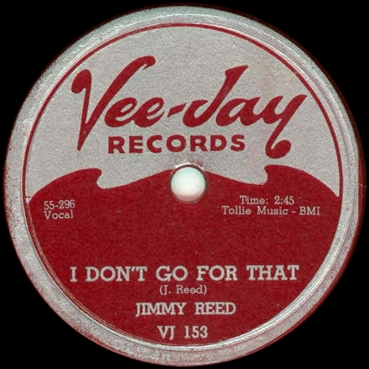
Jimmy Reed’s first four sessions in 1955—January, March, July, and November—were disappoinments commercially. The company badly wanted a sequel to Vee-Jay 119. It didn't get anything close to one out of the January session. The company actually had Reed remake two tunes from January in March, then pushed the March versions out on Vee-Jay 132 in April.
Vee-Jay 132, "I'm Going to Ruin You" b/w "Pretty Thing," was first advertised on April 16, 1955 (Cash Box, p. 24). A week later, 132 was given a joint ad with Vee-Jay 131 by The Spaniels (Cash Box, April 23, p. 22). Cash Box reviewed it on April 30 (p. 27), predicting a hit. It wasn't.
The July 18 session worked out a little better, leading to a minor R&B hit in Vee-Jay 153, "I Don’t Go for That." Vee-Jay 153 was released in August. The company ran ads for 153 and 154 on August 27 (Cash Box, p. 31) and September 3 (p. 25). Vee-Jay 153 was reviewed in Cash Box on September 10, 1955, p. 28, and Vee-Jay took out an ad reproducing the review on September 17 (p. 24). On October 8, another Cash Box ad announced that the single was "Beginning to Show!" (p. 25). Vee-Jay 153 reached #12 Billboard R&B.
It's worth noting that "I Ain’t Got You," also from July, exists in at least two takes. What was apparently intended as the master was released on an LP in the Vee-Jay 1000 series. Later reissues, starting with Vee-Jay LP 7303, have all used an alternate take that, according to Dave Sax, is not as good. Besides the first Vee-Jay LP issue, the master take is only on Charly CDGR 299, Found Love, which came out in 2000.
The November session seems to have been a dud, and the company never used anything from it. But "You Don’t Have to Go" still looked replicable, and Vee-Jay persevered.
Vee-Jay struck pay dirt with Reed's fifth session of the year, on December 5. At the company offices even the mailroom boy must have known it. Jimmy Bracken told Cash Box (item not published till December 17, p. 25) that Vee-Jay 168 was hitting the stands on December 12. The company ran an ad for it in the same issue (p. 27), along with the new John Lee Hooker release on Vee-Jay 164 and (belatedly) the Earl Phillips on Vee-Jay 158. On Christmas eve, the company ad (p. 37) made further room for the single by Montague on Vee-Jay 167. On December 31, 1955, Ewart Abner pitched the record to Cash Box (p. 19); on January 7, 1956 (p. 27), Cash Box ran a solo ad for Vee-Jay 168; there was another ad on January 14 (p. 35), and the review came on January 21, 1956 (p. 34). Further ads followed on January 28 (p. 33), February 4 (p. 32), Febuary 11 (p. 39), and February 25 (p. 34). "Ain’t That Lovin’ You Baby" went to #3 and lasted 11 weeks on Billboard’s R&B chart in 1956. The number also became a valuable publishing property as the song was done innumerable times by both r&b and pop artists.
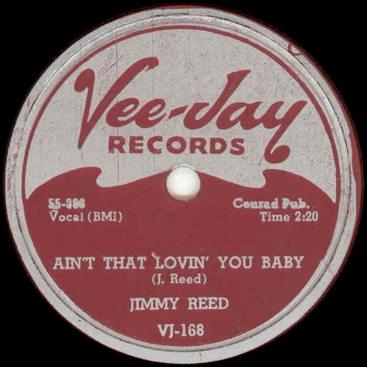
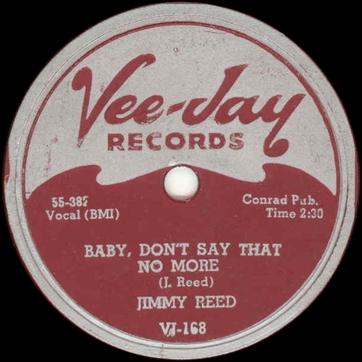
Jimmy Reed's third track from December 5, 1955 ("Can't Stand to See You Go") was used on his next release, Vee-Jay 186. It was paired with an instrumental from his session all the way back at the end of December 1953. Vee-Jay 186 was talked up (p 32), advertised (p. 31), and reviewed in Cash Box on April 28, 1956 (p. 30). 186 was given an ad the next week that reproduced the entire review (Vee-Jay often did this when a record had received a spotlight review; May 5, 1956, p. 30). The company kept pushing the record for a while, buying ads on May 12 (p. 64) and July 7 (p. 27). But Vee-Jay didn't end up catching the kind of sales off 186 that it had from 168.
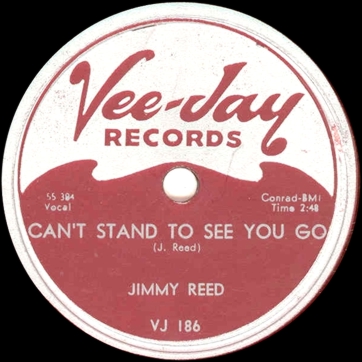
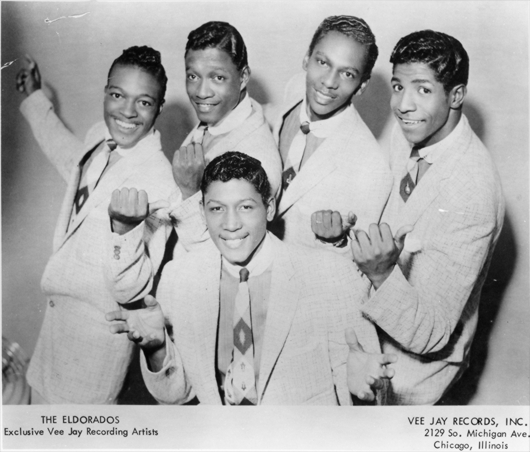
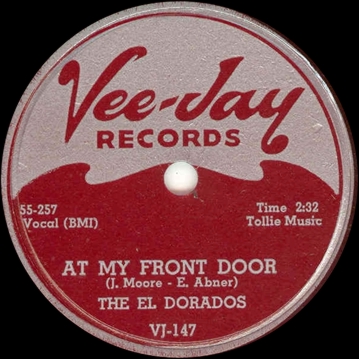
Not long after tenor Arthur Bassett dropped out—leaving a five man group—the El Dorados entered Universal Recording on April 24, 1955, and made history, recording with the Al Smith band their classic song, "At My Front Door."
Vee-Jay 147 was not a pure sleeper hit like 107 or 119, but there were lags. First, "I Began to Realize," the other side the group had cut on April 24, was not deemed a good coupling, and was held for the group's next release, Vee-Jay 165. "What's Buggin' You Baby" was made at the El Dorados' next session, on June 8. In turn, "What's Buggin' You" was cowritten by a Chicago DJ named Bob Drews (Cash Box, July 23, 1955, p. 43). Ewart Abner was talking the way the new release was moving on July 23, but the first 78-rpm labels printed for Vee-Jay 147 messed up the composer credit, changing Drews into "Owens." Printing replacement labels slowed the rollout.
On July 30, 1955 (p. 21), Vee-Jay 147 was advertised in Cash Box along with Morris Pejoe's 148 and Eddie Taylor's 149. An ad on August 6 (p. 24) paired it just with 148. Cash Box didn't review it till September 17 (p. 28). When Abner talked it up again on September 24, the record seemed to be drafting on 154 by The Spaniels, though now he was ready to venture that 147 "will be even bigger" (Cash Box, p. 27). "Front Door" pushed the El Dorados to national success when it hit #1 and lasted 18 weeks on Billboard's r&b chart. The record was a big pop hit as well, going to #17. By September 24, Vee-Jay was advertising the record as a pop hit (Cash Box, p. 26).
The appeal of "Front Door" draws in equal parts on the El Dorados and the studio band. The El Dorados, who with natural ease and swing, pushed through the energetic number with great rock 'n' roll verve, especially in Moses' fine lead work. Al Smith and his band created one of the most memorable opening riffs in rock 'n' roll, and without Al Duncan's propulsive drumming and the great tenor sax break (by Red Holloway) the song would have been far less. "At My Front Door" also has a concluding vamp by Red and pianist Norman Simmons.
Vee-Jay 165 was a single released in November 1955. The other side of 165, "I'll Be Forever Loving You," had been freshly recorded on October 21, 1955. 165 was mentioned in Cash Box on November 26 (p. 35) and advertised on the same date (p. 38). A bigger ad followed on December 3 (p. 32). Vee-Jay was still advertising 165 on January 14 (Cash Box, p. 35), February 4 (Cash Box, p. 32) and February 26, 1955 (Cash Box, p. 34).
The session continued with two instrumentals by Al Smith and group, and two vocal sides by Hazel McCollum, but Vee-Jay kept these sides, the last she did for the company, in the can. The label's principals seem to have lost interest in her after "Annie's Answer."
At the June 8 session, the El Dorados also cut "Now That You've Gone," which appeared on Vee-Jay 180 in April 1956. Vee-Jay 180 was released in April 1956. It was talked up (p. 34) and advertised (p. 36) in the April 7, 1956 issue of Cash Box, then advertised on April 14 (p. 36). The review of Vee-Jay 180 also arrived on April 14 (p. 38). A solo ad followed on April 21 (p. 32), and Vee-Jay 180 was one of seven items in a company ad for May 12, 1955 (p. 64). Despite the effort, Vee-Jay 180 didn't sell nearly as well as Vee-Jay 165.
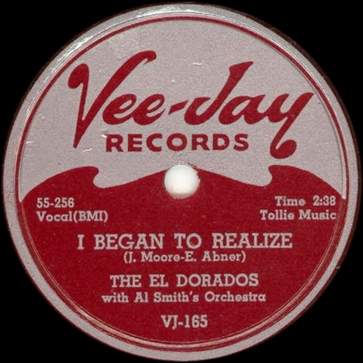
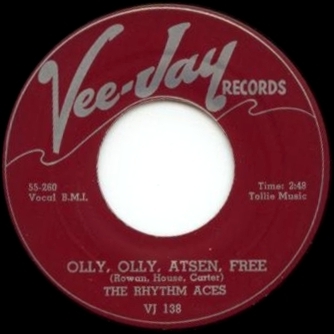
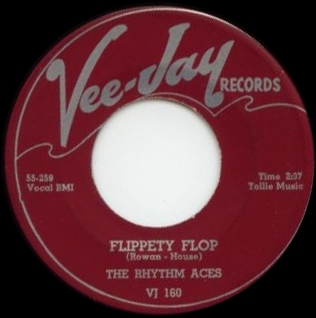
The Rhythm Aces' second session in the spring of 1955 featured more modern harmony. "Ab" (as Cash Box was then referring to him) told the trade paper that "they are readying a new session for the Rhythm Aces" (April 23, 1955, p. 21). Apparently Vee-Jay 124 was selling well enough to justify further investment. The Aces were accompanied by the house band from the Club DeLisa with Sonny Cohn and Fip Ricard (trumpets), Marty Martinez (trombone), Riley Hampton (alto sax); Porter Kilbert (subbing for Leon Washington on tenor sax), McKinley Easton (alto and baritone saxes), Earl Washington (piano), Jimmy Richardson (bass), and leader Red Saunders at the drums.
Expectations were high ("Next one promises to go over the top, Ab says"). They were not met. The standout among the four numbers cut in the studio was "Whisper to Me." "Olly, Olly, Atsen, Free" (as spelled on the label) drew a cover version or two. "Whisper" and "Olly" were coupled on Vee-Jay 138, which was given a rush release. The record was advertised in Cash Box on May 14, 1955 (p. 20). "Ab" told Cash Box (May 14, 1955, p. 21) that the Aces were just back in Chicago after a 40 week tour across the country, they had acquired more than 400 fan clubs, and "Olly" had been featured on Jim Lounsbury's TV show on WGN "and received a most favorable reaction." The record got a favorable review from Cash Box as well (May 21, 1955, p. 24).
It turned out Vee-Jay could not sell a jump like "Olly, Olly, Atsen, Free"—or such a sophisticated number as "Whisper to Me." After a second single from the session, the company dropped the group.
The Rhythm Aces then moved to California, and continued their recording career through the remainder of the 1950s in more of an R&B vein. The reorganized California group consisted of Vince House, Billy Steward, Chuck Rowan, and Jimmy Brunson, who recorded as the Rockets and Rocketeers for Modern, as the Planets for Era, and again as the Rocketeers for MJC.
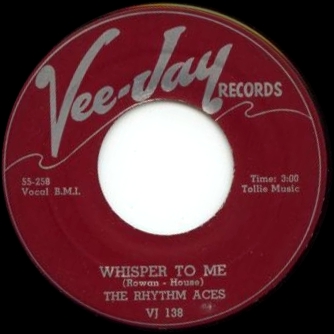
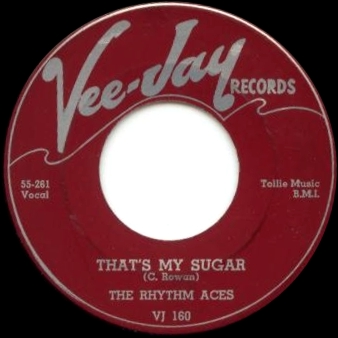
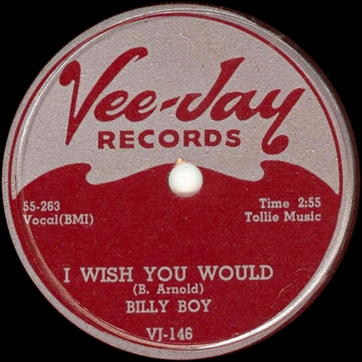
Bluesman Billy Boy Arnold was born William Arnold on September 16, 1935, in Chicago. Harmonica player Arnold, a follower of John Lee "Sonny Boy" Williamson, first began performing on 47th Street with Bo Diddley’s street band. He made his debut recording around March 1953 for the Cool label, with Bob Carter’s Orchestra. The group was apparently led by the Bob Carter who had recorded for Rim (not the Bob Carter who played bass and recorded for Sunbeam and Universal). One of the titles, "I Ain't Got No Money," described the label as accurately as it described Billy Boy at the time. His single wasn't released till July 1953, and Cool expired in October after promising 4 singles and putting out just two.
After Bo Diddley was signed to Chess in February 1955, Arnold recorded a couple of his own numbers at the end of the first Bo Diddley session, but Leonard Chess, perhaps thinking they might compete with some of Little Walter's output, did not seem interested in releasing them. So Arnold went to Vee-Jay, where he recorded his great number, "I Wish You Would" (the same tune that Bo Diddley recorded on his second session as "Diddley Daddy"). The session took place on May 5, 1955; his supporting band included Henry Gray (piano), Jody Williams (electric guitar), Milton Rector (on the then-novel electric bass), and Earl Phillips (drums). Vee-Jay chose to present Arnold as "Billy Boy."
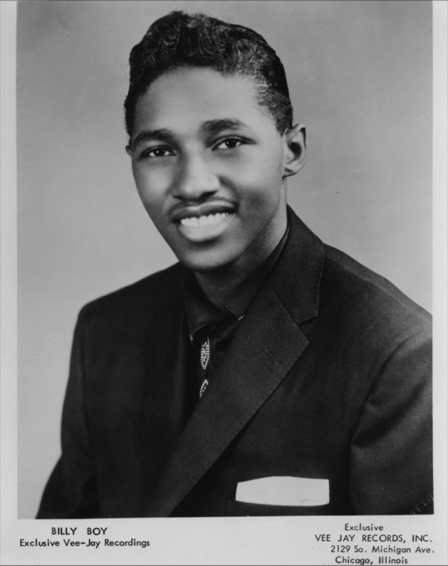
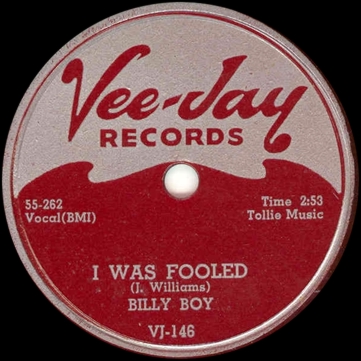
Arnold recalls sharing this session with Earl Phillips and Morris Pejoe, each artist getting two sides to record, and confirms that it all happened on the same day. We are thus inclined to list all three artists as recording on May 5. (The date for Pejoe's was entered in the Master Book as May 9.)
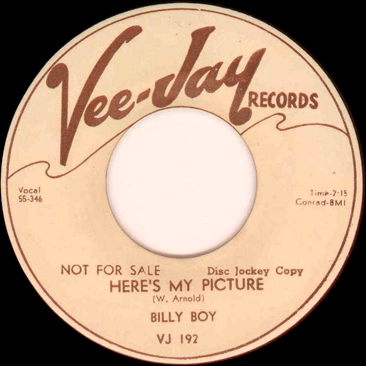
Vee-Jay 146 from the Billy Boy session, featuring "I Wish You Would," was given priority. It was released promptly (it was advertised in Cash Box on June 4, 1955, p. 24, given a verbal push by Calvin Carter on June 11, p. 29, then Cash Box reviewed it on June 18, 1955, p. 36), and it sold well.
A second session was held in October, yielding two more singles, Vee-Jay 171 and Vee-Jay 192. On this occasion bassist Quinn Wilson, who had been performing in Chicago for nearly 30 years, replaced Rector. One of the songs from the October session, "You've Got Me Wrong," was composed by veteran performer Jesse Cryor. Cryor had supplied the singing voice of Br'er Rabbit in the Walt Disney movie Song of the South; his final recording as a vocalist was made for Premium in 1951. He had been retired from performing since 1952.
Vee-Jay 171 was released in February 1956. Vee-Jay advertised it in Cash Box on February 4 (p. 32), on February 25 (p. 34), and again on March 24 (p. 32).
Vee-Jay 192, with the Cryor composition and "Here's My Picture," was released in June. Cash Box reviewed it on July 7, 1956 (p. 27), it landed a solo ad on July 21 (p. 27), and it got a futher push from the big company ad on July 28 (p. 79).
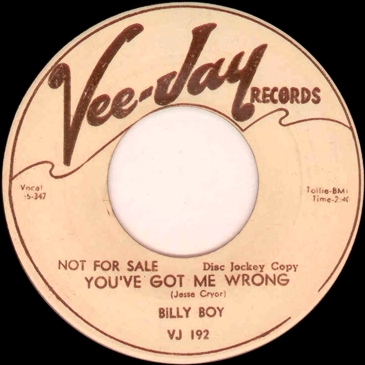
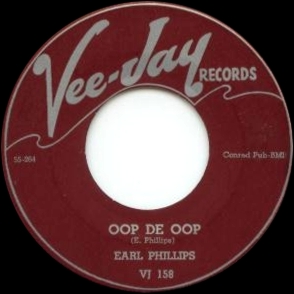
Drummer Earl Phillips was born in New York City, on April 25, 1920. He was a session drummer for years in Chicago, before Vee-Jay gave him his only opportunity to record under his own name. On his session of May 5, 1955, Phillips, who also sings, is accompanied by Henry Gray on piano, Jody Williams on guitar, Milton Rector on electric bass, and unknown saxes. The lead guitar work is obviously by Jody Williams (listen to "Oop De Oop"). Phillips also tried a side of his own at Billy Boy Arnold's October session; it has never been released. Earl Phillips died in Chicago, on November 20, 1990.
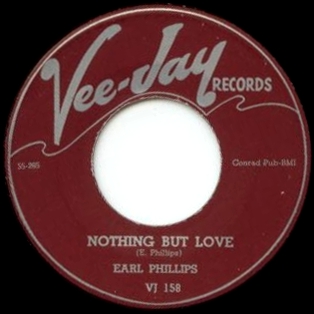
Phillips' one release as a leader was Vee-Jay 158. It was first advertised in Cash Box on December 24, 1955 (p. 37). Cash Box reviewed it on January 21, 1956 (p. 34) and another ad ran on January 28 (p. 33).
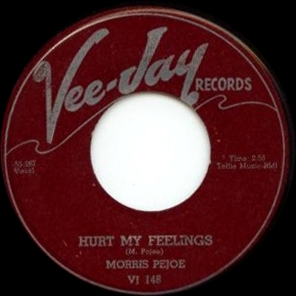
Guitarist-singer Morris Pejoe was born Morris Pejas in Palmetto, Louisiana, in 1924. He began his music career on the violin. After moving to Beaumont, Texas, in 1949, he switched to guitar. In 1951 Pejoe was in Chicago, performing with pianist Henry Gray. During 1952-53 he recorded three sessions for Checker, accompanied by Gray among others. A session for United, featuring blues and New Orleans-styled R&B, took place in December 1954 (it was actually recorded in Al Smith's basement, and United eventually decided not to release anything from it, probably on account of the sound quality).
The following year Pejoe recorded one session for Vee-Jay. Leadbitter, Fancourt, and Pelletier's Blues Discography shows accompaniment by Henry Gray on piano, with unknown saxes, bass, and drums. However, if what Arnold says is true, the drummer was Earl Phillips and the bassist was Milton Rector. The Master Book has Pejoe recording on May 9, but Arnold recalls that his session, Earl Phillips', and Pejoe's all took place on the same day. Vee-Jay 148 certainly sounds like a product of the Earl Phillips session, with powerful, prominently recorded drumming. And Henry Gray, Milton Rector, and Earl Phillips had all accompanied Pejoe in his session for United.
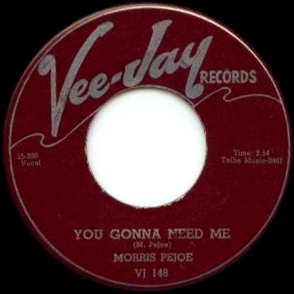
Vee-Jay held back on the Earl Phillips single, but got Pejoe's out with in August. Vee-Jay 148 was advertised in Cash Box on July 30, 1955 (p. 21, along with 147 by The El Dorados and 149 by Eddie Taylor) and again on August 6 (p. 24, now just with 147). Cash Box did not end up reviewing it, and such sales as it drew didn't lead the company to extend Pejoe's contract.
Pejoe subsequently recorded for Abco (1956)—on that occasion, lead guitar chores were entrusted to Magic Sam—Atomic H (1960), and Kaytown (1969). He died on July 27, 1982, in Detroit.
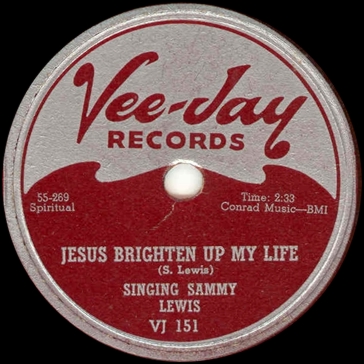
There are no details on Sammy Lewis’s session of May 22, 1955. It produced Vee-Jay 151, now a rare record, which the company didn't promote in Cash Box.
Lewis went to United the following year and recorded with the Little Lucy Smith Singers. Lewis would make later sessions for Halo (1965), Checker (1965-67), St Lawrence (1967), and Hope Sermon Series (1968-69).
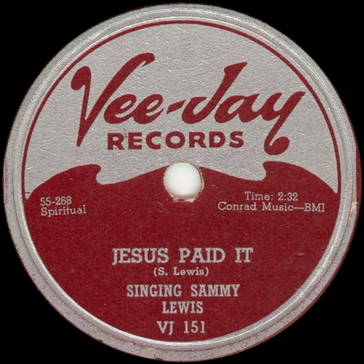
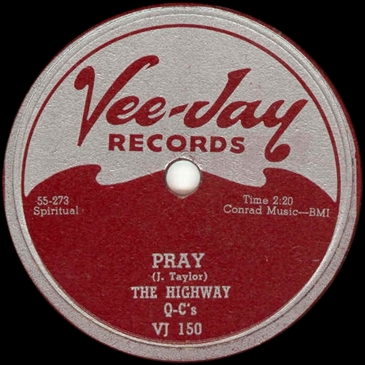
The Highway QC’s were formed in 1945. The original name was the Teenage Highway QC’s after the name of their Highway Baptist Church. In the late 1940s, Sam Cooke was in the group, but he left in 1950 to join the Soul Stirrers. By the time the group was signed to Vee-Jay in 1955, members were Lee Richardson (tenor lead), Sonny Mitchell (tenor), Creedell Copeland (baritone), Johnnie Taylor (baritone), Charles "Jake" Richardson (bass). The Johnnie Taylor who sings lead on "Every Man, Woman and Child" and "Somewhere to Lay My Head" is the same singer who became a soul giant in the 1960s and 1970s.
The group first recorded for Vee-Jay on May 22, 1955, in a session they shared with Sammy Lewis. By the middle of 1955, Vee-Jay was doing less to promote its gospel releases in the trades. Vee-Jay 150, "Pray" b/w "Somewhere to Lay My Head," was held for release till October, when it managed to score a review in Cash Box (October 29, 1955, p. 31). "Somewhere to Lay My Head" became a sizable gospel hit. The other two sides were included in a Vee-Jay gospel LP later on.
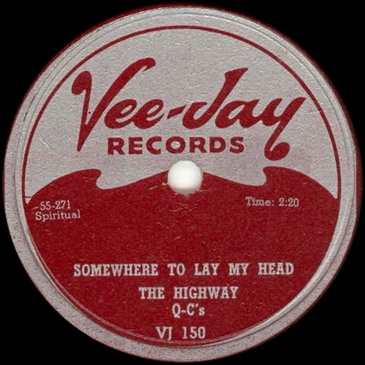
According to Bob Marovich, the QC's first two sessions for Vee Jay—May 22, 1955 and March 6, 1956—rank as one of the group's "finest recorded moments." He considers the songs "Pray" and "Somewhere to Lay My Head" to be gospel classics.
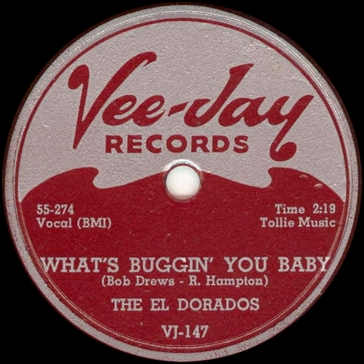
The Knights of Rhythm were a South Side group that featured Leon Arnold (lead), John Gillespie (alto), George Vinyard (first tenor), Davie Hargrove (second tenor), and Lester Martin (bass). They shared a session on June 8, 1955 with the El Dorados. Each group sang two tunes, backed by the Al Smith band. Leon Arnold was an exceptional songwriter, and it appears that Vee-Jay recorded the Knights of Rhythm simply to get their songs. This same "Forever Loving You" was taken over later by the El Dorados, who had a big hit with it. When this happened the Knights promptly left Vee-Jay and changed their name to the Rip-Chords, under which name they made a record for Abco in 1956.
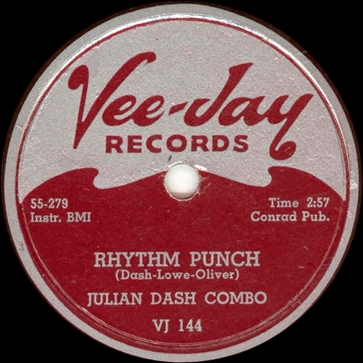
Julian Dash’s second session for Vee-Jay took place in June 1955. Dash was again joined by his touring combo, which now consisted of Jimmy Oliver (electric guitar), Ray Tunia (piano), Lee Stanfield (bass), and Bill English (drums). The session produced his best-known number, the rousing and appropriately named "Rhythm Punch." Although the number suggested it had once been on the fast track, Vee-Jay 144, "Rhythm Punch" coupled with "Zero," was not released till November. The company advertised it in Cash Box on November 5 (p. 31), along with Vee-Jay 155, 156, and 159. A second push for 144, 156, and 159 came on November 19 (p. 35). The other two sides were left in the can.
After this session, Dash got on record as a leader just one other time, in 1970, when he recorded an LP for Master Jazz Recordings, the awkwardly titled Who Was It Sang That Song. He toured Europe in 1972. Dash died in New York City, on February 24, 1974.
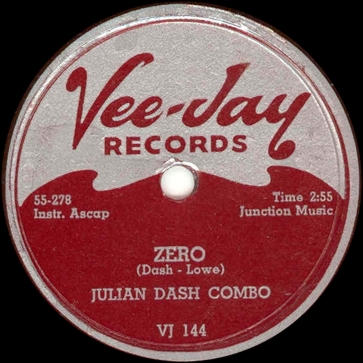
An ad that Vee-Jay placed in honor of the 13th anniversary of Cash Box (July 2, 1955, p. 68) displays what the company considered its entire roster of active talent. Wardell Gray had died. Some artists Vee-Jay had recorded in 1953 and 1954 were ancient history: Pro McClam, Wellington Blakey, Floyd Jones, Willie Jones, and Floyd Valentine were off the list, even though Floyd Jones and Willie Jones had had releases earlier in the year. The Dells only had one side out so far, and the company hadn't decided to release anything by Eddie Taylor yet. By contrast, those who had just gotten unpublicized releases, or had releases pending—King Kolax, Dave Shipp, Morris Pejoe, Earl Phillips—were named in the ad. And everyone who had recorded gospel for the company was present and accounted for, including the Highway Q-Cs, who didn't have a record out yet. In fact, two groups that appeared at the end of the list, The Duncanaires and the True Light Choir, never did record for Vee-Jay so far as we know. Did a deal to buy some masters fall through?
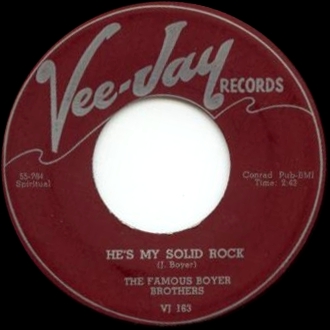
The Famous Boyer Brothers, James Buchanan Boyer and Horace Clarence Boyer, were born in Winter Park, Florida, on April 3, 1934 and July 28, 1935, respectively. Their father, Climmie Boyer Sr., was a pastor in the Church of God in Christ. Horace was a tenor, James was a baritone, and both played piano. According to someone who should know, "the brothers sang two-part harmony on slow songs and used call and response on jubilee and shout songs. Singing in the sanctified style, they were adept at building tension through the use of a vamp" (Horace Clarence Boyer, in his 1995 book How Sweet the Sound: The Golden Age of Gospel).
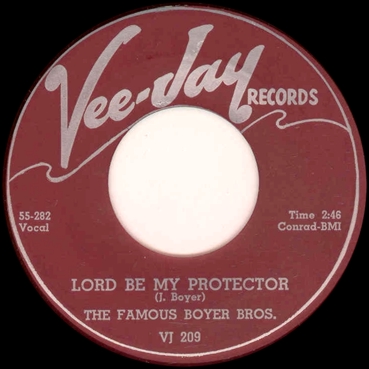
The brothers first recorded for Excello in July 1952, when they were still in high school. Two subsequent released titles on Chance, plus two unreleased sides, were picked up by Vee-Jay, probably in July 1954, which is the date indicated by Gospel Records, 1943-1969.
The brothers’ first session for Vee-Jay took place in June 1955. Hayes and Laughton's Gospel Discography states that accompaniment to the June 1955 session was probably by James on piano and Horace on organ, along with an unidentified drummer. However, around 6 months later Local 208 of the Musicians Union conducted an inquiry into gospel sessions at Universal Recording that included non-union musicians. Caught in the net was a pianist and organist named Gerald Spraggins, who had been brought into the Boyer Brothers' Chance session by "Professor" Alex Bradford. Spraggins, who was non-union, got $25 per session for his work and accused Bradford of withholding some of his pay. Spraggins further recalled that "He later made a session at Universal Recording Studios [in] the latter part of 1955. […] He never signed a union contract and again was promised $25.00" (Board meeting minutes of Local 208, January 19, 1956, p. 4). Again, Spraggins recalled that Bradford was on the date, so probably Alex Bradford played piano and Spraggins played organ.
Subsequent recording opportunities for the Boyers included a final session for Vee-Jay in 1957, and 2 LPs for Savoy in 1966 and 1967. In later years, both of the brothers went into academia. James became a professor of Education and Ethnic American Studies at Kansas State University. Horace was a professor of Music at University of Massachusetts Amherst from 1973 to 1999. He died in Amherst, Massachusetts, on July 21, 2009. (See Horace Clarence Boyer's obituary in the Amherst Republican, July 23, 2009 at http://obits.masslive.com/obituaries/masslive/obituary.aspx?n=horace-clarence-boyer&pid=130192723.
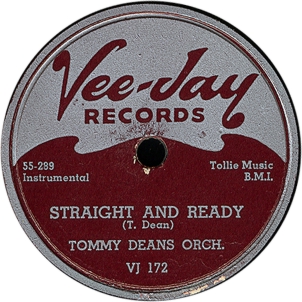
Vee-Jay brought Tommy Dean back into the studio in July, when the standard four sides were waxed. His third session for the company featured Dean on piano and organ, Cornelius Tillman and Joe Whitefield on tenor saxes, Archie Burnside on bass, Edgar Plaes on drums, and Joe Buckner as the vocalist. On "Skid Row," Dean sometimes plays piano with one hand and organ with the other; on "One More Mile," he switches from one instrument to other.
"One More Mile," backed with "Straight and Ready," appeared on Vee-Jay 172 in February 1956. 172 was first included in a Vee-Jay ad in Cash Box on February 4 (p. 32), then advertised on February 11 (p. 39), and February 25 (p. 34). It got a solo ad on March 3 (p. 28), and further pushes on March 24 (p. 32) and March 31 (p. 24).
Vee-Jay 218, featuring "Skid Row," was first advertised in Cash Box on December 1, 1956 (p. 35). The single was reviewed in Billboard in December 1956. Cash Box got to it on December 22 (p. 38). The single got another mention in the company's year-end ad in Cash Box (December 29, 1956, p. 41).
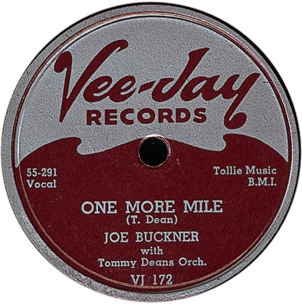
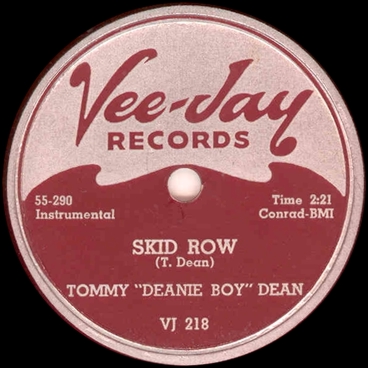
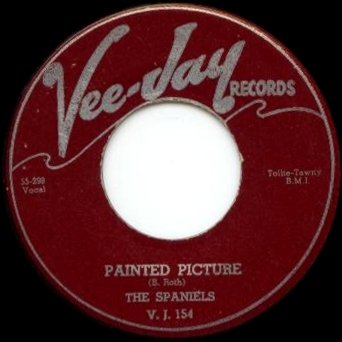
The Spaniels were featured in one of Sam Evans' R&B shows at the Trianon on June 17, 1955, sharing the bill with Jimmy Reed, LaVern Baker, Roy Hamilton, and the Erskine Hawkins orchestra. The group returned to the studio around July 23, cutting three tunes this time (Cash Box for July 30, p. 17, had the group recording a session and promised an early release for two of the sides). "False Love" was deemed unsatisfactory and would be remade in January 1956. The other two, "You Painted Pictures" and "Hey, Sister Lizzie" came out in August on Vee-Jay 154. Vee-Jay advertised 153 and 154 in Cash Box on August 27, 1955 (p. 31) and again on September 3 (p. 25). Cash Box reviewed 154 on September 3 (p. 24). On September 17, Ewart Abner was telling Cash Box (p. 25) that 154 had sold 26,000 copies in New York, Newark, and Philadelphia. On September 10, Vee-Jay ran an ad for 154 that reproduced the entire Cash Box review (p. 29).
Dr. Robert Stallworth notes that the initial pressings of Vee-Jay 154 reduced the title of the first song to "Painted Picture." It was also reviewed under that title. It's not clear who was in the band for this session but someone should be able to identify the prominent guitarist. The other members were a tenor saxophonist (barely audible on "Lizzie," soloing on "Painted"), a bassist, and a drummer.
Bernard Roth was the composer of "False Love" and "You Painted Pictures." A brief item in Cash Box (September 3, 1955, p. 22) referred to him as "Barney" Roth and identified him as a grocer. Supposedly his original goal was to recruit his own vocal group to perform the songs, but Jimmy Bracken nominated The Spaniels. Since Wellington Blakey had been dropped from the artist roster, any prior connection between Roth and Vee-Jay was obviously considered ancient history.
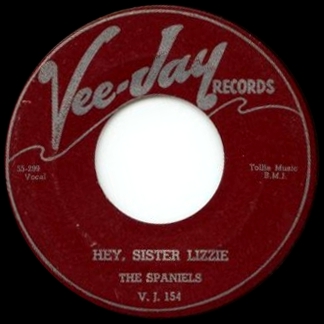
Dolores Washington was a gospel vocalist who shared a session with Maceo Woods in August 1955; we must assume that Woods provided the accompaniment. Her one release, on Vee-Jay 162, is extremely rare today. Subsequently, Washington joined the great gospel group, the Caravans. It was during her service with them (roughly 1958 to 1968) that she made most of her records. Washington also recorded a solo LP for the Gospel label (a Savoy subsidiary) in 1969.
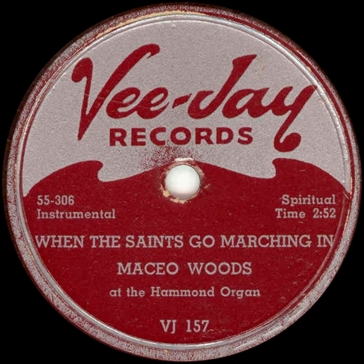
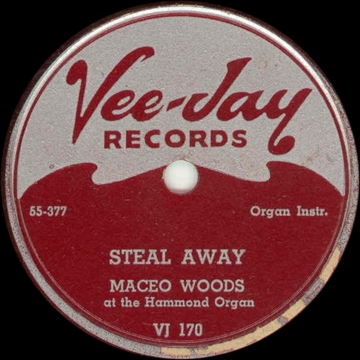
Vee-Jay recorded gospel organist Maceo Woods in two sessions during 1955—one in August and one in November. The August session produced one single that paired "When the Saints Go Marching In" with "Near the Cross." Vee-Jay 157 went unadvertised, but our estimate is that it was released in November 1955. The other two tracks remained unreleased.
Presumably a mid-November session produced a rerecording of "Near the Cross." We have our doubts—this looks more like a listing error than an actual session, especially when we know that a November 23 session took place. At that session five gospel classics were laid down, notably "Precious Lord," "Old Ship of Zion," and "Steal Away." Vee-Jay pulled "Steal Away" and "Precious Lord" for a single release on Vee-Jay 170. The entire promotional effort for 170 in Cash Box amounted to an announcement that Vee-Jay 171 and 172 were coming. "With organ instrumental by Maceo Woods ready for promotion" (January 14, 1956, p. 33). The remaining tracks were held till 1959, when Vee-Jay inaugurated its gospel LP line.
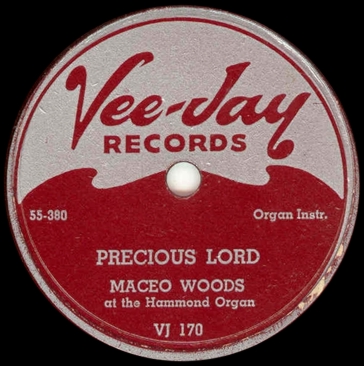
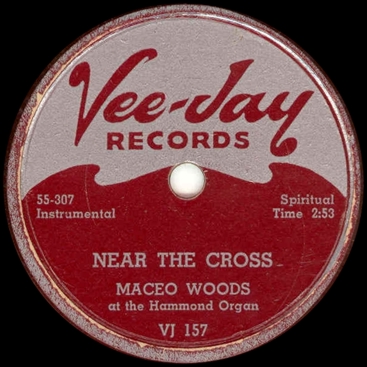
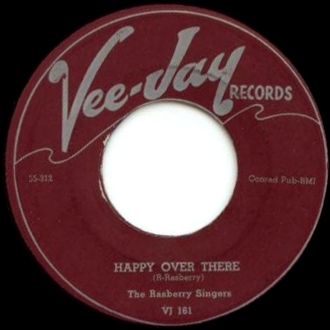
The Rasberry Singers returned for a second session in August 1955. We wonder whether Maceo Woods helped out with the accompaniment on this occasion.
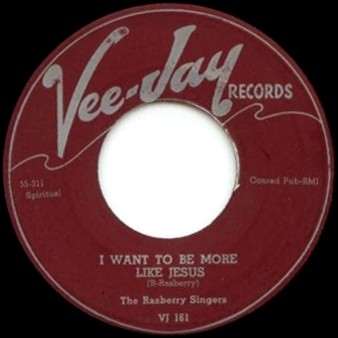
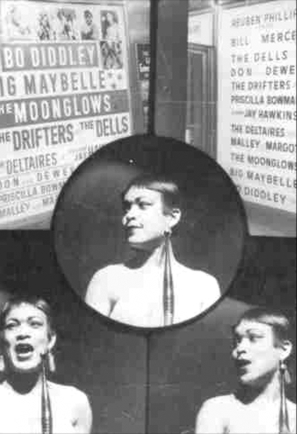
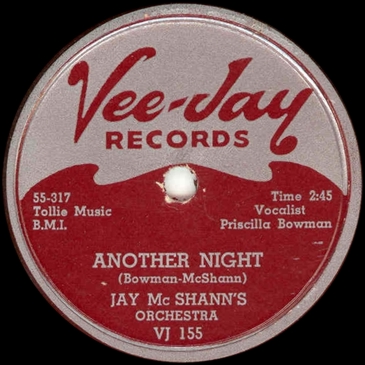
Priscilla Bowman was born in Quindaro Township, part of Kansas City, Kansas, on May 30, 1928. (Our thanks to Marv Goldberg for correct date and place of birth.) She has been called the "last of the great Kansas City shouters," but also the city's "original rock 'n' roll mama." She was both, as liner note writer Paul Peterson observed of her career in 1986. Bowman joined the Jay McShann band in the early 1950s; in 1955 the group was signed to Vee-Jay. Bowman recorded five sessions for the label. Two were done with Jay McShann in 1955 and 1956. On three more she recorded as a solo act—with bands led by Al Smith in 1957 and 1958, finally with a band led by Riley Hampton in 1959. Just about every number she waxed was top-notch, but only "Hands Off" from this first session made the charts—number one on the Billboard R&B listing in late 1955.
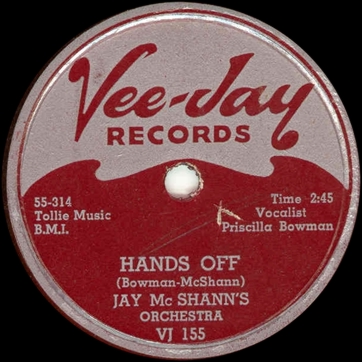
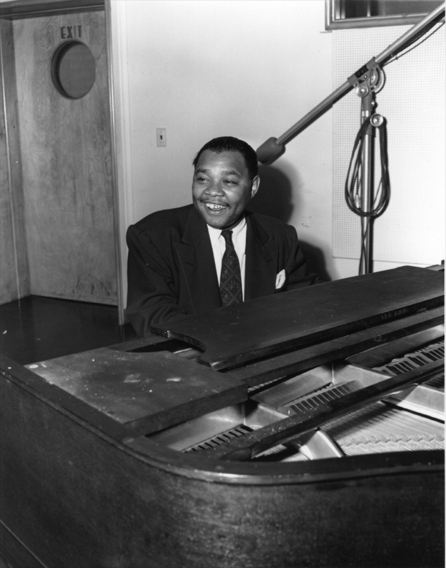
The first session, which took place on September 4, 1955, featured Bowman on six sides and the Jay McShann band on two instrumental sides. Plenty of usable alternate takes have survived as well. The band included McShann (piano), Orville "Piggy" Minor (trumpet), Oscar "Fats" Dennis (tenor sax), Gene Griddins (guitar), Oscar "Lucky" Wesley (bass), and one of Vee-Jay's house drummers, Al Duncan.
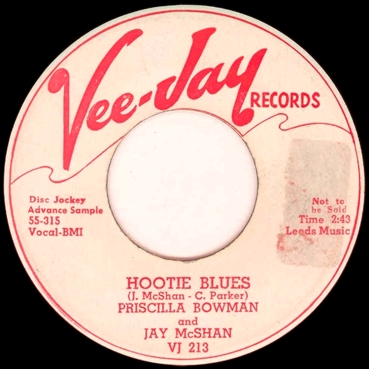
Vee-Jay 155, which paired two Bowman vocal features, "Hands Off" and "Another Night," was released in October. It was talked up in Cash Box, October 15, 1955, p. 29; given a solo ad in the same issue, p. 34; advertised again on October 22, p. 31, and October 29, p. 29; and included in a big ad with three new releases, November 5, p. 28. The review arrived on October 22 (p. 33). A final ad ran on January 15, 1956 (p. 35).
Vee-Jay was in no hurry with the two instrumentals that finished off the session. Vee-Jay 191, containing "Jay's Jam" and "Four Plus," was released in June 1956, after another Priscilla Bowman single from her second session. Cash Box reviewed it on July 7 (p. 32). It did get into the December 29 ad in Cash Box (p. 41).
More than a year after the sides were recorded, Vee-Jay 213 was supposedly included in a "special Thanksgiving package" (Cash Box, November 24, 1956, p. 32), but the company was in no hurry to advertise it. Vee-Jay 213 didn't rate a mention in the end-of-year ad (Cash Box, December 29, p. 41); the company preferred to hark back to Vee-Jay 155. Vee-Jay finally included 213 in Cash Box ads for January 19, 1957 (p. 40), February 2 (p. 36), and February 9 (p. 41). Cash Box finally reviewed it on February 16, 1957 (p. 45).
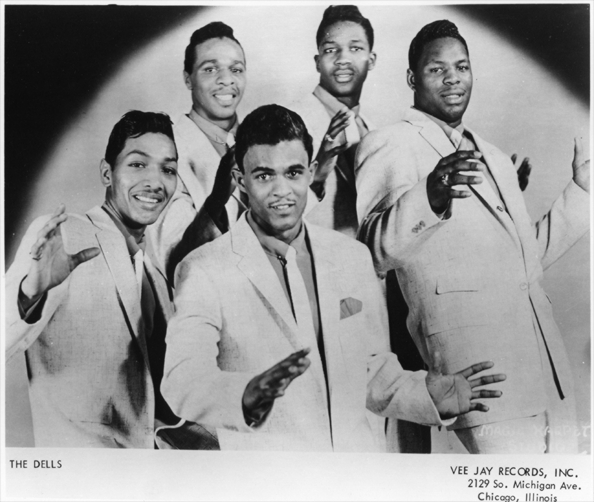

The Dells rank as one of the most heralded groups of the 1950s. The group hailed from Harvey, Illinois, and consisted of Johnny Funches (lead), Marvin Junior (baritone), Verne Allison (tenor), Mickey McGill (tenor), and Chuck Barksdale (bass). In September of 1955 the Dells walked into Universal Recording Studio to record with the Al Smith band, and the first release from the session featured "Dreams of Contentment." The song established the classic fifties Dells sound of Funches' plaintive lead answered by the rest of the group with pristine chorusing harmonies, and all under girded by Barksdale's wonderful bass work.
Red Holloway's tenor sax work does much to set the mood. "I Can’t Help Myself" has no instrumental solos, but there are brief tags by Red Holloway and Guitar Red. "Zing Zing Zing" has an intro by Guitar Red and a tenor sax solo by the other Red. "Dreams of Contentment" has no solos, but it features prominent accompaniment by Red Holloway.
We used to give December 1955 as the date of release for Vee-Jay 166 ("Dreams of Contentment" b/w "Zing Zing Zing"), and the release number tells us this was Vee-Jay's plan originally. But the company had Vee-Jay 165 by the El Dorados already out and selling, and had laid major priority on another release by the Spaniels (Vee-Jay 178, which was rushed out at the end of January 1956). These groups were established on the label, whereas the Dells so far had gotten one side of an obscure release (Vee-Jay 134).
So Vee-Jay 166 had to sit in the queue until 178 was ready. It was first advertised as a new release in Cash Box on February 4, 1956 (p. 32, along with Vee-Jay 171 by Billy Boy Arnold and Vee-Jay 172 by Tommy Dean). It was advertised again on February 11 (p. 39) and February 25 (p. 34). Vee-Jay 166 got a solo ad in Cash Box on March 10 (p. 31) and was reviewed in the same issue (p. 31). It was further advertised on March 24 (p. 32) and March 31 (p. 24).

King Kolax recorded a second session of six numbers plus an alternate take for Vee-Jay on September 16, 1955. He was accompanied by Harold Ousley (tenor sax), Prentice McCarey (piano), Malachi Favors (bass), and Leon Hooper (drums). The session, perhaps too jazzy for Vee-Jay's singles market, remained unissued. Three sides were leased to Top Rank in 1961, for release on a French LP titled Jazzville Chicago Volume 1. It was compiled by Kurt Mohr. "Those Crazy Rhythm 'n' Blues," of which two takes are extant, is standard jump-band R&B, distinguished only by the comments of Vivian Carter's brother Calvin impersonating a female fan of the quintet. "Time" is an ordinary slow blues, and "H2O" a straight bebop number. The other tracks are still unreleased after 63 years. Shortly after this session, King Kolax's band played a new Black-owned Las Vegas casino, the Moulin Rouge, for four weeks. But the Moulin Rouge ran out of money in October, and Local 208 had to pay for their travel so the band members could get back home.
After his Vee-Jay affiliation ended, Kolax never recorded under his own name again, although he occasionally backed up singers on recordings and, in the early 1960s, did A&R work for the small Marvello label. In 1957, he broke up his long-running NBC Quintet. King Kolax appeared on his last recording session in 1970, served for a number of years as an official of Musicians Union Local 10, and retired completely from playing around 1981. He died in Chicago on December 18, 1991, after suffering from Alzheimer's disease for some time.
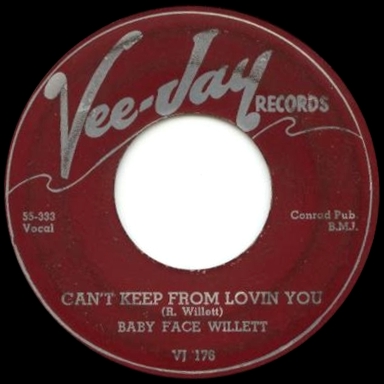
Soul-jazz and hard bop pianist/organist Baby Face Willette was born Roosevelt James Willette on September 11, 1933, in Little Rock, Arkansas (though some sources say he was born in New Orleans and raised in Little Rock). His first formative experiences in music were in gospel, where he accompanied gospel singers. His first session was done for Recorded in Hollywood, in 1952; not long afterward, he settled in Chicago. The session he cut for Vee-Jay was his second. His singing and organ playing were supported by a band featuring Red Holloway (tenor), Jon Thomas (piano), Lefty Bates (guitar), Rhodell Fox (bass), and Moses Weedseed (drums).
In 1958, Willette began playing organ for jazz groups, and found himself on several Blue Note albums, accompanying such artists as Grant Green and Lou Donaldson. Willette recorded two LPs for Blue Note in 1961, Face to Face and Stop & Listen, following up in 1964 two LPs for Argo, Mo' Rock and Behind the 8 Ball. From approximately 1966 to 1971 Willette worked regularly on the South Side, developing a following at the Pershing Lounge. His All-Music Guide biography says he died in obscurity, at an unknown date.
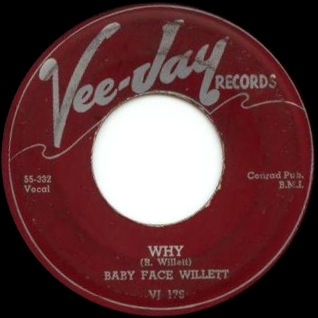
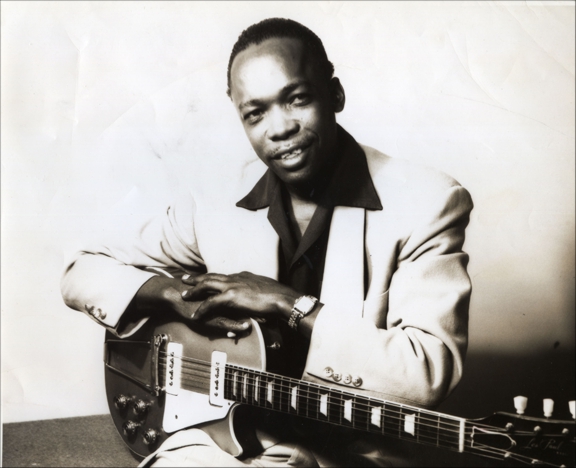
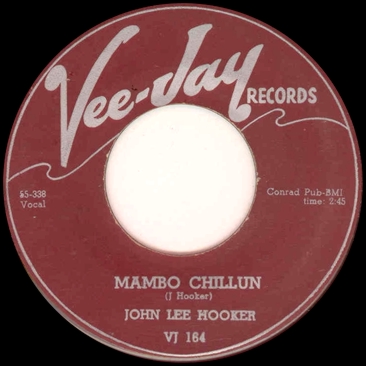
John Lee Hooker was born on August 17, 1920, in Clarksdale, Mississippi (some sources have put the date as 1917). Sometime in the mid-1930s he moved to Memphis, Tennessee. Keeping a northbound trajectory, Hooker lived in Cincinnati for several years, then 1943 saw him moving to Detroit. His breakthrough was his recording of "Boogie Chillen," recorded for Bernie Besman. Besman was the owner of the Sensation imprint, but because of his label's chronic lack of distribution, he decided to lease the sides to Modern, which was based in Los Angeles. "Boogie Chillen" went to number one and lasted an amazing 18 weeks on Billboard’s r&b chart in 1948. Hooker garnered another number one hit in 1951 with "I’m in the Mood." During these years Hooker was recording for anybody who offered upfront cash, so there was an avalanche of recordings coming out under his real name as well as under a host of pseudonyms. Chicago-based labels were peripheral participants in Hookermania. In 1951 and 1952, on Chance put out three singles consisting of early clandestine recordings, and during those same years Hooker actually recorded in the studio for Chess. But most of his releases were with Modern, to which he was under contract.
At the beginning of his recording career, Hooker recorded alone, his vocals accompanied only by his rudimentary guitar work and his foot pounding to a boogie beat. Eventually, Eddie Kirkland was employed on second guitar, and by 1954 a band was more often used to accompany him.
When Hooker signed with Vee-Jay in 1955, the company started him out with a session on October 19 that used Jimmy Reed on harmonica for some cuts, guitarist Eddie Taylor, George Washington on bass, and Hooker’s longtime drummer Tom Whitehead (who knew how to deal with the leader’s erratic timing). The first offering, Vee-Jay 164, was being talked up to Cash Box on December 10, 1955 (p, 39) and advertised on December 17 (p. 27, along with Vee-Jay 165 and 168) and December 24 (p. 37, with Vee-Jay 167 now added to the lineup). Vee-Jay 164 was reviewed in Cash Box on January 28, 1956 (p. 32). Besides Vee-Jay 164, which was not the hit the company was hoping for, the session yielded one side for a much later release, Vee-Jay 265. But the company was willing to be patient where John Lee Hooker was concerned.
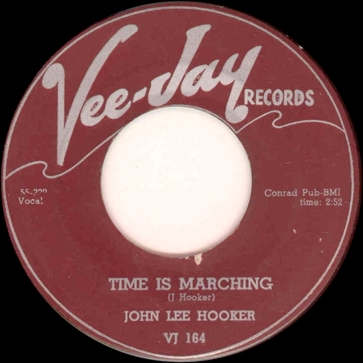
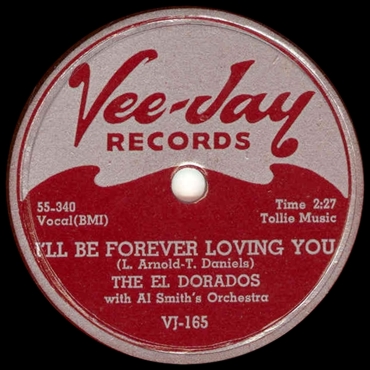
An October 21, 1955 session produced the El Dorados' next record, "I'll Be Forever Loving You."
Vee-Jay 165 was a single released in November 1955. It was mentioned in Cash Box on November 26 (p. 35) and advertised on the same date (p. 38). A bigger ad followed on December 3 (p. 32). The record was still being advertised on January 14, 1956 (Cash Box, p. 35), February 4, 1956 (Cash Box, p. 32), and February 25, 1956 (p. 34). Vee-Jay 165 was the group's only other national chart record. "I'll Be Forever Loving You" made it to #8 on one of Billboard's several hit lists, the Jockey's chart. The song, however, despite the soulfulness of Moses' lead, lacks the deep feeling that best characterizes the El Dorados approach. "I’ll Be Forever Loving You" has a tenor sax solo by Red Holloway and characteristic high-stepping drumming from Vernel Fournier in his rock mode.
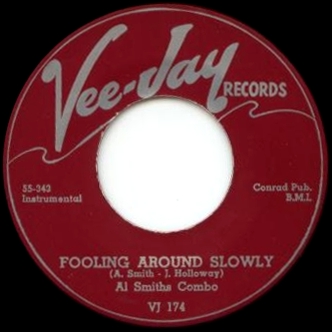
Popping up around October 1955 in the Vee-Jay session listing are two instrumental sides by the Al Smith Combo, "Buttermilk’ and "Fooling Around Slowly." Although they are listed in Vee-Jay’s standard Universal-based numerical sequence, Red Holloway told Armin Büttner that these numbers were recorded at a local radio station in Gallatin, Tennessee, while the Al Smith band was on tour. He recalled that Randy Wood of Randy’s Records was involved. Since Randy Wood was a major promoter of R&B in his part of the country, as well as the proprietor of Dot Records, this is plausible. Holloway recalled the date as 1951, which would be too early for this lineup. Spring 1953 is plausible.
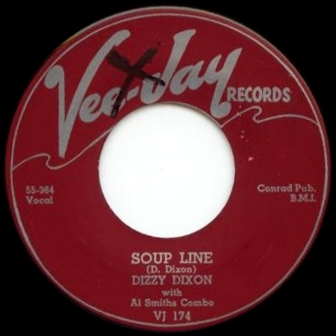
At some point these tracks were offered to Vee-Jay, which used one of them as a coupling for a novelty side by Dizzy Dixon called "Soup Line," recorded probably in November 1955 with the Al Smith band. We learn from Cash Box (February 4, 1956) that Dixon was a DJ in Hammond, Indiana. Monologues by DJs were on the company's mind at the time, as the subsequent Montague session makes plain. But Montague's release was out in time for Christmas. We suspect the Cash Box item marked the intended release date for Vee-Jay 174, but this was further delayed. "Soup Line" is a comic monologue, part spoken, part sung. Dixon, whose given name was Dave, recorded another monologue at the same session titled "Can't Afford It," but Vee-Jay left it in the vault. The coupling of "Soup Line" and "Fooling Around Slowly" on Vee-Jay 174 was released in June 1956. The company bought no ads, but Cash Box reviewed it on June 30, 1956 (p. 31).
The Vee-Jay Master Book handles these sides in a confused fashion. There has never been a successful reissue of "Buttermilk," although Charly tried one on an LP (and ended up substituting another Al Smith track for it). The Vee-Jay Master Book indicates that 55-342 was titled both "Buttermilk" and "Soup Line," but the issued "Soup Line" carries matrix number 55-364.
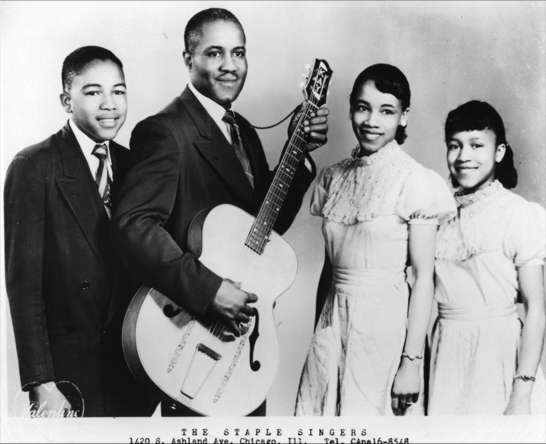
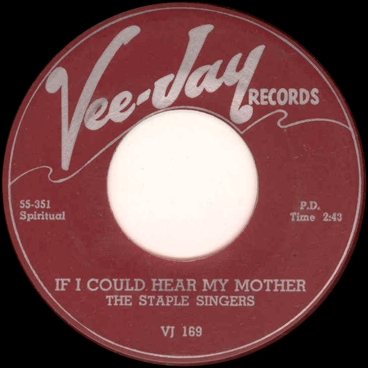
The Staple Singers were a family group consisting of father Roebuck Staples, daughters Cleotha and Mavis, and son Purvis. The appeal of this gospel group was Mavis’s extraordinary contralto lead and father Staples’ Mississippi blues guitar and vastly underrated vocal leads. The Staple Singers had made two recording sessions for United prior to their first Vee-Jay session, but neither made use of their strengths. The first Vee-Jay session in November 1955 produced no hits, but they would come.
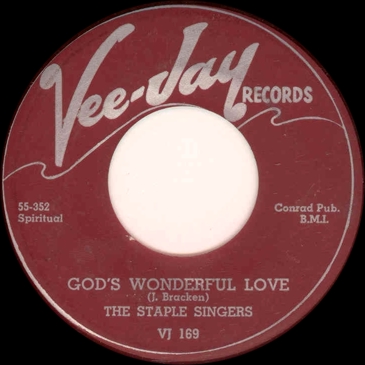
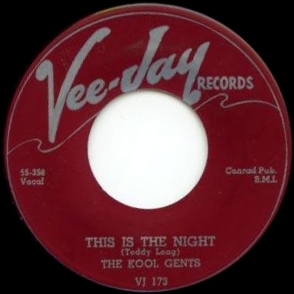
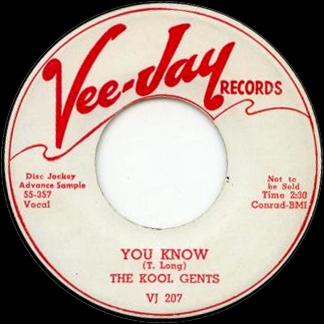
The Kool Gents were a group from the city's West Side and consisted of Dee Clark (tenor lead), John McCall (tenor lead), Doug Brown (second tenor), Teddy Long (baritone), and Johnny Carter (bass). They were so named because they were sponsored by DJ Herb Kent. The group signed with Vee-Jay in the fall of 1955 and recorded on November 3.
Despite the composer credits, the leads on "Crazy over You" and "This Is the Night" are actually by John McCall. The leads on "Do Ya Do" and "You Know" are by Teddy Long. "Crazy over You" has a tenor sax solo that sounds to us like the work of Red Holloway. However, we have learned that there really was a Ronald Hall who played tenor sax in Chicago, and it is he who is listed in the session log.
The Kool Gents' first release, "This Is the Night," was an atmospheric ballad featuring McCall as lead. As a new vocal group well down the Vee-Jay totem pole, the Gents got their first release in May 1956. "This Is the Night" was coupled with "Do You Do." The company didn't buy an ad for it, but Vee-Jay 173 was reviewed in Cash Box on June 16, 1956 (p. 32)
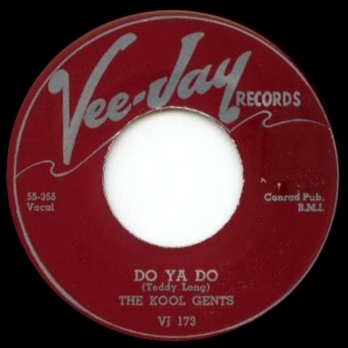
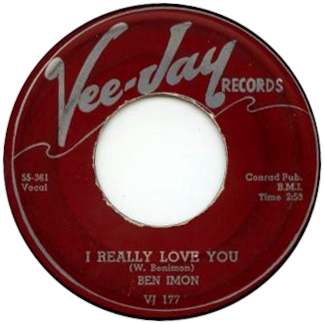
William Benimon, who usually went by the name of Ben Imon, sported an attractive pop-style baritone voice. He was born around 1925. On his only known recording session, he got a first-rate jazz accompaniment from members of the Red Saunders band: Riley Hampton (alto sax), McKinley Easton (baritone sax), Earl Washington (piano), Lefty Bates (electric guitar), Jimmy Richardson (bass), and Red himself (drums). On the Swing number "Down in the Country," Easton takes a very unusual 24-bar solo that features his big horn's upper register.
"Down in the Country," however, did not fit into any prevailing popular style, and Vee-Jay promptly dropped the singer. Few copies of Vee-Jay 177 were pressed, the company didn't advertise it, and the single is extremely rare today. Benimon was still active in Chicago in 1959, when he got a rare mention in a Defender advertisement for a package show. Benimon died in Cleveland, on December 21, 1971.
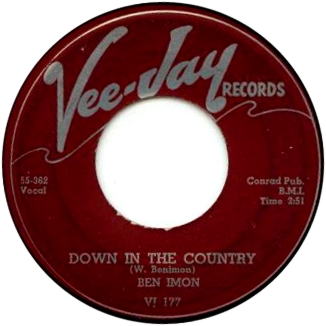
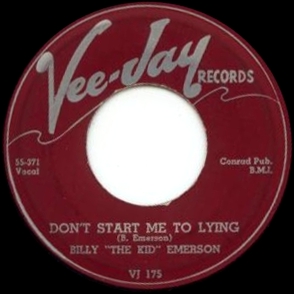
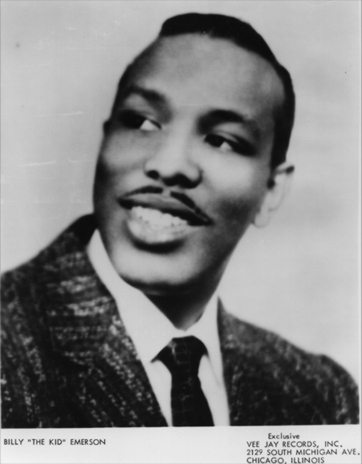
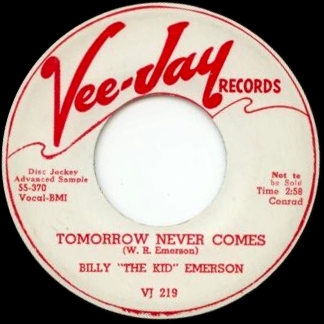
Soulful blues singer Billy "the Kid" Emerson was born William Robert Emerson in Tarpon Springs, Florida, on December 21, 1925. As a teenager, Emerson played piano in local bands. He served in the Navy during World War II, and got his nickname while working with a band that dressed like outlaws. In 1952, he joined the US Air Force, joining Ike Turner's band after he returned to civilian life. His first recordings were made with Sun Records in Memphis in 1954-55. "Red Hot" subsequently became a rockabilly staple. In November 1955, Emerson joined Vee-Jay Records. On his first session he was accompanied by a crack studio ensemble of Red Holloway (tenor saxophone), Mac Easton (baritone sax), Horace Palm (piano), Lefty Bates (electric guitar), Milton Rector (electric bass), and Vernel Fournier (drums). Some sources say Quinn Wilson was also present on string bass, but only the electric bass can be heard.
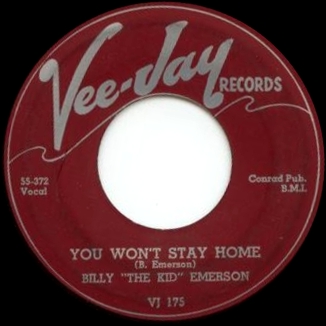
Emerson was another artist whose records Vee-Jay wasn't rushing out. Vee-Jay 175, "Don't Start Me to Lying" b/w "You Won't Stay Home," was released in June 1956. Cash Box reviewed it on June 30 (p. 30). The company then perceived a modicum of sales interest, including 175 in an ad on July 7 (p. 27) and buying it a solo ad on July 14 (p. 32). A further push was applied on July 28 (p. 79).
The other two sides from the session were used on Vee-Jay 219, which was intended to be part of a Thanksgiving release package (Cash Box, November 24, 1956, p. 32), and then was mentioned in the big company ad in Cash Box for December 29, 1956 (p. 41). Vee-Jay 219 got a further push in ads on January 19, 1957 (p. 40), February 9 (p. 41), and February 16, 1957 (p. 43). It wasn't reviewed in Cash Box till February 23, 1957 (p. 38).
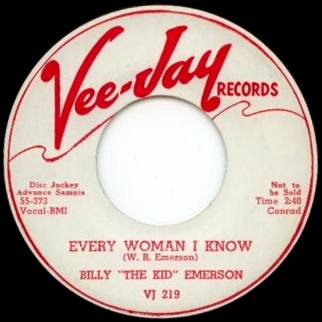
Billy Emerson went to record two more sessions for Vee-Jay in 1957. A later release (on Mad in 1962) also apparently came from a Vee-Jay session. The original master numbers and the studio group led by Riley Hampton indicate that several tracks were done for Vee-Jay in 1960 and later unloaded by the company. Most likely Emerson got the tapes back after Vee-Jay had lost interest in them. Billy Emerson subsequently recorded for USA, M-Pac!, and Constellation, as well as his own Tarpon label.
In later years, Emerson took a turn toward religion, becoming the Reverend William R. Emerson, with a church in Oak Park, Illinois. He is still alive as of this writing.
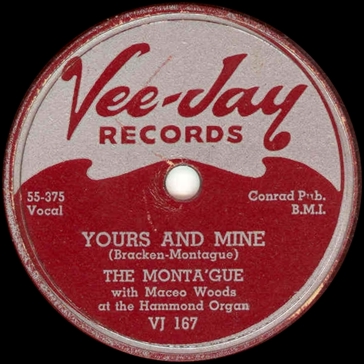
The Monta’gue was a popular disc jockey in Chicago on radio station WGES and WAAF. His full name was Nathaniel Montague. He first shortened his moniker to his last name, then became the Great Montague, which finally grew into the Magnificent Montague. Meanwhile, record labels variously credited him as "Montague," "Monta'gue," and "N. Nathan." He was born January 11, 1928, in Elizabeth, New Jersey. During much of the 1940s he was serving in the Merchant Marine, and by the late 1940s was deejaying on radio stations on the Eastern seaboard between Merchant Marine tours of duty. On leaving the Merchant Marine in 1954, he got into full-time deejaying in Texas. In the Spring of 1955, Montague joined WGES in Chicago. In August, still going as The Great Montague. he moved to WAAF, where he took the place of the late Freddie Williams.
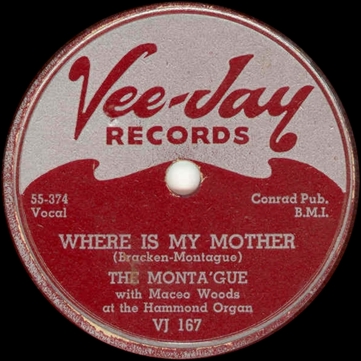
On the air Montague did not just play records. He recited poetry and delivered florid monologues on black uplift. His single on Vee-Jay 167, released in December 1955, is therefore somewhat of a curiosity. Dr. Robert Stallworth describes the sides as "monologues over a faint organ background. Like something you would have heard in Church back in the fifties. No drums, guitar or singing. No other voices." Both of Montague's released sides carry religious messages ("Yours and Mine" about different churches and their congregants getting along, "Where Is My Mother" about heaven); Montague preaches them in measured tones, without raising his voice. The accompanist is credited on the label as "Maceo Woods at the Hammond Organ." Though Vee-Jay had significantly reduced its gospel promotion in the trade papers, 167 was advertised in Cash Box on December 24, 1955 (p. 27), barely in time for Christmas. Ewart Abner was promoting the record on December 31 (p. 19; "Montague reportedly excels at narrations"). Cash Box reviewed it on January 21, 1956 (p. 35).
Vee-Jay indulged in no further monologues by Montague. But he would keep being featured in company publicity for most of the following year. He mentored the Magnificents, who produced a national hit, "Up on the Mountain." He was also around to promote the second edition of the Magnificents. The Great Montague was still in Chicago in December 1956 (Cash Box, December 15, p. 36). However, on February 23, 1957, Cash Box announced that on February 25 Jesse Owens would be taking over Montague's morning and afternoon spots (p. 34)
In September 1957 Montague was working in San Francisco. After a spell in New York City and a return to Chicago, Montague became a top deejay at WGFJ in Los Angeles, where as part of his spiel he coined an electrifying slogan, "Burn, Baby! Burn!’ The slogan went down in history when it was unfortunately adopted by the looters in the Watts Riots of 1965.
Montague subsequently advocated nonviolence on the air and changed his slogan to "Learn, baby! Learn!" In the 1970s, he opened an easy-listening station, KPLM in Palm Springs. His autobiography, under the inevitable title of Burn, baby! BURN! was published by the University of Illinois Press in 2003.
Vee-Jay in 1955 significantly increased its productivity, recording some 166 sides, and picking up 4 more from Chance. Releases ran from Vee-Jay 120 through Vee-Jay 168 (Vee-Jay 166 was probably intended for release before year's end, but it was postponed till February 1956). With 48 on the year, Vee-Jay more than doubled the output from its entire first year and a half. Still, many items recorded in the second half of 1955 were held for release in 1956. Vee-Jay got five national hits: one from the Spaniels, two from Jimmy Reed, one from Priscilla Bowman and Jay McShann, and one from the El Dorados. The last two were #1 hits. The El Dorados’ record ("At My Front Door") was a big crossover rock ‘n’ roll hit as well. Vee-Jay had emerged as a major factor in the R&B market, and could look forward to an even more prosperous 1956.
| 55-227 | Eddie Taylor | Bad Boy | Vee-Jay 149 | Jan 18, 1955 | Aug 1955 |
| 55-228 | Eddie Taylor | E.T. Blues | Vee-Jay 149 | Jan 18, 1955 | Aug 1955 |
| 55-229 | Jimmy Reed | You Upset My Mind | (Charly LP 1013) | Jan 18, 1955 | |
| 55-230 | Jimmy Reed | I'm Gonna Ruin You | (Vee-Jay NVD2-718) | Jan 18, 1955 | |
| 55-231 | Jimmy Reed | Pretty Thing | rejected | Jan 18, 1955 | |
| 55-232 | Wardell Gray Quintette | Sweet Mouth | (Top Rank RLP 111) | Jan 19, 1955 | |
| 54-233[sic] 55-233 |
Wardell Gray and his Quintette | Oscar’s Blues | Vee-Jay 135 | Jan 19, 1955 | Apr 1955 |
| 55-234 | Wardell Gray Quintette | Dat’s It | (Top Rank RLP 111) | Jan 19, 1955 | |
| 54-235[sic] 55-235 |
Wardell Gray and his Quintette | Hey There | Vee-Jay 135 | Jan 19, 1955 | Apr 1955 |
| 55-236 | L. C. McKinley | Good Lover Blues | unissued | Jan 25, 1955 | |
| 55-237 | L. C. McKinley | Strange Girl | Vee-Jay 133 | Jan 25, 1955 | Apr 1955 |
| 55-238 | L. C. McKinley | Blue Evening | unissued | Jan 25, 1955 | |
| 55-239 | L. C. McKinley | She’s Five Feet Three | Vee-Jay 133 | Jan 25, 1955 | Apr 1955 |
| 55-240 | The Spaniels | Don’cha Go | Vee-Jay 131 | Feb 19, 1955 | Apr 1955 |
| 55-241 | The Dells | Tell the World | Vee-Jay 134 | Feb 19, 1955 | Apr 1955 |
| 55-242 | The Dells | Goodbye | unissued | Feb 19, 1955 | |
| 55-243 | Tommy "Deanie Boy" Dean | The Gold Coast | Vee-Jay 218 | Feb 17, 1955 | Dec 1956 |
| 55-244 | Big Jay McNeely | All Night Long | unreleased | March 15, 1955 | |
| 55-245 | Big Jay McNeely | Jay’s Rock | Vee-Jay 212 | March 15, 1955 | Sept 1956 |
| 55-246 | Big Jay McNeely | Big Jay’s Hop | Vee-Jay 142 | March 15, 1955 | June 1955 |
| 55-247 | Big Jay McNeely | Three Blind Mice | Vee-Jay 142 | March 15, 1955 | June 1955 |
| 55-230 [sic] on 45 and some 78s 55-248 on 78 |
Jimmy Reed | I’m Gonna Ruin You | Vee-Jay 132 | March 24, 1955 | Apr 1955 |
| 55-231 [sic] on 45 and some 78s 55-249 on 78 |
Jimmy Reed | Pretty Thing | Vee-Jay 132 | March 24, 1955 | Apr 1955 |
| 55-250 | Jimmy Reed | instrumental | unissued | March 24, 1955 | |
| 55-251 | Jimmy Reed | Come On Baby | unissued | March 24, 1955 | |
| 55-252 | Al Smith & His Orchestra | Boots Up | unissued | April 24, 1955 | |
| 55-253 | Al Smith & His Orchestra | Jump Up | unissued | April 24, 1955 | |
| 55-254 | Hazel McCollum | Just like I Like It | unissued | April 24, 1955 | |
| 55-255 | Hazel McCollum | Lovin’ Time | unissued | April 24, 1955 | |
| 55-256 | The El Dorados with Al Smith's Orchestra | I Began to Realize | Vee-Jay 165 | April 24, 1955 | Dec 1955 |
| 55-257 | The El Dorados | At My Front Door | Vee-Jay 147 | April 24, 1955 | Jul 1955 |
| 55-258 | The Rhythm Aces | Whisper to Me | Vee-Jay 138 | late April 1955 | May 1955 |
| 55-259 | The Rhythm Aces | Flippety Flop | Vee-Jay 160 | late April 1955 | Nov 1955 |
| 55-260 | The Rhythm Aces | Olly, Olly, Atsen, Free | Vee-Jay 138 | late April 1955 | May 1955 |
| 55-261 | The Rhythm Aces | That’s My Sugar | Vee-Jay 160 | late April 1955 | Nov 1955 |
| 55-261 | The Rhythm Aces | That’s My Sugar | Vee-Jay 160 | late April 1955 | Nov 1955 |
| 55-261 [alt.] | The Rhythm Aces | That’s My Sugar | Vee-Jay NVD2-715 [CD], Famous Groove 971010 [CD] | late April 1955 | |
| 55-262 | Billy Boy [Arnold] | I Was Fooled | Vee-Jay 146 | May 5, 1955 | Jun 1955 |
| 55-263 | Billy Boy | I Wish You Would | Vee-Jay 146 | May 5, 1955 | Jun 1955 |
| 55-264 | Earl Phillips | Oop De Oop | Vee-Jay 158 | May 5, 1955 | Dec 1955 |
| 55-265 | Earl Phillips | Nothing but Love | Vee-Jay 158 | May 5, 1955 | Dec 1955 |
| 55-266 | Morris Pejoe | You Gonna Need Me | Vee-Jay 148 | May 5, 1955 | Aug 1955 |
| 55-267 | Morris Pejoe | Hurt My Feelings | Vee-Jay 148 | May 5, 1955 | Aug 1955 |
| 55-268 | Singing Sammy Lewis | Jesus Paid It | Vee-Jay 151 | May 22, 1955 | c. Oct 1955 |
| 55-269 | Singing Sammy Lewis | Jesus Brighten Up My Life | Vee-Jay 151 | May 22, 1955 | c. Oct 1955 |
| 55-270 | The Highway QC’s | Every Man, Woman and Child | (Vee-Jay LP 5005) | May 22, 1955 | |
| 55-271 | The Highway Q-C’s | Somewhere to Lay My Head | Vee-Jay 150 | May 22, 1955 | Oct 1955 |
| 55-272 | The Highway QC’s | Nobody Knows | (Vee-Jay LP 5043) | May 22, 1955 | |
| 55-273 | The Highway Q-C’s | Pray | Vee-Jay 150 | May 22, 1955 | Oct 1955 |
| 55-274 | The El Dorados | What's Buggin' You Baby | Vee-Jay 147 | June 8, 1955 | Jul 1955 |
| 55-275 | The El Dorados with Al Smith's Orchestra | Now That You've Gone | Vee-Jay 180 | June 8, 1955 | Apr 1956 |
| 55-276 | Knights of Rhythm | Forever Loving You | unissued | June 8, 1955 | |
| 55-277 | Knights of Rhythm | Lorrie | unissued | June 8, 1955 | |
| 55-278 | Julian Dash Combo | Zero | Vee-Jay 144 | June 22, 1955 | Nov 1955 |
| 55-279 | Julian Dash Combo | Rhythm Punch | Vee-Jay 144 | June 22, 1955 | Nov 1955 |
| 55-280 | Julian Dash Combo | Ballad | unissued | June 22, 1955 | |
| 55-281 | Julian Dash Combo | Mambo No. 2 | unissued | June 22, 1955 | |
| 55-282 | The Famous Boyer Bros. | Lord Be My Protector | Vee-Jay 209 | June 1955 | Oct 1956 |
| 55-283 | The Famous Boyer Brothers | Until Jesus Comes | unissued | Jun 1955 | |
| 55-284 | The Famous Boyer Brothers | He’s My Solid Rock | Vee-Jay 163 | Jun 1955 | Dec 1955 |
| 55-285 | The Famous Boyer Brothers | He Heard Me | unissued | Jun 1955 | |
| 55-286 | The Famous Boyer Brothers | One More Time | unissued | Jun 1955 | |
| 55-287 | The Famous Boyer Brothers | This May Be the Last Time | unissued | Jun 1955 | |
| 55-288 | The Famous Boyer Brothers | His Eyes on the Sparrow | unissued | Jun 1955 | |
| 55-289 | Tommy Deans Orch. [sic] | Straight and Ready | Vee-Jay 172 | Jul 11, 1955 | Feb 1956 |
| 55-290 | Tommy "Deanie Boy" Dean | Skid Row | Vee-Jay 218 Vee-Jay 339 |
Jul 11, 1955 | Dec 1956 1960 |
| 55-291 | Joe Buckner with Tommy Deans Orch. | One More Mile | Vee-Jay 172 | Jul 11, 1955 | Feb 1956 |
| 55-292 | Tommy Dean | Come Home Baby | unissued | Jul 11, 1955 | |
| 55-293 | Jimmy Reed | I Ain’t Got You | (Vee-Jay LP 1022) | Jul 18, 1955 | |
| 55-293 [alt.] | Jimmy Reed | I Ain’t Got You | (Vee-Jay LP 7303) | July 18, 1955 | |
| 55-294 | Jimmy Reed | She Don’t Want Me No More | Vee-Jay 153 | Jul 18, 1955 | Aug 1955 |
| 55-295 | Jimmy Reed | Come On Baby | (Vee-Jay LP 7303) | Jul 18, 1955 | |
| 55-296 | Jimmy Reed | I Don’t Go for That | Vee-Jay 153 | Jul 18, 1955 | Aug 1955 |
| 55-296 [alt.] | Jimmy Reed | I Don’t Go for That | (Vee-Jay LP 7303) | Jul 18, 1955 | |
| 55-297 | The Spaniels | False Love | unissued | c. Jul 23, 1955 | |
| 55-298 | The Spaniels | Painted Picture [first pressing] You Painted Pictures |
Vee-Jay 154 | c. Jul 23, 1955 | Aug 1955 |
| 55-299 | The Spaniels | Hey, Sister Lizzie | Vee-Jay 154 | c. Jul 23, 1955 | Aug 1955 |
| 55-300 | L. C. McKinley | My Eyes Jumped Out | unissued | Aug 18, 1955 | |
| 55-301 | L. C. McKinley | I’m So Satisfied | Vee-Jay 159 | Aug 18, 1955 | Nov 1955 |
| 55-302 | L. C. McKinley | Down with It | unissued | Aug 18, 1955 | |
| 55-303 | L. C. McKinley | Lonely | Vee-Jay 159 | Aug 18, 1955 | Nov 1955 |
| 55-304 | Dolores Washington | In My Home Over There | Vee-Jay 162 | Aug 21, 1955 | c. Nov 1955 |
| 55-305 | Dolores Washington | I Trust in God | Vee-Jay 162 | Aug 21, 1955 | c. Nov 1955 |
| 55-306 | Maceo Woods at the Hammond Organ | When the Saints Go Marching In | Vee-Jay 157 | Aug 21, 1955 | c. Nov 1955 |
| 55-307 | Maceo Woods at the Hammond Organ | Near the Cross | Vee-Jay 157 | Aug 21, 1955 | c. Nov 1955 |
| 55-308 | Maceo Woods Singers | What Could I Do | unissued | Aug 21, 1955 | |
| 55-309 | Maceo Woods Singers | Come Out of the Wilderness | unissued | Aug 21, 1955 | |
| 55-310 | The Rasberry Singers | Just a Closer Walk with Thee | (Vee-Jay LP 5043) | Aug 31, 1955 | |
| 55-311 | The Rasberry Singers | I Want to Be More like Jesus | Vee-Jay 161 | Aug 31, 1955 | c. Nov 1955 |
| 55-312 | The Rasberry Singers | Happy over There | Vee-Jay 161 | Aug 31, 1955 | c. Nov 1955 |
| 55-313 | The Rasberry Singers | Come out of the Wilderness | unissued | Aug 31, 1955 | |
| 55-314 | Vocalist Priscilla Bowman | Jay McShann's Orchestra | Hands Off | Vee-Jay 155 | Sept 4, 1955 | Oct 1955 |
| 55-314 [alt.] | Vocalist Priscilla Bowman | Jay McShann's Orchestra | Hands Off | (Sounds Great LP 5008) | Sept 4, 1955 | |
| 55-315 | Priscilla Bowman and Jay McShan [sic] | Hootie Blues | Vee-Jay 213 | Sept 4, 1955 | Nov 1956 |
| 55-315 [alt. tk 1] | Priscilla Bowman and Jay McShann | Hootie Blues | (P-Vine PCD 5273 [CD]) | Sept 4, 1955 | |
| 55-315 [alt. tk 2] | Priscilla Bowman and Jay McShann | Hootie Blues | (Sounds Great LP 5008) | Sept 4, 1955 | |
| 55-316 | Priscilla Bowman and Jay McShann | I Don’t Need Your Lovin' | unissued | Sept 4, 1955 | |
| 55-317 | Vocalist Priscilla Bowman | Jay McShann's Orchestra | Another Night | Vee-Jay 155 | Sept 4, 1955 | Oct 1955 |
| 55-318 | Priscilla Bowman and Jay McShann | Don’t Treat Me This Way | unissued | Sept 4, 1955 | |
| 55-319 | Priscilla Bowman and Jay McShann | Tortured | (Sounds Great LP 5008) | Sept 4, 1955 | |
| 55-320 | Jay McShann | Jay’s Jam | Vee-Jay 191 | Sept 4, 1955 | Jun 1956 |
| 55-321 | Jay McShann | Four Plus | Vee-Jay 191 | Sept 4, 1955 | Jun 1956 |
| 55-322 | The Dells | I Can’t Help Myself | (Solid Smoke LP 8029) | Sept 15, 1955 | |
| 55-323 | The Dells with Al Smith's Orch. | Zing Zing Zing | Vee-Jay 166 | Sept 15, 1955 | Feb 1956 |
| 55-324 | The Dells with Al Smith's Orch. | Dreams of Contentment | Vee-Jay 166 | Sept 15, 1955 | Feb 1956 |
| 55-325 | The Dells | She’s Just an Angel | (Charly CRB 1055) | Sept. 15, 1955 | |
| 55-326 | King Kolax & His Orchestra | Those Rhythm And Blues | (Top Rank [Fr] RLP 110) | Sept 16, 1955 | |
| 55-326 [alt.] | King Kolax & His Orchestra | Those Crazy Rhythm 'n' Blues | (Charly CRB 1043) | Sept 16, 1955 | |
| 55-327 | King Kolax & His Orchestra | H2O | (Top Rank [Fr] RLP 110) | Sept 16, 1955 | |
| 55-328 | King Kolax & His Orchestra | Traveling | unissued | Sept 16, 1955 | |
| 55-329 | King Kolax & His Orchestra | Time | (Top Rank [Fr] RLP 110) | Sept 16, 1955 | |
| 55-330 | King Kolax & His Orchestra | Enchanted Moods | unissued | Sept 16, 1955 | |
| 55-331 | King Kolax & His Orchestra | Four Dimensions | unissued | Sept 16, 1955 | |
| 55-332 | Baby Face Willett [sic] | Why | Vee-Jay 176 | Sept 29, 1955 | c. Feb 1956 |
| 55-333 | Baby Face Willett | Can’t Keep from Lovin You | Vee-Jay 176 | Sept 29, 1955 | c. Feb 1956 |
| 55-334 | Baby Face Willette | The Thrill of Love | unissued | Sept 29, 1955 | |
| 55-335 | Baby Face Willette | My Baby’s Gone | unissued | Sept 29, 1955 | |
| 55-336 | John Lee Hooker | Unfriendly Woman | Vee-Jay 265 | Oct 19, 1955 | 1957 |
| 55-337 | John Lee Hooker | Wheel and Deal | unissued | Oct 19, 1955 | |
| 55-338 | John Lee Hooker | Mambo Chillun | Vee-Jay 164 | Oct 19, 1955 | Dec 1955 |
| 55-339 | John Lee Hooker | Time Is Marching | Vee-Jay 164 | Oct 19, 1955 | Dec 1955 |
| 55-340 | The El Dorados with Al Smith's Orchestra | I’ll Be Forever Loving You | Vee-Jay 165 | Oct 21, 1955 | Dec 1955 |
| 55-341 | The El Dorados | She Don’t Run Around | (Vee-Jay NVD2-702) | Oct 21, 1955 | |
| 55-342 | Al Smith and His Orchestra | Buttermilk | unissued | Spring 1953 [Gallatin, Tennessee] |
|
| 55-343 | Al Smiths Combo | Fooling around Slowly | Vee-Jay 174 | Spring 1953 [Gallatin, Tennessee] |
Jun 1956 |
| 55-343 [alt.] | Al Smith and His Orchestra | Fooling around Slowly [alt.] | (Charly CRB 1043) | Spring 1953 [Gallatin, Tennessee] |
|
| 55-344 | Billy Boy [Arnold] | Don’t Stay Out All Night | Vee-Jay 171 | Oct 1955 | Feb 1956 |
| 55-345 | Billy Boy [Arnold] | I Ain’t Got You | Vee-Jay 171 | Oct 1955 | Feb 1956 |
| 55-346 | Billy Boy | Here’s My Picture | Vee-Jay 192 | Oct 1955 | Jun 1956 |
| 55-347 | Billy Boy | You’ve Got Me Wrong | Vee-Jay 192 | Oct 1955 | Jun 1956 |
| 55-348 | Earl Phillips | untitled | unissued | Oct 1955 | |
| 55-349 | Staple Singers | Each Day | (Vee-Jay LP 5030) | Nov 1, 1955 | |
| 55-350 | Staple Singers | So Soon | unissued | Nov 1, 1955 | |
| 55-351 | The Staple Singers | If I Could Hear My Mother | Vee-Jay 169 | Nov 1, 1955 | c. Jan 1956 |
| 55-352 | The Staple Singers | God’s Wonderful Love | Vee-Jay 169 | Nov 1, 1955 | c. Jan 1956 |
| 55-353 | Staple Singers | Calling Me | unissued | Nov 1, 1955 | |
| 55-354 | Staple Singers | I’ve Got a New Home | unissued | Nov 1, 1955 | |
| 55-355 | The Kool Gents | Do Ya Do | Vee-Jay 173 | Nov 3, 1955 | May 1956 |
| 55-355 [alt.] | The Kool Gents | Do Ya Do [alt.] | (Vee-Jay NVD2-715 [CD]) | Nov. 3, 1955 | |
| 55-356 | The Kool Gents | Crazy over You | (Solid Smoke LP 8026) | Nov 3, 1955 | |
| 55-357 | The Kool Gents | You Know | Vee-Jay 207 | Nov 3, 1955 | Sept 1956 |
| 55-357 [alt] | The Kool Gents | You Know [alt.] | (Vee-Jay NVD2-715 [CD]) | Nov 3, 1955 | |
| 55-358 | The Kool Gents | This Is the Night | Vee-Jay 173 | Nov 3, 1955 | May 1956 |
| 55-359 | Jimmy Reed | Lovin’ You Baby | unissued | Nov 9, 1955 | |
| 55-360 | Jimmy Reed | untitled | unissued | Nov 9, 1955 | |
| 55-361 | Ben Imon | I Really Love You | Vee-Jay 177 | Nov 10, 1955 | c. Feb 1956 |
| 55-362 | Ben Imon | Down in the Country | Vee-Jay 177 | Nov 10, 1955 | c. Feb 1956 |
| 55-363 | Dizzy Dixon with Al Smith's Orchestra | Can't Afford It | unissued | mid-Nov. 1955 | |
| 55-364 | Dizzy Dixon with Al Smiths Combo | Soup Line | Vee-Jay 174 | mid-Nov. 1955 | Jun 1956 |
| 55-364 [alt.] | Dizzy Dixon with Al Smith's Orchestra | Soup Line [alt.] | (Vee-Jay NVD2-718 [CD]) | mid-Nov. 1955 | |
| 55-365 | Maceo Woods | Near the Cross | unissued | prob. Nov 23, 1955 | |
| (U 5152) 55-366 |
J.B. Hutto | Price of Love | unissued | October 19, 1954 | |
| (U 5153) 55-367 |
J.B. Hutto | Things Are So Slow | Chance 1165 Vee-Jay unissued |
October 19, 1954 | |
| (U 5154) 55-368 |
J.B. Hutto | Dim Lights | Chance 1165 Vee-Jay unissued |
October 19, 1954 | |
| (U 5155) 55-369 |
J.B. Hutto | Thank You for Your Kindness | unissued | October 19, 1954 | |
| 55-370 | Billy "The Kid" Emerson | Tomorrow Never Comes | Vee-Jay 219 | Nov 22, 1955 | Nov 1956 |
| 55-371 | Billy "The Kid" Emerson | Don’t Start Me to Lying | Vee-Jay 175 | Nov 22, 1955 | Jun 1956 |
| 55-372 | Billy "The Kid" Emerson | You Won’t Stay Home | Vee-Jay 175 | Nov 22, 1955 | Jun 1956 |
| 55-373 | Billy "The Kid" Emerson | Every Woman I Know | Vee-Jay 219 | Nov 22, 1955 | Nov 1956 |
| 55-374 | The Monta’gue with Maceo Woods at the Hammond Organ | Where Is My Mother | Vee-Jay 167 | Nov 23, 1955 | Dec 1955 |
| 55-375 | The Monta’gue with Maceo Woods at the Hammond Organ | Yours and Mine | Vee-Jay 167 | Nov 23, 1955 | Dec 1955 |
| 55-376 | The Monta’gue with Maceo Woods at the Hammond Organ | I Can Hear My Mother Praying | unissued | Nov 23, 1955 | |
| 55-377 | Maceo Woods at the Hammond Organ | Steal Away | Vee-Jay 170 | Nov 23, 1955 | Jan 1956 |
| 55-378 | Maceo Woods | Canaan Land | (Vee-Jay LP 5001) | Nov 23, 1955 | |
| 55-379 | Maceo Woods | Old Ship of Zion | (Vee-Jay LP 5001) | Nov 23, 1955 | |
| 55-380 | Maceo Woods at the Hammond Organ | Precious Lord | Vee-Jay 170 | Nov 23, 1955 | Jan 1956 |
| 55-381 | Maceo Woods | Old Rugged Cross | (Vee-Jay LP 5001) | Nov 23, 1955 | |
| 55-382 | Jimmy Reed | Baby, Don’t Say That No More | Vee-Jay 168 | Dec 5, 1955 | Dec 12, 1955 |
| 55-383 | Jimmy Reed | Ain’t That Lovin’ You Baby | Vee-Jay 168 | Dec 5, 1955 | Dec 12, 1955 |
| 55-384 | Jimmy Reed | Can’t Stand to See You Go | Vee-Jay 186 | Dec 5, 1955 | Apr 1956 |
| 55-385 | Eddie Taylor | Ride Em on Down | Vee-Jay 185 | Dec 5, 1955 | May 1956 |
| 55-386 | Eddie Taylor | Bigtown Playboy | Vee-Jay 185 | Dec 5, 1955 | May 1956 |
Vee-Jay continued to strengthen its gospel lineup with the addition of the Argo Singers (an all-female ensemble), the Original Five Blind Boys, the Spiritualaires of Columbia, S.C., the Kelly Brothers, the Silver Quintette, the Helen Robinson Youth Chorus, and the legendary Swan Silvertones. Doowop groups added in 1956 were the Magnificents, the Hi-Liters, and Orioles. Blues signings expanded as well, with Pee Wee Crayton and Snooky Pryor coming into the fold. The most significant jazz act added in 1956 was Sarah McLawler and Richard Otto. Other signings included boogie woogie pianist Camille Howard, veteran local musician Duke Groner, a one-off session with the great tenor saxophonist Arnett Cobb featuring two blues vocalists, Edith Mackey and Danny Cobb, and a one-off session featuring two of the top bar-walking saxophonists, Paul "Hucklebuck" Williams and Noble "Thin Man" Watts.
As the new year started, Vee-Jay thought it had Cliff Butler on its roster. The blues singer (and DJ at WLOU in Louisville, Kentucky) had previously recorded in Chicago for States. Something happened, because the announcement in Cash Box (January 21, 1956, p. 31) was not followed by a recording session. By July, Butler had a release out on King (Cash Box, August 4, 1956, p. 28).
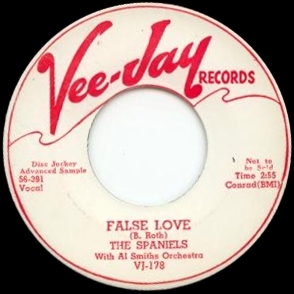
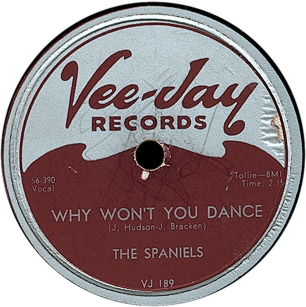
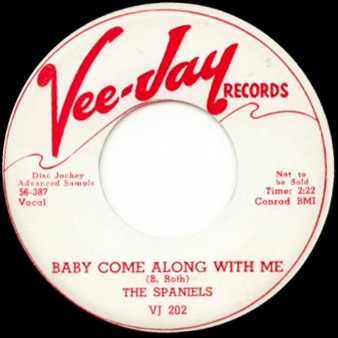
Vee-Jay launched its recording program in 1956 with a five-number session on the Spaniels in January. Members on the group on this occasion were James "Pookie" Hudson, James "Dimples" Cochran, Willis C. Jackson, and Gerald Gregory. Al Smith and his band provided the backing. Despite the quality accompaniment that featured Red Holloway and Mac Easton, the session produced no hits. All five tracks saw release, but the songs were weak.
First out of the chute was Vee-Jay 178, with "Do You Really" and the remade "False Love." There were high hopes for the record, which was pushed out to the distributors in around 10 days (Ewart Abner told Cash Box, February 4, 1956, p. 33, that the single was out "last week"). On February 11 (p. 37), Abner claimed encouraging sales in New York and Philadelphia. Vee-Jay 178 was advertised in Cash Box on February 11 (p. 39), February 18 (p. 30, by itself), and February 25, 1956 (p. 34). It was reviewed on March 17 (p. 39) and advertised again in Cash Box on March 24 (p. 30).
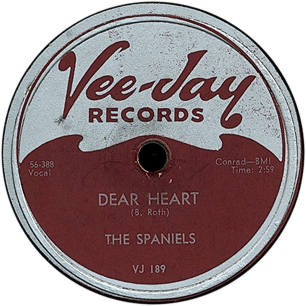
Two further sides from the session were used on Vee-Jay 189, which came out in May. "Dear Heart" and "Why Won't You Dance" were first advertised in Cash Box (with 6 other new releases) on May 12, 1956 (p. 64). The review arrived in Cash Box for May 26 (p. 33), along with a second ad (p. 29). There was a solo ad in Cash Box for June 2 (p. 27); no real promotion after that.
Instead, the company moved along to another next Spaniels release, The fifth side from January 1956, "Baby Come Along with Me," was used for Vee-Jay 202, a July release. The other side was a blast from the past: "Since I Fell for You," from the group's (and the label's) very first session of May 4, 1953. Vee-Jay 202 was reviewed in Cash Box on July 28, 1956 (p. 83). It was included in a big company ad for the NAMM Convestion, in the same issue (p. 79) and readvertised on August 4 (p. 31). The single wasn't moving well enough to justify further advertising.
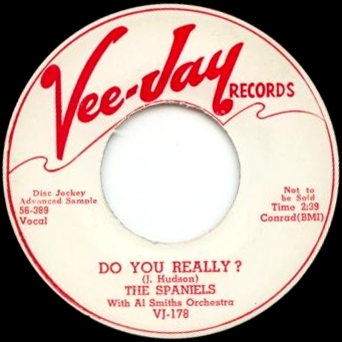


Things were much different when the Spaniels entered the studio again, on November 5, 1956. A new lineup was featured, consisting of Pookie Hudson, Carl Rainge, Don Porter, James "Dimples" Cochran, and Gerald Gregory. The Al Smith band accompanied the group. Lucius Washington is responsible for the tenor sax solo on "You Gave Me Peace of Mind." The song—virtually a note for note rendition of a gospel tune made famous by the Spirit of Memphis Quartet—was issued almost immediately, and became a hit. "Please Don't Tease" was the coupling.

Ewart Abner was talking about Vee-Jay 229 as part of a "special Thanksgiving package" (Cash Box, November 24, 1956, p. 32). The single was reviewed in Cash Box on December 22 (p. 38), pushed again in the year-end ad on December 29 (p. 41), and given solo ads on January 5 (p. 23) and January 12, 1957 (p. 34). Vee-Jay 229 was mentioned in a group ad on January 19, 1957 (Cash Box, p. 40) and again on February 2 (Cash Box, p. 41).
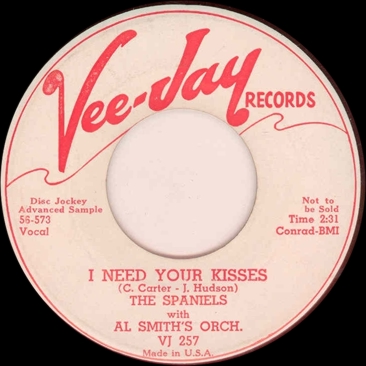
A further side from the November 5 session, "I Need Your Kisses," was used on the next Spaniels single, Vee-Jay 257.
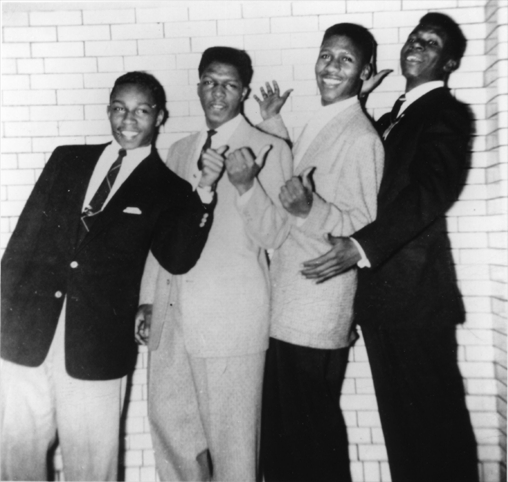
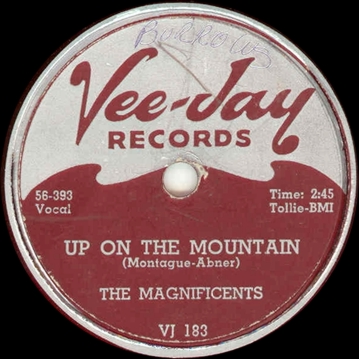
The Magnificents, a vocal group consisting of Johnny Keyes (tenor lead), Thurman "Ray" Ramsey (tenor), Fred Rakestraw (tenor), and Willie Myles (bass), were mentored by a local deejay, The Magnificent Montague (see above for Montague's own session). The group's first session took place in January of 1956. Montague's involvement with it was noted in Cash Box for February 4, 1956 (p. 33).
The January session yielded the group's only hit, "Up on the Mountain," a rousing rocker with a killer bass-line. It went to #9 on the Billboard R&B chart. "Why Did She Go," also from the first session, is a thoroughly solid ballad number that showed that the Magnificents were not just specialists in jump tunes. Vee-Jay 183 wasn't rushed out, despite Montague's claim (Cash Box, Feburary 25, 1956, p. 33) of a "release ready this week." Instead, the single was given a trial release at the end of April, only in Chicago (Cash Box, May 5, 1956, p. 32). Jimmy Bracken was satisfied with the trial, so the record was pushed as part of a "Lucky 7" ad on May 12 (Cash Box, p. 64). On May 19, Vee-Jay 183 was advertised to attendees at a disc jockeys' convention in Chicago (Cash Box, p. 29). The record was reviewed on May 26 (Cash Box, p. 32). As sales kept building, Vee-Jay 183 appeared in another company ad in Cash Box for June 9 (p. 33). It got further pushes on July 28 (p. 79), July 7 (p. 27), July 28 (p. 79), and on August 4 (p. 25, proclaiming that Cash Box and Vee-Jay had made it a hit).
The band featured the usual Al Smith regulars, with the apparent exception of Lefty Bates. Red Holloway solos on "Yes, She's My Baby." There are no solos on "Up on the Mountain," but Vernel Fournier gets some prominent drum fills.
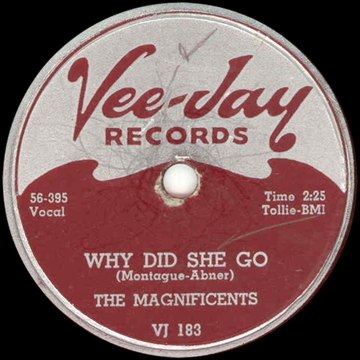
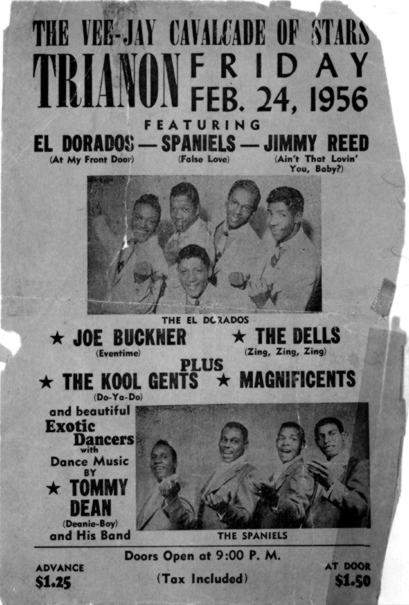
Even before they had any releases out, the company showed how much it expected from the Magnificents, including them in the "Vee-Jay Cavalcade of Stars," which opened at the Trianon Ballroom on February 24, 1956. Making up the rest of the cavalcade were the El Dorados, the Spaniels, the Kool Gents, the Dells, Jimmy Reed, and Joe Buckner, with accompaniment provided by Tommy Dean and his band. A holdover from older ways of entertaining were the "beautiful Exotic Dancers." Cavalcade was next in Milwaukee (February 25), then in Dallas, Texas (the 27th), with further concerts scheduled in Tucson and Phoenix. By April the tour had reached Seattle.
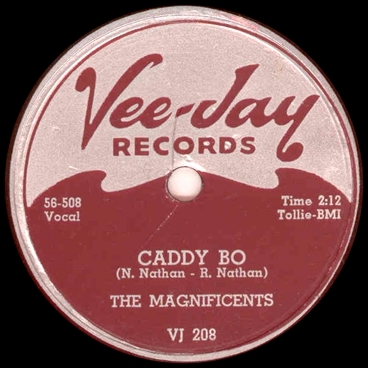
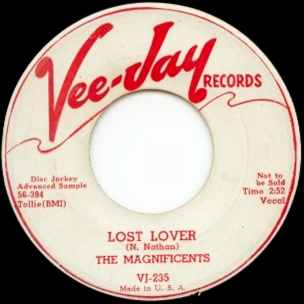
On July 13, the Magnificents returned for a second session, but something went amiss and all four sides were rejected. At a make-up session a few days later the same numbers were redone, leading to two singles, "Caddy Bo" and "Off the Mountain." For some reason, Montague thought a change was needed in the group, mainly the sound of a female voice. The new members were Barbara Arrington and L. C. Cooke, brother of Sam Cooke, while Ray Ramsey was out. Arrington sings lead on "Caddy Bo" (Vee-Jay 208), which was released in August 1956. The company didn't put a whole lot behind the single, which was mentioned just once in Cash Box (October 6, 1956, p. 34, as the group was on tour).
Keyes sings lead on "Off the Mountain" (Vee-Jay 235), which saw release in January 1957.
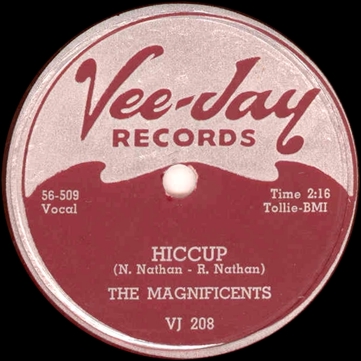
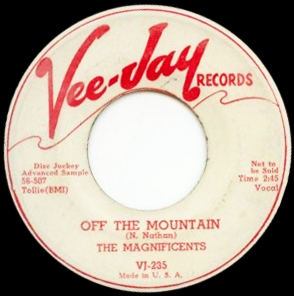
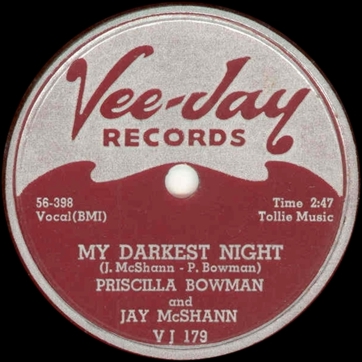
Priscilla Bowman appeared in the studio in January 1956 with the Jay McShann band to cut four more sides. The same band lineup was employed as on the 1955 session, with the addition of Art Mitchell on alto and baritone saxes. All four sides featured Bowman vocals. Clearly, Vee-Jay thought that Bowman was the more commercial artist of the two, and would record her solo in the future. However, none of the three released sides generated much in sales.
Vee-Jay 179, "I've Got News for You" b/w "My Darkest Night," was released the week of February 25, 1956 (Cash Box, p. 33), and reviewed in the March 3 issue (p. 32). The company ran a solo ad for 179 on March 17 (p. 37) and gave the record additional pushes on March 31 (p. 24) and April 14 (p. 36).
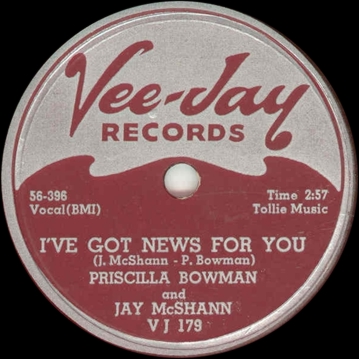
Vee-Jay 213, which used a third side from this session, "Don't Need Your Lovin'," was released in November 1956. Ewart Abner mentioned a Thanksgiving release on Priscilla Bowman (Cash Box, November 24, 1956, p. 32), but the company felt no urgency about promoting the single. Vee-Jay included 213 in Cash Box ads for January 19, 1957 (p. 40) and for February 2 (p. 36). Cash Box finally reviewed it on February 16, 1957 (p. 45).
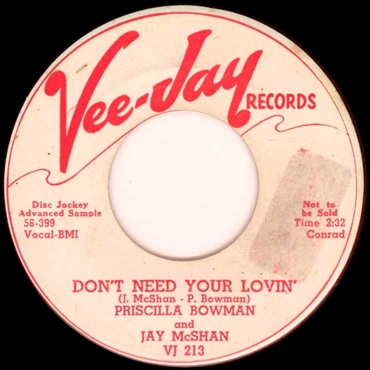
Vee-Jay had hopes for Priscilla Bowman as a solo artist. She recorded with the company’s house band in 1957, 1958, and 1959, enjoying notable artistic success if not commercial success. After her Vee-Jay stint, she was basically done with commercial recording. In the 1980s Bowman experienced something of a revival, playing the Kansas City Blues Festival, before she died in Kansas City on July 24, 1988.
In early February 1956, Vee-Jay recorded a block of 10 gospel numbers, 7 by the Newberry Singers, and three by the generically titled Gospel Singers, making for the biggest block of unissued tracks in the early history of the label. None of it has ever been issued, and we know nothing about the performers except that the Newberry Singers were from Philadelphia. Were the sides rejected for bad sound or poor performance, or is there something worth salvaging here?
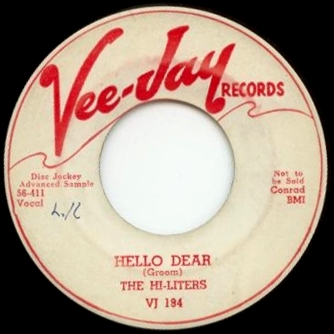
The Hi-Liters had recorded in New York City in Beltone Studios, on November 10, 1955. Elaborate secrecy attached to the operation; "Vee-Jay's top man, Jimmy Bracken, was in Manhattan to cut a brand new group. But Jimmy won't tell who, what, where or why and when. In fact, he's even holding back the group's name" (Cash Box, November 5, 1955, p. 27).
Maybe Bracken was less thrilled when the masters were in the can. It was not till February 1956 that Vee-Jay attached its own matrix numbers to them. The Hi-Liters were a Newark, New Jersey group, and consisted of George W. Vereen (first tenor), Wiseman Moon (first tenor), Furman Hayes (second tenor), Ivey E. Floyd (baritone), and Calvin Williams (baritone). Vereen and Floyd had both been members of the (Original) Kings of Harmony, who recorded for Savoy/King Solomon in the mid-1940s. After World War II, Vereen started a new group called the Four Deep Tones, which formed after World War II. The other founding members were Furman Hayes, Calvin Williams, Fletcher Smith, and Carroll Dean. The Four Deep Tones recorded for Muzicon (1946), King Solomon (1948), and Coral (1950), but afterwards, when Wiseman Moon and Ivey Floyd replaced Smith and Dean, the group changed its name to the Hi-Liters.
Vee-Jay 184 straggled out, underpromoted, around May 1956. The other two sides have never been issued. In 1958 the Hi-Liters recorded for their own HiCo label, and released four sides.
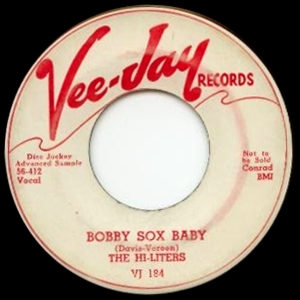
The El Dorados in 1956 were down to four members: Pirkle Lee Moses, Jewel Jones, Louis Bradley, and James Maddox. Vee-Jay took them into the studio three times that year, in February, in May, and in August. At each session, the Al Smith band provided the accompaniment.
Just one side came from the February session that interested the company, the uptempo "Rock N Roll's for Me" (Vee-Jay 180). "Rock N Roll's for Me" includes a guitar solo by Lefty Bates, a tenor sax solo by Red Holloway, and (unusually for an Al Smith-led doo-wop) a baritone sax solo by Mac Easton. Vee-Jay 180 was released in April 1956. It was talked up (p. 34) and advertised (p. 36) in the April 7, 1956 issue of Cash Box, then advertised on April 14 (p. 36). The review of Vee-Jay 180 also arrived on April 14 (p. 38). A solo ad followed on April 21 (p. 32), and Vee-Jay 180 was one of seven items in a company ad for May 12, 1955 (p. 64). Despite the effort, Vee-Jay 180 didn't sell nearly as well as Vee-Jay 165.
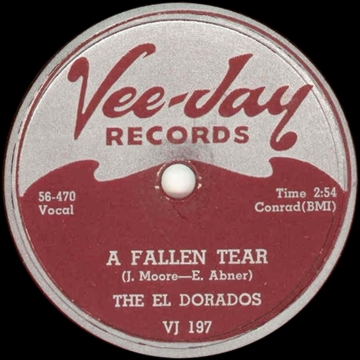
The El Dorados' May 22 session proved more successful, with three sides released from it. "A Fallen Tear" (released in June on Vee-Jay 197) featured a duet lead of Bradley and Maddox; the switch-off lead, and echoing tenor counterpointing, combined with some sweet harmonizing, demonstrated superbly the creative abilities of the group in vocal arranging. "Chop Ling Soon" (the flip to Vee-Jay 197) features Moses as lead. "A Fallen Tear" includes no instrumental solos.
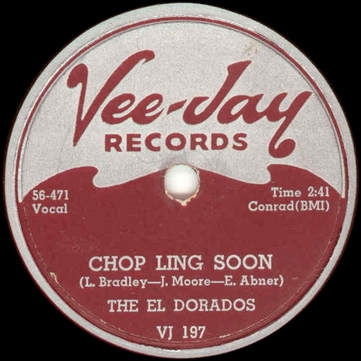
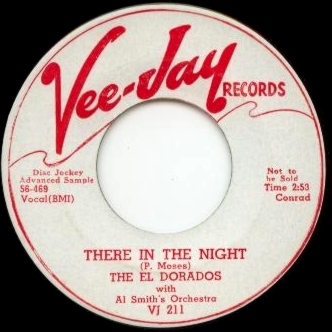
Although "A Fallen Tear" did well in a number of markets, it was still not a national hit. Vee-Jay 197 was first mentioned in Cash Box on June 30, 1956 (p. 26). It was reviewed on July 21 (p. 29) and given a solo ad on August 18 (p. 32).
Vee-Jay 197 was struggling on the sales front. In what looked like a desperation move, Vee-Jay decided to record the El Dorados on an "At My Front Door" sound-alike, called "Bim Bam Boom," on August 8, 1956. The entire session was focused on that one song. There wasn't any question about the strategy; on August 18 (p. 30), Cash Box reported that "El Dorados sessioned for Vee-Jay this past week. Abner discloses new side is similar sound to their first hit, 'At My Front Door.'" Unlike many contrived follow-up attempts, however, the song is a solid number and ranks as one of the group's best jumps. (Bim Bam Boom later served as a title for an East Coast doowop fanzine.)
"Bim Bam Boom" was released in October on Vee-Jay 211. The flip side included the beautiful ballad, "There in the Night," from the May session. Horace Palm plays celeste during the monologue on the song; Little Wash accompanies the vocals.
"Bim Bam Boom" paid off commercially. Vee-Jay first appended a mention of it to a company ad for "Oh What a Nite" by the Dells (Cash Box, October 13, 1956, p. 43). It got another push on October 20 (p. 26), was reviewed on November 3 (p. 37), and got an ad that reprinted the review on November 10 (p. 31; in the same issue, p. 28, Jimmy Bracken paired Vee-Jay 204 and 211 in terms of sales potential).
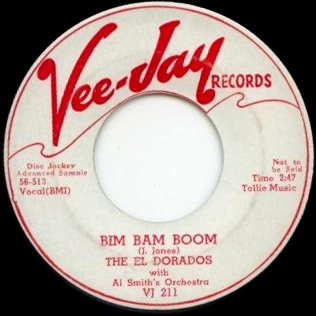
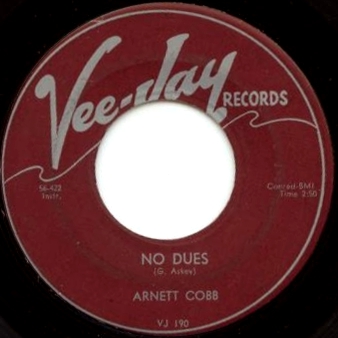
On February 17, 1956, Vee-Jay took into Universal Studio the great tenor sax player, Arnett Cobb, along with his band and two vocalists, Danny Cobb and Edith Mackey. Arnett Cobb was accompanied by his touring band: Ed Lewis (trumpet), Al Grey (trombone), Harold Cumberbatch (baritone and alto sax), Lloyd Mayers (piano), Jimmy Mobley (bass), and Al Jones (drums). The organist who was added for the Mackey tracks is unidentified. The session allotted two instrumental tracks to the band, two vocal tracks to Mackey, and two vocal tracks to Danny Cobb.
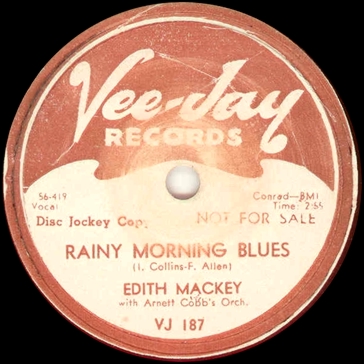
Edith Mackey recorded only one session in her career, this session for Vee-Jay. Mackey is valued by both jazz and blues fans, as she sings jump blues with a jazz backing. Cash Box reported on November 26, 1955 that "Jimmy Bracken of Vee-Jay back from East. Reports finding Edith McKay [sic], young blues songstress who won four amateur contests at the Savoy in New York. 'A cross between Dinah Washington and Ella Fitzgerald,' Jimmy reports" (p. 35). It took Bracken some time to find the right band to accompany Mackey and to get her and the band to Chicago. In Cash Box's Chicago R&B notes for March 3, 1956: "Bandleader Arnett Cobb in for Vee-Jay session" (p. 29).
While the Mackey release, although not common, is fairly well known, the Arnett Cobb single from the same session—released on Vee-Jay 190—is one of the rarest Vee-Jay records. For some time 190 was thought to be an unused number, although it is correctly listed in Lord's Jazz Discography. Collector Robert Stallworth has seen one copy of Vee-Jay 190, which is in his own collection.
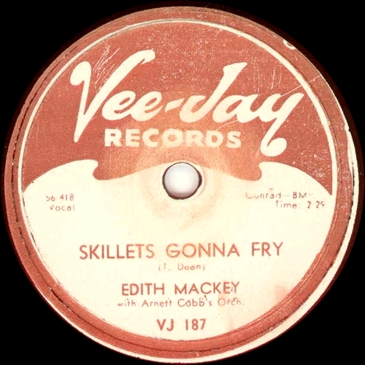
Following his Vee-Jay session, Cobb was badly hurt in a car accident, which left him on crutches the remainder of his life. The accident took place in Hartford, Connecticut, on April 23, 1956. Arnett Cobb, who had already recovered from one spinal injury, landed in Hatford Hospital, where he would have to lie flat on his back for a year ("Gigantic Benefit for Arnett Cobb to Take Place July 25 at the Savoy Ballroom," Cash Box, June 30, 1956, p. 27). His wife Elizabeth also suffered serious injuries in the wreck. On July 25, a benefit was held for Arnett and Elizabeth Cobb at the Savoy Ballroom in Harlem, with everyone from T-Bone Walker to Count Basie to Sammy Davis, Jr. in attendance. Vee-Jay sent a delegation. But with the leader laid up and no further sessions feasible before his contract would run out, Vee-Jay didn't see much point in promoting his records. Hence the extreme rarity of the instrumental record, Vee-Jay 190, which got no coverage in the trade papers, and the lack of push behind Edith Mackey's Vee-Jay 187, which got pretty scarce promotion. Meanwhile, the Danny Cobb sides were quietly shelved and have never been released.
When he was able to return to performing, Arnett Cobb recorded for Prestige (1959-60), Moodsville (1960), Home Cooking (1971), the French-based Black & Blue (1973-80), Progressive (1978-80), Muse (1978), Bee Hive (1984), Fantasy (1987), and Soul Note (1988). Arnett Cobb died on March 24, 1989.
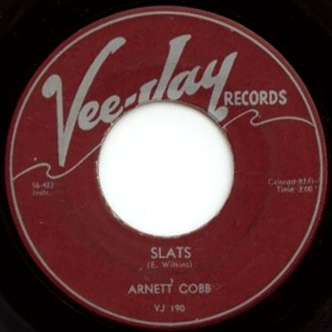
Danny Cobb, who apparently was no relation to Arnett, is said to have come from Greensboro, North Carolina. He first recorded in 1950 on Savoy with the Lucky Thompson Orchestra. Three more Savoy sessions followed, two in 1951 with Paul Williams and in 1952 with Dave McRae. He got a session for Jubilee in 1955. The Vee-Jay session followed in 1956. His last label affiliation was for DeLuxe, for whom he cut a four-song session in November 1956.
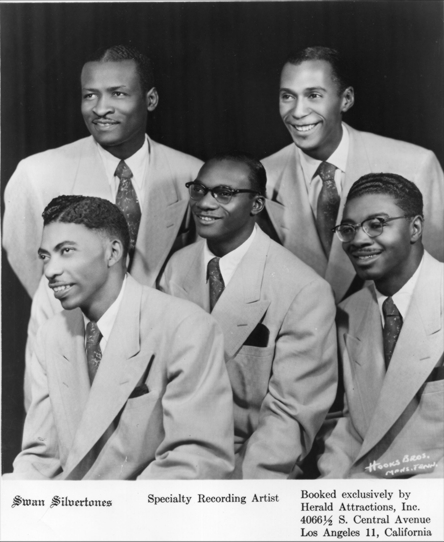
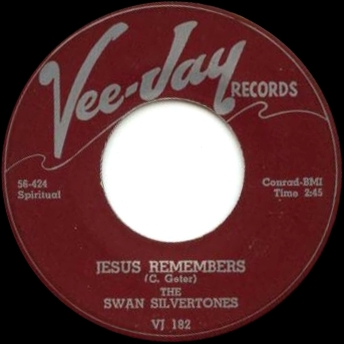
The Swan Silvertone Singers rank among the greatest groups of the golden age of gospel quartet singing. Members of the group for their first Vee-Jay session on February 28, 1956 were Claude Jeter (tenor and lead), Paul Owens (baritone and alternate lead), Dewey Young (baritone), John Myles (baritone), Henry Bossard (bass), and possibly John Manson (tenor). Jimmy Bracken announced the signing to Cash Box on March 10, 1956 (p. 29).
Differently from some other gospel performers, the Swan Silvertones got priority for their first release from the session. Vee-Jay 182 ("My Soul Is a Witness" b/w "Jesus Remembers") was reviewed in Cash Box on April 28, 1956 (p. 31) and advertised on the same date (p. 31). Vee-Jay 182 was included in an ad for 7 releases (Cash Box, May 12, 1956, p. 64) and showed up again in a big company ad for July 28 (p. 79).
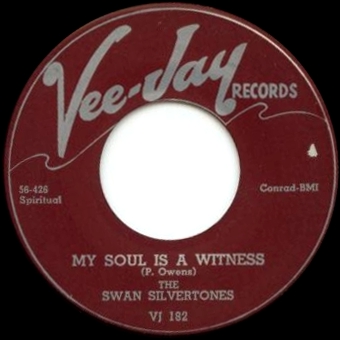
At their first session, the Swan Silvertones produced one of their greatest gospel numbers in the "The Lord's Prayer," released on Vee-Jay 232 in December 1956. With a coupling of "Great Day in December," 232 had to be out in time for Christmas—the company advertised it in Cash Box on December 22, 1956 (p. 33). It was reviewed on January 5, 1957 (p. 26).
Bob Marovich noted, "Spotlighting lead singer Claude Jeter's soaring tenor and the group's sparkling, tight harmonies, this rendition is reminiscent of a performance you might hear at a barbershop quartet competition. The Swans weave in and out of the melody with agility and vocal synchronicity, climaxing with a classic Jeter leap into the musical stratosphere." "The Lord's Prayer" was unaccompanied; on the other three items the Silvertones used an unidentified guitartist.
"Get Your Soul Right," which was never released on Vee-Jay, has appeared in error on three latter-day reissues of Vee-Jay 182: ABC 3418, Oldies 45 206, and (probably) Trip 9907; in each case the song is mislabeled "My Soul Is a Witness." (Our thanks to Jeff Willens for bringing the error on the Oldies release to our attention; see also Hayes and Laughton's Gospel Discogaphy, 2007 edition.)
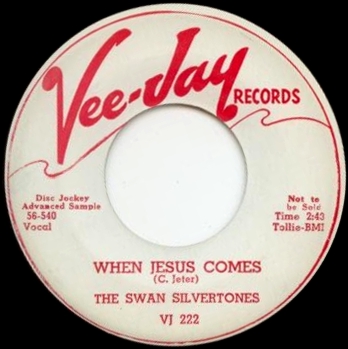
The Swan Silvertones were back on September 12 for a four-tune session, which produced their next single, Vee-Jay 222, and one side ("Great Day in December") of Vee-Jay 232.
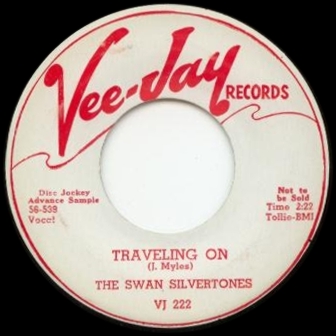
Vee-Jay 222, "Traveling On" b/w "When Jesus Comes," was part of a big batch of gospel releases in the fall. It was reviewed in Cash Box on November 10, 1956 (p. 33). The company first advertised it in Cash Box on November 17 (p. 39).
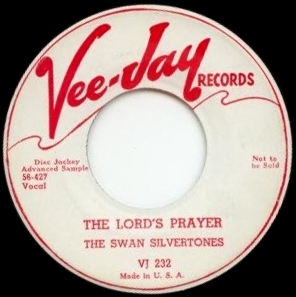
Normally the group's next release would have been held for a while, but with "Great Day in December" as a title, Vee-Jay 232 was advertised just in time, in Cash Box for December 22, 1956 (p. 33). The company mentioned it again in the year-ending ad for December 29 (Cash Box, p. 41).
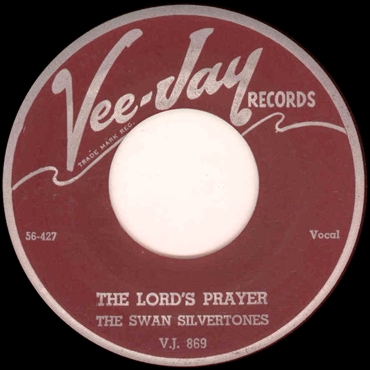
The Swan Silvertones became one of Vee-Jay’s most prolifically recorded gospel acts, recording subsequent sessions in February and December 1957, then every year from 1958 to 1965, essentially until the label shut down.
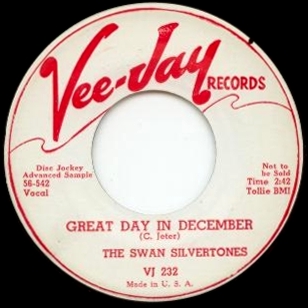
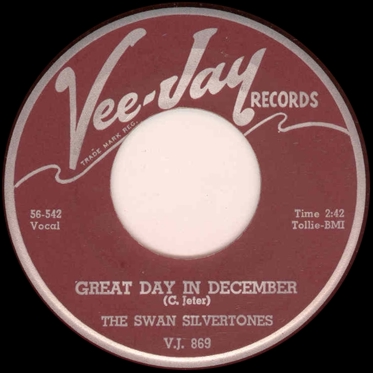
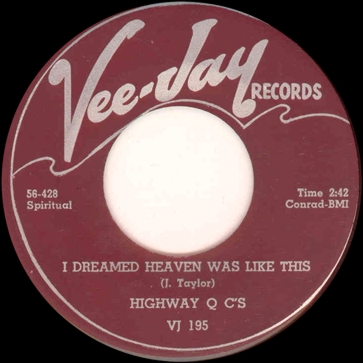
The Highway QC’s recorded one of their greatest sessions for Vee-Jay on March 6, 1956. It produced "I Dreamed Heaven Was like This." Regarding the song, Bob Marovich, remarked, "Johnnie Taylor has the Cooke sound down, complete with Sam's trademark yodel, vocal curlicues and lispy delivery. He sings effortlessly, propelling the QC’s behind him to keep up with his swift, finger-popping pace. It is obvious the group is extremely comfortable with each other displaying a tightness and crispness that rivals the more established and famous Soul Stirrers." Taylor can also be heard as lead on "I’ll Trust His Word" and "He Lifted My Business." A new member, baritone Spencer Taylor, led on "I Was So Happy."
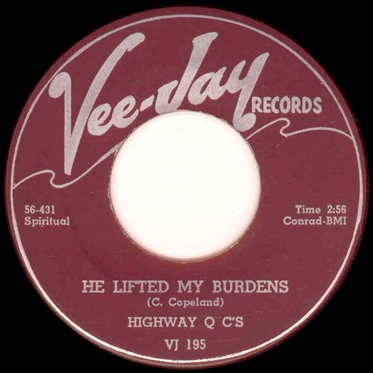
The QCs' first single hadn't gotten a whole lot of promotion, but by June 1956, when Vee-Jay 195 ("I Dreamed" b/w "He Lifted My Burdens") was released, the company was seeing more commercial prospects for gospel. "Abner says the religious music field is taking an upward turn" (Cash Box, June 16, 1956, p. 28). The record was included in the "Spiritually Tops" section of a big company ad (Cash Box, July 28, 1956, p. 79)
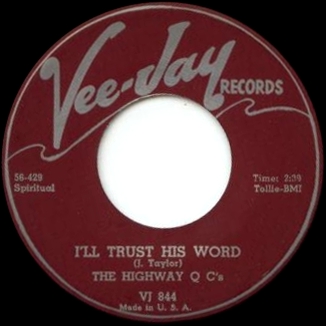
Marovich believes that the Highway QC’s never matched their 1955 and 1956 sessions—when Johnnie Taylor was the lead. Nonetheless the group became one of Vee-Jay’s most prolifically recorded acts, staying with the company until 1964, when the company was nearing its demise. In 1964 the QC’s moved to Peacock.
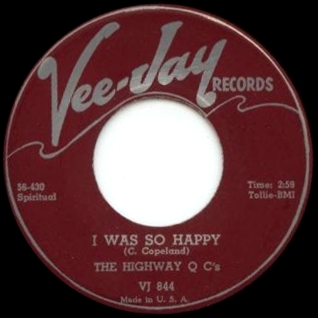
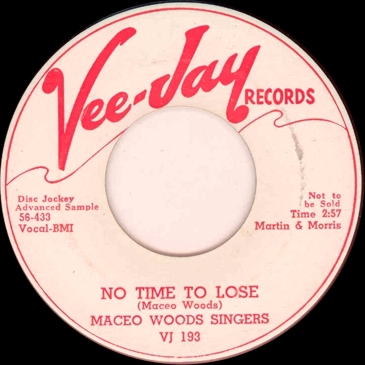
Following the Highway QC’s session, Vee-Jay continued in March to record a lot of gospel, taking the Maceo Woods Singers, Echoes of Eden, and Argo Singers into the studio. The Maceo Woods Singers produced two useable sides.
On September 11, in another marathon gospel session, Vee-Jay recorded Maceo Woods at his Hammond Organ for an instrumental session. He was accompanied by Ronald Hall on piano and Paul Gusman on drums. One side was released as a single, but two were held until they eventually appeared on a Maceo Woods LP, after Vee-Jay started an extensive line of albums in 1959.
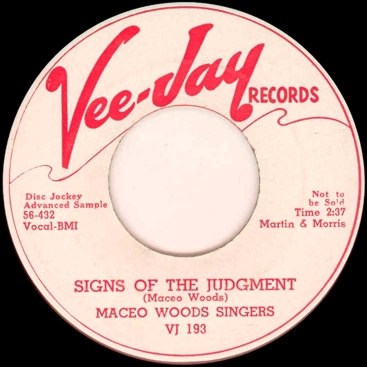
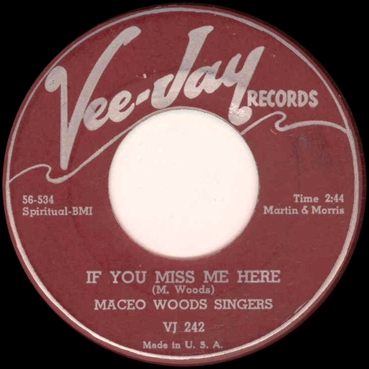
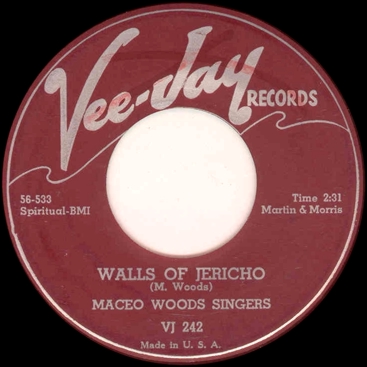
Woods recorded later sessions in 1957, 1959, and 1960 for the label. In 1960 he formed the Rev. Maceo Woods Christian Tabernacle Ensemble, and subsequently recorded three LPs with this group. According to Chicago Reader critic Lee Hildebrand, the Christian Tabernacle Concert Choir "rocks like a big band on up-tempo selections and harmonizes with such precision on slow numbers that it sounds more like a giant pipe organ than a roomful of voices." Their 1969 song "Hello Sunshine," recorded for Volt Records, was a cross-over r&b hit.
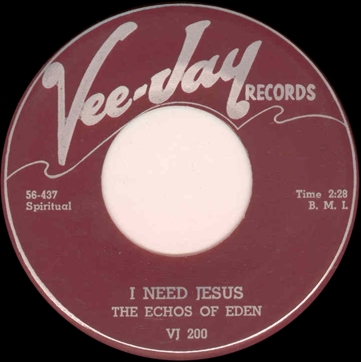
Two all-female gospel groups made their Vee-Jay debut in March 1956, the Echoes of Eden, and the Argo Singers.
The Echoes of Eden were a female group from the company's original home, Gary, Indiana. The members were lead singers Selma Kirkendall and Rose Dumas, and sisters Alice Polk, Sarah Polk, and Ruth Polk. Selma Kirkendall was born July 17, 1932 in Carruthersville, Missouri. Her family moved to Gary and she attended Roosevelt High School, graduating in 1950.
The Echoes were accompanied on their session by an organist (who could have been Maceo Woods, of course) and a pianist. Their only release, "He's My Everything" on Vee-Jay 200, came out in July 1956 (it was included in a big company ad for the NAMM convention, Cash Box, July 28, 1956, p. 79).
The Echoes did not record for Vee-Jay again, and the company made no use of their two unreleased sides. In October 1958 the Echoes recorded two sides in Gary, of which a test pressing survives. Around 1959, they released a single on the Harvest label.
After her stint with the Echoes of Eden, Selma Kirkendall worked with another gospel group, the Belton Kirk Singers. In the 1970s and 1980s, she managed and sang with the Sounds of Soul. She also had a radio show on WWCA, where she was known as "The Gospel Lady."
All of the members of the Echoes of Eden are now deceased. Selma Kirkendall died in the late 1980s or early 1990s.
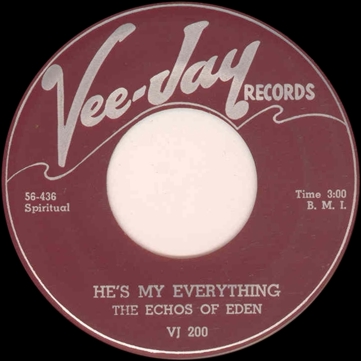
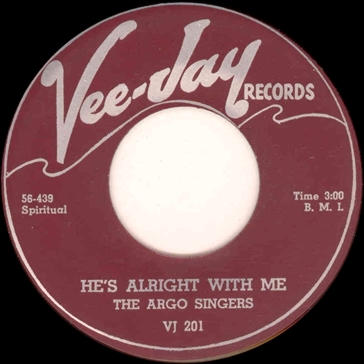
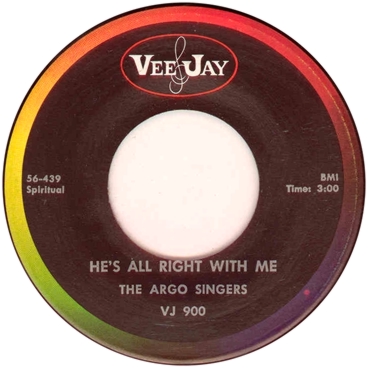
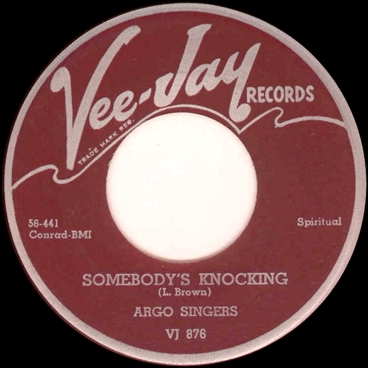
The Argo Singers came together in the late 1940s in the Chicago suburb of Argo. They first appeared on record for Trumpet Records in 1951, with a lineup consisting of the great lead singer Lorenza Brown, Minnie Colbert, Mildred Thomas, Willella Burrell, Tlithia Irons, and Louise Rhodes. Only three members were listed for the March session—Lorenza Brown, Minnie Colbert, and Claudia Jeter—but the group undoubtedly included at least two more. The Argo Singers were accompanied by an unknown male singer, William Lambert on piano, Maceo Woods on organ, and Al Duncan on drums.
Their number, "Near the Cross," was released in July on Vee-Jay 201 (see the company ad in Cash Box, July 28, 1956, p. 79), and proved to be a sizable gospel hit. The Argo Singers in 1958 would follow with a session on Specialty, but then returned to Vee-Jay, recording in 1961, 1963, and 1964, with Shirley Wahls as lead.
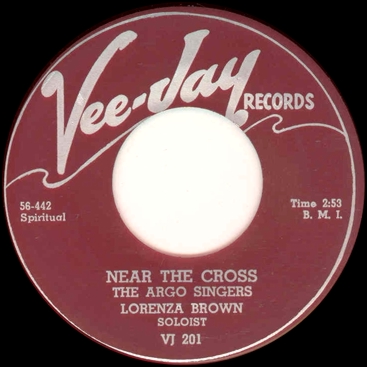
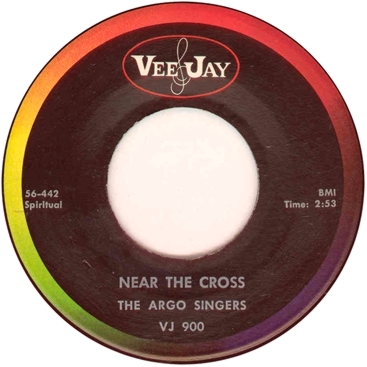
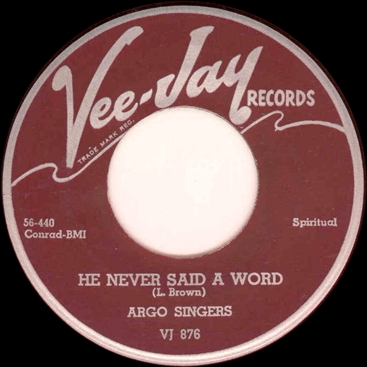
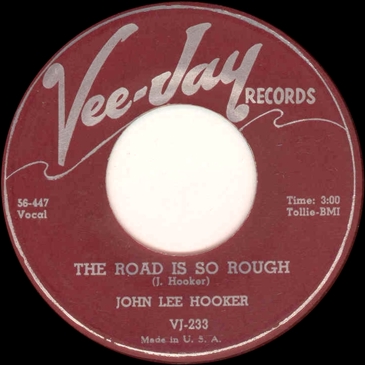
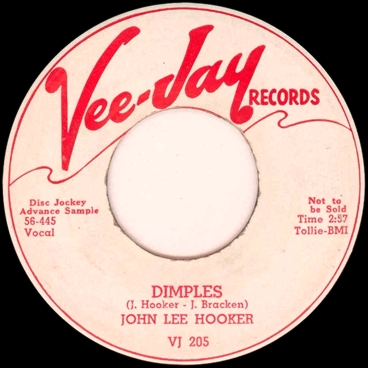
John Lee Hooker experienced his breakthrough session for Vee-Jay in March. There with guitarist Eddie Taylor, bassist George Washington, and drummer Tom Whitehead, he laid down one of the strongest sessions of his career. All six sides were released on singles.
Vee-Jay 188, "Every Night" b/w "Trouble Blues," was out in May (first advertised in Cash Box on May 26, 1956, p. 29). It was advertised again on June 9 (p. 33) and given a final push on July 28 (p. 79).
It was Vee-Jay 205, released in September, that drew more sales. Even though "Dimples" did not make the Billboard national R&B chart, it got played on radio stations across the country. Ewart Abner was pushing "Dimples" to Cash Box on September 8 (p. 28), it was advertised on September 15 (p. 29), and the trade magazine reviewed it on September 29, 1956 (p. 36).
In January 1957, two more sides ("I'm So Worried Baby" b/w "The Road Is So Rough") were released on Vee-Jay 233. Cash Box reviewed it on January 19 (p. 42). Vee-Jay ran an ad for 233 in the same issue (p. 40), and another on February 2, 1957 (p. 36). Cash Box (as happened on occasion) ran a second review on February 16 (p. 44)
Vee-Jay followed with a session in June—with the same cast plus tenor sax player Otis Finch—but the results were disappointing and the four sides have never been released. Since the March session generated a year's worth of releases, the company scarcely missed the June sides.
Hooker remained with Vee-Jay until 1964, recording a load of LPs, and producing a notable pop hit, "Boom Boom," in 1962. In later decades he became a blues icon, generating in 1989 a million-selling album, The Healer (which featured guest appearances by a bevy of rock stars). Hooker died June 21, 2001, in Los Altos, California.
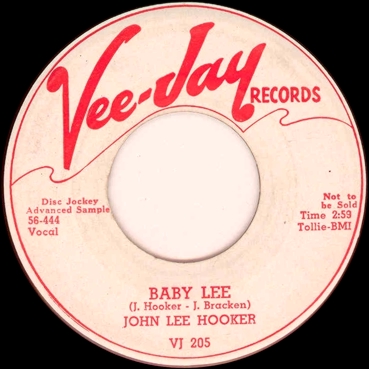
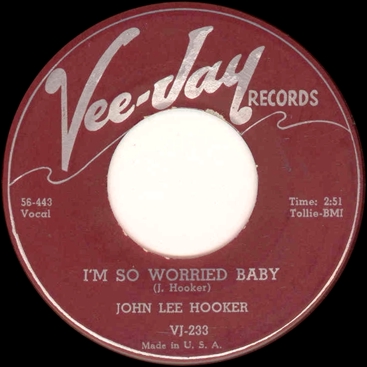
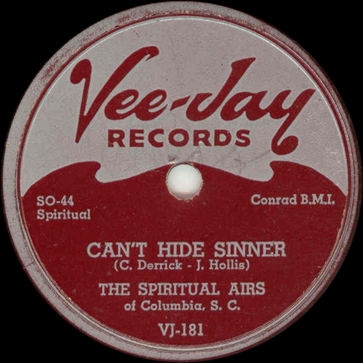
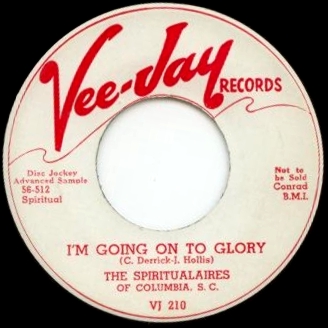
The Spiritualaires of Columbia, S. C.. used this long name so gospel followers would not confuse them with another Spiritualaires group, who recorded for United. Before coming to Vee-Jay, the Columbia Spiritualaires made just one session for the tiny Bowman label in 1955. The first session (mastered in April 1956) was probably recorded in Columbia, judging from the "foreign" matrix numbers that appear on Vee-Jay 181. The first single by the Spiritualaires was one of seven presented in a company ad on May 12, 1956 (Cash Box, p. 64). Vee-Jay 181 reappeared in the big company ad in Cash Box for July 28, 1956 (p. 79). The magazine never reviewed it.
The August 1956 follow-up also consisted of two songs, which were released on Vee-Jay 210, in October or November. The Spiritualaires as they appeared on Vee-Jay consisted of Louis Johnson (lead), A. J. Thompson (lead), Joseph Hollis (tenor), Bernard Codwell (baritone), Charles Gavish (bass), Norris Turner (utility), and Frank "Drink" Small (guitar).
Vee-Jay didn't bother with trade magazine advertising on the group's second single. Cash Box did carry a plug from Charles Derrick, a gospel deejay in Columbia, who put two sides by the Spiritualaires on his top 10 list, and made "I'm Out on Life's Ocean" Number 1 (December 1, 1956, p. 34). It's quite possible Cash Box didn't know that Charles Derrick and Charles Gavish were one and the same person.
The Spiritualaires would record just one more time, another two-number session for Vee-Jay in May 1957. The group went on to tour with the Swan Silvertones, and appeared at the Apollo in New York City in June 1957. Soon after that appearance, the Spiritualaires broke up. Louis Johnson joined the Swan Silvertones in 1959. Under his nom-de-deejay Charles Derrick, Gavish went on to produce several soul artists, most notably Kip Anderson for such labels as Checker, Excello, and Tomorrow. Drink Small pursued a new career as a blues singer, cutting a 45 for the Savoy subsidiary Sharp in 1958; taking advantage of renewed interest in his work, he recorded more blues in the 1990s.
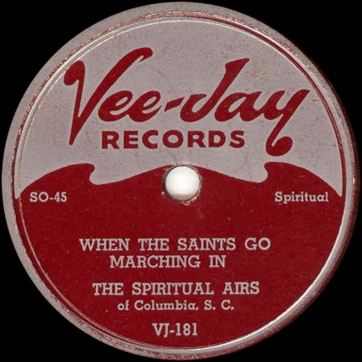
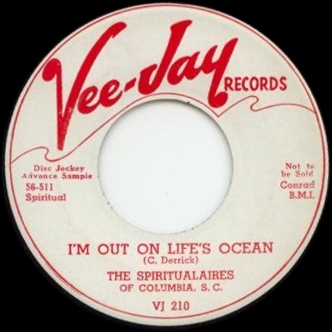
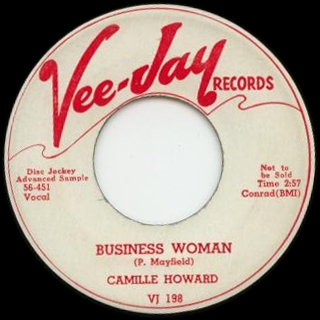
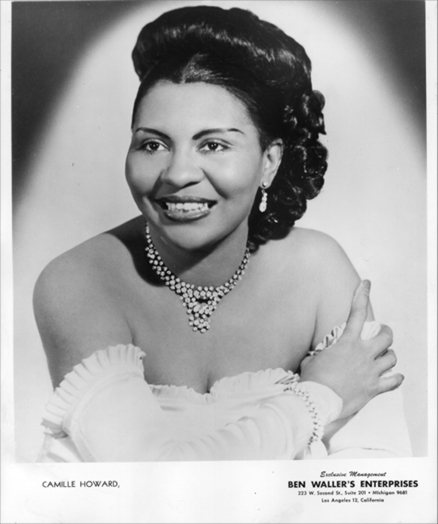
Boogie woogie pianist Camille Howard was born on March 29, 1914, in Galveston, Texas. She developed her piano skills in Los Angeles and in the early 1940s joined the Roy Milton Orchestra. She made many recordings with the Milton band, playing both piano and singing. In 1946 she made her recording debut with the Pan American label. In 1947 she joined Specialty, and got a major hit with "X-temporaneous Boogie" (1948). Howard recorded two West Coast sessions for Federal in 1953. In 1954 and 1955 she returned to touring with Roy Milton. In 1956 she was working as a solo artist on a package tour that included Roy Brown, Little Willie John, and Joe Tex. Her very last recording session was this one for Vee-Jay, in May 1956.

On her final session, Howard was accompanied by the Al Smith Band. "Business Woman" is a blues with an excellent tenor sax solo by Leon Washington; "Rock 'n Roll Mama" has another strong tenor solo and great brushwork by Al Duncan; "In the Bag Boogie" is an instrumental feature for her piano, backed by riffing tenor and baritone sax.
Cash Box's Chicago section ran a confused reference to "Camille Williams'" upcoming outing (April 28, 1956, p. 32). Vee-Jay 198 wasn't advertised or reviewed there, presumably because the company quickly lost interest in it.
As rock and roll cut into her opportunities, she left the scene and restricted her musical activities to church. Camille Howard died in Los Angeles, on March 10, 1993.
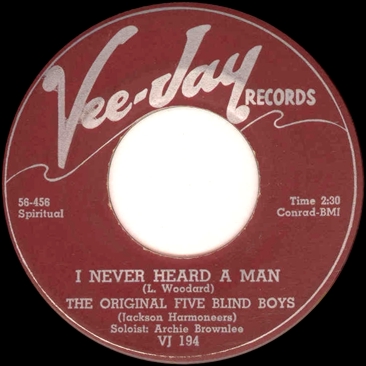
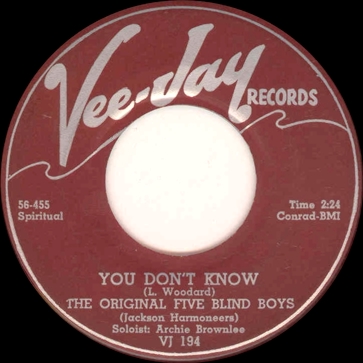
The Original Five Blind Boys were formed in 1947 in Mississippi. As the Jackson Harmoneers, the group first recorded for Excelsior, then in 1948, as the the Five Blind Boys of Mississippi, they recorded for New Jersey-based Coleman label. From 1950-56, the group recorded as the Original 5 Blind Boys for Peacock. The group first recorded for Vee-Jay in two sessions in May 1956. At this point, it consisted of the great hard-singing lead Archie Brownlee, supported by Lawrence Abrams (tenor), Lloyd Woodard (baritone), and Jay T. Clinkscales (bass). Musicians on the session were Wayne Bennett on guitar and Ronald Hall on piano.
The first Blind Boys session lead to the group's release on Vee-Jay 194, out in June 1956 just as the company was starting to promote its gospel records again (Cash Box, June 16, 1956, p. 28). Vee-Jay 194 was included in a big company ad for the anniversary edition of Cash Box (July 28, p. 79).
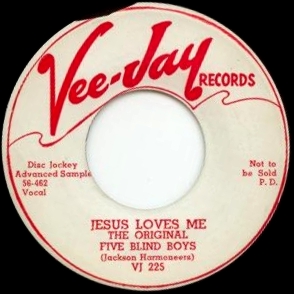
The Blind Boys were back in the studio two weeks later. The second single on the Blind Boys was part of a big gospel release package in the fall. Vee-Jay 225 was reviewed in Cash Box on November 17, 1956 (p. 39) and advertised in the same issue (same page).
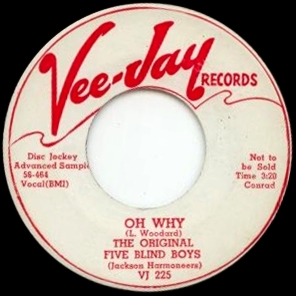
A third side was held for release on Vee-Jay 240 in 1957.
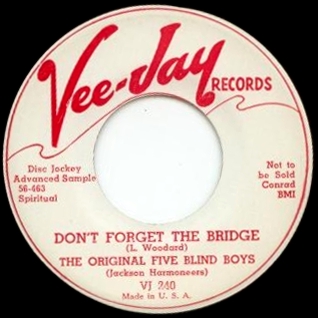
The Five Blind Boys recorded three more sessions for Vee-Jay during 1957 and 1958, then returned to Peacock in 1959.
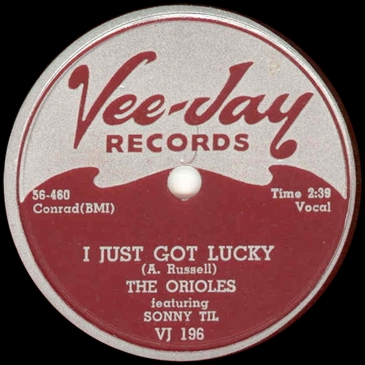

The only connection between the legendary Orioles, who helped launch the vocal group explosion in the late 1940s, and this Vee-Jay edition was their lead singer, Sonny Til. After a string of hits for Jubilee, the original Orioles broke up in 1954. Sonny Til recruited new singers from another group called the Regals. His new supporting cast consisted of Aaron Cornelius (tenor), Jerry Rodriguez (tenor/baritone), Albert Russell (baritone), and Billy Adams (baritone).
Vee-Jay obviously thought the Orioles still had a following, and promoted their releases accordingly. The company took the new Orioles into the studio twice during 1956, in May and October.
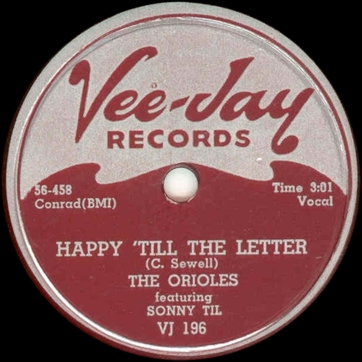

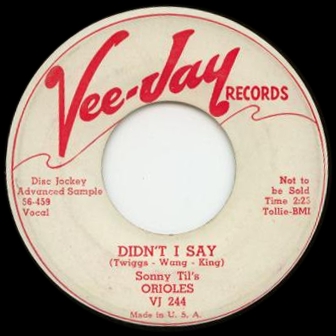
Along with the Orioles' regular pianist, Paul Griffin, Al Smith combos backed the group on their first Vee-Jay session in mid-May of 1956 at Boulevard Studio, and on their second session in October.
The first single from the May session, Vee-Jay 196, paired "I Just Got Lucky" and "Happy 'til the Letter." The record was being talked up on June 9 (Cash Box, p. 28). It was in the stores a month after the session, with the first ad running in Cash Box on June 16 (p. 31); label copy referred to the Orioles featuring Sonny Til. On June 23, Cash Box reviewed the record; on June 30 the company ran two ads for it (pp. 19, 27). Vee-Jay 196 also showed up in the giant NAMM ad for July 28 (p. 79).
The second single from the session, Vee-Jay 244, paired "Sugar Girl" and "Didn’t I Say," came along in April 1957 (it actually followed Vee-Jay 228, from the group's October 1956 session). 244 was in a batch of releases around April 1, 1957 (Cash Box, April 6, 1957, p. 35). On these records, the group was billed as Sonny Til’s Orioles.
A second attempt to move "Sugar Girl" began at some point in the second half of 1958, when it was rereleased on Abner 1016.
The October session led to Vee-Jay 228, first advertised in Cash Box on November 24, 1956 (p. 35) and readvertised on December 8, 1956 (p. 50). Vee-Jay was obviously expecting a lot out of the release. Cash Box reviewed it on December 22 (p. 38), and it got another push in a big company ad on December 29 (p. 41). Hope was still being held out on February 2, 1957 (Cash Box, p. 41) when the company advertised the single one more time. Another side from October was held for a Vee-Jay vocal group LP and the fourth has never seen release.
In the end, Vee-Jay just could not revive the Orioles name, and let the group's contract run out in 1957.
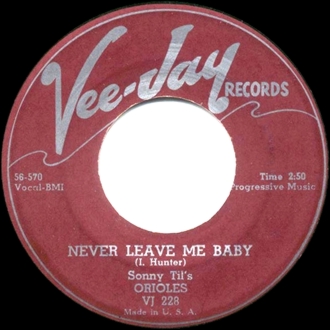
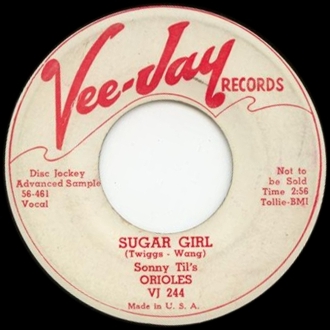
Vee-Jay’s faith in the Dells paid off handsomely with their May 21, 1956 session, which introduced the group's signature song, "Oh What a Nite," and established the group as a national act. "Oh What a Nite" became a hit in October, 1956, going to #4 position and lasting 11 weeks on Billboard's R&B chart. While it is remembered as a classic in the pop market as well, the record surprisingly never charted nationally.
The superb singing of the Dells is magnificently supported by the Al Smith band. "Oh What a Nite" also contains a classic tenor saxophone solo by Little Wash, who with this session became regular in the studio for Vee-Jay. There are breaks for Lefty Bates on "Now I Pray." "Jo-Jo" and "Baby Do" feature what are essentially duos between Little Wash and Mac Easton. Presumably the MFD files are right in pointing to Paul Gusman as the drummer. Pianist Turk Kincheloe, who had previously recorded for Vee-Jay as a leader and would soon be back, on a session with Duke Groner (see below), would work the Chicago clubs with the Dells in the early 1960s as Kirk Stuart.
Vee-Jay 204, "Oh What a Nite" b/w "Jo-Jo," was released in September. Initially, the company made "Jo-Jo" the plug side (it was listed first in the Cash Box ad on September 8, 1956, p. 30, again in the ad for September 15, p. 29). On September 22 (p. 28), Cash Box had sales on the record (identified as "Oh What a Nite") moving eastward. The first solo ad (Cash Box, September 29, p. 35) reversed the order and put "Oh What a Nite" in much larger print. Cash Box reviewed it on October 6 (p. 38), again making clear which side was hitting. More Cash Box ads ran on October 6 (p. 39), October 13 (p. 43), and October 27 (p. 33). Vee-Jay 204 was advertised in Billboard on September 29 (p. 67) and October 13 (p. 51).

A second session on the Dells in early September produced the terrific ballad, "I Wanna Go Home." The Dells again were accompanied by an Al Smith band, but there are no instrumental solos on the two sides that were released.

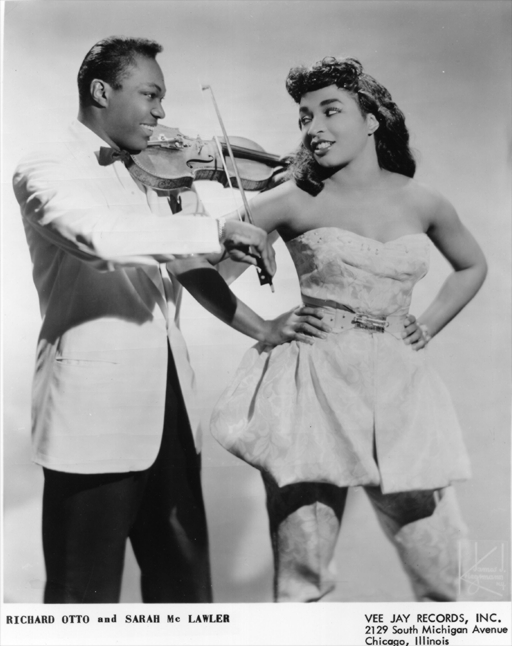
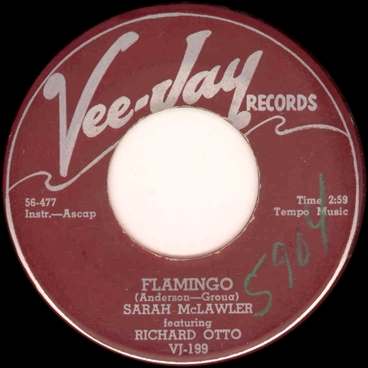
Sarah McLawler sang and originally played the piano. She was born August 6, 1926, in Louisville, Kentucky, and graduated from Crispus Attucks High in Chicago. She became interested in jazz at Fisk University in Nashville, where she studied organ and music theory. She first worked as a soloist in Chicago clubs, but around 1948 formed an all-female combo. Her band, as reported in April of 1949 in the Chicago Defender during their engagement at the Blue Heaven on 63rd Street, included McLawler on piano, Hetty Smith on drums, Vi Wilson on bass, and Lula Roberts on tenor sax. When one of the girls got married, McLawler disbanded her combo and went solo again. In 1950, she recorded for Premium, with what sounds to our ears like a Red Saunders unit.
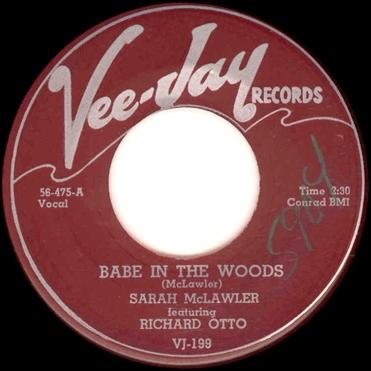
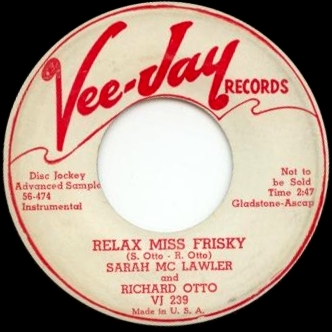
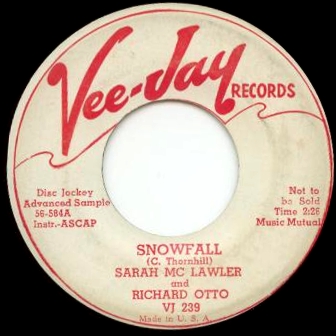
McLawler moved to New York in 1951, switching to organ soon afterward; from 1953 to 1965, she maintained a trio with the unusual instrumentation of organ, violin, and drums. Her husband Richard Otto was the violinist, while at different times Robert Brooks and Tommy "Bugs" Hunter (1927-1999) occupied the drum chair. McLawler and Otto first recorded together for Brunswick, in 1953. Their signing to Vee-Jay was announced in Cash Box on June 2, 1956 (p. 26). On their first session, in May 1956, they didn't bring their working band; they were accompanied by Lefty Bates on guitar, Quinn Wilson on bass, and John Cooper on drums.
The plan was to make an LP. On June 9, 1956, Cash Box blared, "Vee-Jay ready to enter the package trade with some of the pleasantest jazz we've heard in a long time" (p. 28). Supposedly the plan was to cut 12 sides in two weeks. In fact, 6 were cut in one session, and the next 6 had to wait a while. "Relax Miss Frisky," initially projected for the group's first single, was replaced with "Flamingo." Vee-Jay 199, "Flamingo" b/w "Babe in the Woods" was out in time for the NAMM convention in New York City and the 14th anniversary issue of Cash Box (July 28, 1956, p. 79). The record was advertised again in Cash Box on August 4, 1956, along with Vee-Jay 202 by The Spaniels and 203 by Jimmy Reed (p. 31). A solo ad followed on August 25 (p. 33) and Cash Box finally reviewed Vee-Jay 199 on September 8 (p. 33), with an ad running in the same issued (p. 30). The company was still mentioning the record in its final Cash Box ad for the year (December 29, p. 41).
The second session, with the same instrumental lineup, didn't come around until November. With six more sides cut on the second outing, the sessions did yield enough tracks for an LP. Sure enough, on December 15, Cash Box (p. 36) had Abner announcing that the group "had completed all twelve sides for their pending LP to be released shortly after the new year." The LP project was still being mooted in Cash Box for January 5, 1957 (p 22); on January 26, the trade paper even had Abner talking about how great the cover was going to be (p. 34). In the end, Vee-Jay, which would get heavily into LPs in due time, and into jazz LPs in particular, wasn't quite ready. By March, Ewart Abner was instead getting ready to release LPs on the The Spaniels and the El Dorados (Cash Box, March 30, 1957, p. 42). Consequently, "Relax Miss Frisky," with a coupling from the November session, made a delayed appearance on Vee-Jay 239. On April 6, 1957 (p. 36), Cash Box let everyone know how McLawler and Otto "kicked off their new single" at a club in Paterson, New Jersey.
The company obviously saw further potential, as the pair would return to Chicago for two-day, album-length sessions in 1957, 1958, and 1960. These did lead to LPs. The first Vee-Jay LP, and the first McLawler-Otto LP, was on sale in January 1958 (Cash Box, January 18, 1958, p. 48). But the remaining sides from 1956 were left in the can.
Besides the Cliff Butler mixup from earlier in the year, there was another involving a singer and pianist named Joe Jones (not to be confused with two jazz drummers, or with a host of other musicians). On June 2, 1956, Cash Box announced (p. 26) that "Joe Jones, young New Orleans bandleader-singer, dropped into the office to tell us he has signed with Vee-Jay and will record in a couple of weeks." Cash Box ran his photo along with the item, but something didn't work out. We have found no evidence that there ever was a Joe Jones session for Vee-Jay.
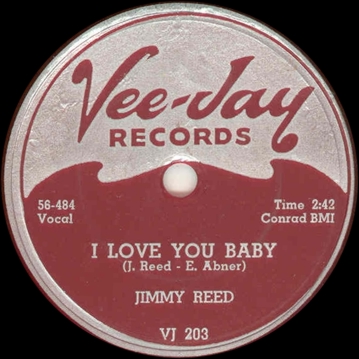
Vee Jay recorded two sessions on Jimmy Reed in 1956, one in June and one in October. The June session—held in conjunction with a four-track for his sideman Eddie Taylor—produced a small R&B hit, "I Love You Baby" (Vee-Jay 203) later in the summer. The accompaniment was by Eddie Taylor on guitar and Earl Phillips on drums.
Vee-Jay 203 ("I Love You Baby" b/w "My First Plea") was first advertised in Cash Box on July 28, 1956 (p. 79) during the runup to the annual NAMM Convention. It got a positive review in the same issue (p. 82). It was advertised on August 4 (p. 31) and August 11 (p. 29), given a solo ad on September 1 (p. 35), and advertised for the last time in Cash Box on September 8 (p. 30). Once Vee-Jay 205 by John Lee Hooker was out, the company stopped plugging 203 by Jimmy Reed.
Reed's October session, with the same accompaniment, produced three usable tracks. One was an untitled instrumental; the other two, "Honey, Don't Let Me Go" and "You've Got Me Dizzy," were promptly released on Vee-Jay 226 in November. By November 17, Cash Box, p. 34, was intimating how Abner "claims biscuit is breaking wide open in several sections of the country." Cash Box reviewed it on November 24 (p. 37). Sales were being talked up again on December 8 (p. 44) and the single rated a solo advertisement in Cash Box on December 15 (p. 37). On December 29, a company ad in Cash Box (p. 41) listed it among Vee-Jay's hits, OK sellers, and some items it was still trying to push a little harder in the final quarter of the year. Vee-Jay 226 showed up in still another company ad on January 19, 1957 (Cash Box, p. 40). A Jimmy Reed classic, "You've Got Me Dizzy" became one of his biggest hits.
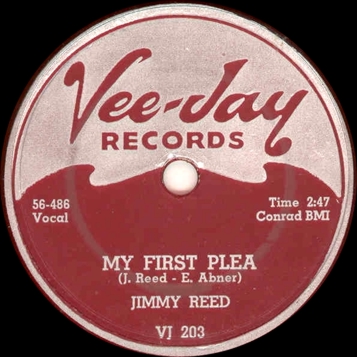
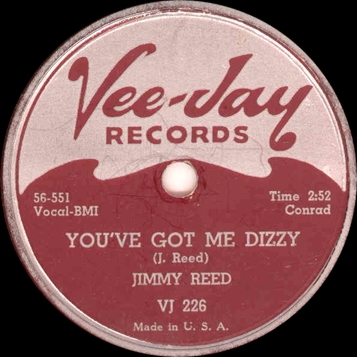
Reed became the biggest crossover blues act of the 1950s, making him a bona fide rock ‘n’ roll hit maker. With the rock ‘n’ roll fan base, Reed was bigger than such titans as B. B. King, Muddy Waters, and Joe Turner. Among his great hits were "Honest I Do" (1957), "The Sun Is Shining" (1957), "Baby What You Want Me to Do" (1960), "Big Boss Man" (1961), and "Bright Lights, Big City" (1961). His last chart record was "Knockin’ at the Door" on the ersatz Vee-Jay label, Exodus, in 1966. Reed died on August 29, 1976.
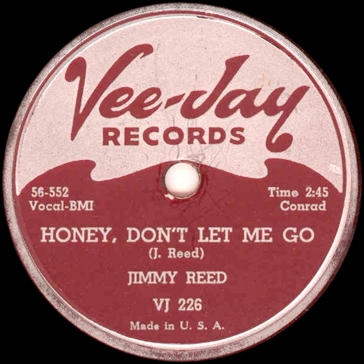
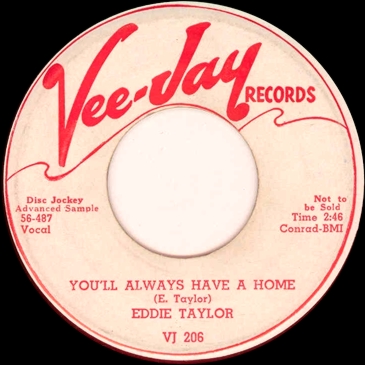
Vee-Jay gave Eddie Taylor one session a year, and in July he was in the Universal Studio again, accompanied by "Earring" George Maywether (harmonica), Jimmy Lee Robinson (bass), and Earl Phillips (drums). Two of the four sides were released on Vee-Jay 206, to utter disinterest from the record buying public. Vee-Jay 206 ("You'll Always Have a Home" b/w "Don't Knock at My Door") was advertised on September 15, 1956 (Cash Box, p. 29), given a tepid review (Cash Box, September 22, p. 32), and that was it.
Vee-Jay ended Taylor’s annual studio dates after an outing in November 1957. The company would only bring him into the studio one other time, in 1964. The guitarist recorded a session for Jump Jackson’s LaSalle label in 1966, but it went unreleased. The same year, Eddie Taylor made his first LP on Testament for the burgeoning white blues market. Other LPs followed in both the United States and Europe during the 1970s and 1980s. Eddie Taylor died in Chicago on December 25, 1985.
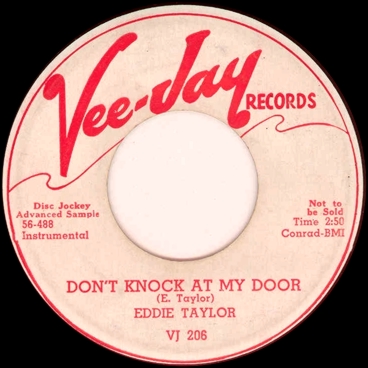
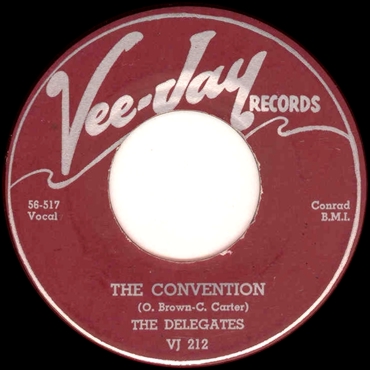
The Kool Gents—John McCall, Doug Brown, Delecta "Dee" Clark, Teddy Long, and Johnny Carter—were taken into the studio in July. By this time, Dee Clark was singing most of the leads, notably on "I Can’t Help Myself" (Vee-Jay 207). It is an outstanding ballad, but it did not catch on in the market at the time.
On August 21, the Kool Gents recorded as The Delegates on a comic novelty called "The Convention," to exploit interest in the Republican and Democratic conventions being held in that presidential election year. Oscar Brown Jr. wrote the number, and he and Calvin Carter joined in on the singing. This was a perishable item, so the company rushed it out at the beginning of September on Vee-Jay 212. For a flip, the company used "Jay's Rock," a spare side from Big Jay McNeely's one session during the previous year. Big sales were being alluded to in Cash Box on September 8, 1956 (p. 28) and 212 drew a favorable review on September 15 (p. 33). The company reproduced the review in a Cash Box ad on September 22 (p. 30). The company saw fit to mention it again in its end-of-year ad in Cash Box (December 29, 1956, p. 41).
On March 2, 1957, Ewart Abner, still not publicly revealing that the Delegates were the Kool Gents, told Cash Box that the group had been "in retirement since their exciting, but non-selling recording of 'The Convention'" (p. 38). Abner was willing to admit past non-selling because he was so confident in future selling: the Kool Gents had just recorded, on February 19 with an Al Smith group. Sure enough, the Kool Gents' cover of "Mother’s Son" (which Ping Records had released on the De'bonairs in November 1956) showed up on Vee-Jay 242 credited to the Delegates. The flip for the second Delegates release (Vee-Jay 243) was "I’m Gonna Be Glad" from the July 1956 session.
The Kool Gents/Delegates fell apart in May 1957, when Vee-Jay pulled Dee Clark from the group to perform as a solo artist for its new Falcon/Abner subsidiary. In fact, two further sides from the session of February 19, 1957 were released on Falcon 1002 under Clark's name. The other members of the group became Pirkle Lee Moses' new backup in a new version of the El Dorados.
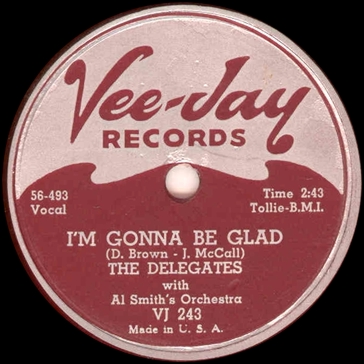
James Edward "Snooky" Pryor was born on September 15, 1921, in Lambert, Mississippi. His style on the harmonica was derived in roughly equal parts from John Lee "Sonny Boy" Williamson and Aleck Miller (aka Sonny Boy Williamson #2). He got the idea of amplifying his harmonica while serving in the military during World War II, and in 1945 began performing at the Maxwell Street market with portable PA system he'd purchased at a store at 504 South State. As the first to amplify a harmonica, Pryor should rightly be recognized as a blues pioneer. Pryor first recorded for Planet and Marvel (1948), and then subsequently recorded for JOB (1950, 1952-54) and Parrot (1954), before joining Vee-Jay on this session from July 17, 1956.
Cash Box mentioned on July 21, 1956 (p. 24) that Vee-Jay was keeping Universal Recording busy; two of the artists mentioned were Pryor and Big Joe Williams. Pryor was accompanied by the guitars of two long-time associates, Floyd Jones and Johnny "Man" Young, as well as the drums of Earl Phillips. Uncharacteristically, the group was aiming for the Jimmy Reed/Eddie Taylor sound that was selling big for Vee-Jay by this time. The Jimmy Reed lope is in evidence, and Snooky's harmonica is only modestly amplified.
The experiment was not a commercial success. Vee-Jay 215 was released from the session in October: the company advertised it in Cash Box, along with 211 by the El Dorados and 214 by Pee Wee Crayton, on October 20 (p. 26). It was reviewed on November 3 (p. 38) and an ad for the Crayton and Pryor singles ran in the same issue (p. 34). Although it gave the single one more push in an end-of-year ad (Cash Box, December 29, 1956, p. 41), the company did not feel compelled to release anything else or to record Pryor again. A third track from this session was issued for the first time, along with two alternate takes, on LP by Charly in 1983 (Charly CRB 1042, Combination Blues: Chicago Blues Masters, Vol. 1. (Our thanks to Dirk Serneels for information about the Charly release.)
Pryor retired from music in 1962 after one last session for JOB. In 1971 Living Blues magazine lured him out of retirement, and conducted the first published interview with him. He recorded an LP for Bluesway in 1973 but did not become a hit on the blues revival circuit until a Blind Pig release in 1987. He continued to record into the 1990s for such labels as Antone’s and Discovery.
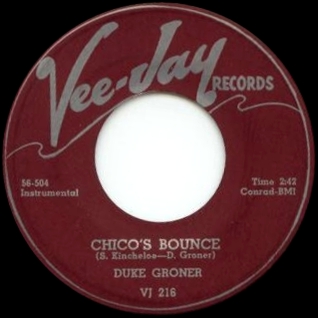
Edward "Duke" Groner was born in Ardmore, Oklahoma on March 24, 1908. He studied at Wiley College in Marshall, Texas. In the earlier part of his career he sang ballads in a high tenor voice and played a little piano. When he got married and settled in Chicago (probably in early 1943) he was a veteran of the Nat Towles, Horace Henderson, and Jimmie Lunceford bands. Groner started playing the bass so he would have another way to get work. He must have been ready to go public with the instrument at the beginning of 1944. He joined Local 208 on January 7, 1944; as a singer, he hadn't been required to join. Groner led his first piano trio in December 1945. He working full-time with it by 1946, and would spend a sizable fraction of his professional career with trios.
In 1954-1955, Groner expanded his group to a quintet with Wallace Burton (tenor sax); Turk Kincheloe aka Kirk Stuart (piano and organ); Hurley Ramey (electric guitar); and Charles Walton (drums). Later Porter Kilbert (alto and tenor) replaced Burton. Groner recorded one (very scarce) single for Vee-Jay. One of the composer credits for Vee-Jay 216 goes to R. Wilson, who could be tenor saxophonist Ronald Wilson; co-composer credit on the other side goes to Stuart Kincheloe (aka Turk Kincheloe aka Kirk Stuart…). Tom Lord does not mention this session, or any other under Groner's name.
Duke Groner was still leading a quintet through the end of 1960. In the runup to New Year's, the Duke Groner Combo accompanied the shows on the third floor of La Rue's Supper Club in Indianapolis (Indianapolis News, December 30, 1960, p. 7). The last reference we have found to the Duke Groner Trio is from an engagement in Lincoln, Nebraska in 1973. By that time Groner was often taking other gigs. He played in Bill Reinhardt's last Dixieland band, staying when Jim Beebe took over the gig (Larry Kart, "Sally's Keeps Gleaming with Beebe's High Musical Polish," Chicago Tribune, August 28, 1977, section 6 p. 17). When Larry Kart wrote up Beebe's band, saxophonist and clarinetist Eric Schneider was 24 years old, and Duke Groner (now usually known as "Daddy") was 69. Subsequently he worked most often with more traditionally oriented jazz musicians, often including Barrett Deems. Duke Groner died in Chicago on November 7, 1992 (Kenan Heise, "Chicago Jazzman Duke Groner, 84," Chicago Tribune, November 10, 1992, section 2 p. 8).
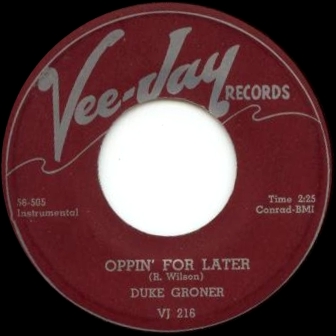
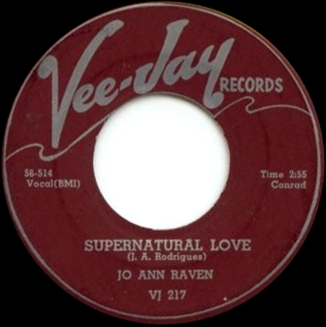
Jo Ann Raven was a jazz vocalist. Judging from the composer credits on both sides of Vee-Jay 217, her real name was Jo Ann Rodrigues. According to an item in Cash Box, she was from Chicago. On her session she was accompanied by a vocal group singing in a modern harmony style. Dr. Robert Stallworth has suggested that the Orioles were responsible, but according to Marv Goldberg (email communication, December 30, 2009), the Orioles' contract with Vee-Jay exempted them from backing other singers. The accompaniment would be by the El Dorados (if her numbers were done on August 8) or by the Kool Gents aka Delegates (if instead she recorded on August 21). In either case, an Al Smith band would also be implicated. Since Calvin Carter was mentioning one of her titles to Cash Box on August 25, 1956 (p. 28), in the same issue as a notice about the Bud Billiken picnic (which took place on August 11), and a week after Ewart Abner was talking about the August 8 session, we'll go with August 8 and with the El Dorados.
The company was in a bigger hurry with the Delegates and the El Dorados, holding Raven's single till the end of October ("Vee-Jay Swings Distaff," Cash Box, November 3, 1956, p. 34; Raven was described as though she had just recorded; the other female singer mentioned in the item, one Kitty La Nier, apparently never entered a studio and has disappeared without a trace).
Jo Ann Raven appeared once more on record for Vee-Jay, in late 1958 or early 1959 on the company’s Abner subsidiary. Her release on Abner 1022 appears to be a greater rarity than Vee-Jay 217. (Tom Lord lists her second session, but not this 1956 session.) Someone at Vee-Jay had a bug about Ms. Raven; to our knowledge she never recorded for another company.
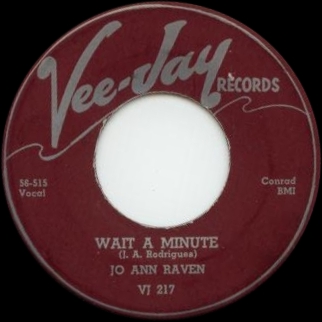
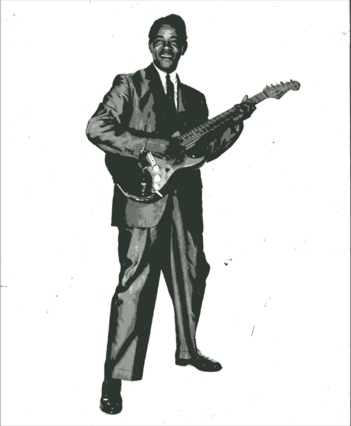
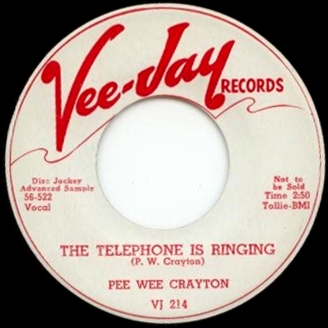
Blues artist Pee Wee Crayton was born Connie Curtis Crayton, on December 18, 1914, in Rockdale, Texas. He moved to Los Angles in 1935. His guitar playing and singing situate him as a disciple of T-Bone Walker. By the mid-1940s, Crayton was living in the Bay Area. In 1947, he first recorded for Four Star in Los Angeles. The following year, Crayton signed with Los Angeles-based Modern Records, where he achieved the bulk of his success. "Blues after Hours" (1948) was a number one R&B hit. He joined Aladdin in 1951, followed by stays at Recorded in Hollywood (1954), Imperial (1954-55), and Fox (1956).
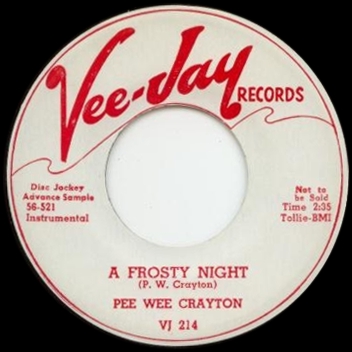
Crayton’s first Vee-Jay session took place in September 1956. He was supported by the usual suspects: Red Holloway on tenor sax, Mac Easton on baritone sax, Horace Palm at the piano, Quinn Wilson on string bass, and and Paul Gusman on drums. Vee-Jay 214 was released toward the end of October, drawing an ad (with Vee-Jay 211 and 215) in Cash Box for October 20, 1956), and another ad (with 215) on November 3 (p. 28). Cash Box didn't review it till December 1 (p. 38). A final push came at year's end, in the company's Cash Box ad for December 29 (p. 41).
Another track from Crayton's September 1956 session was used on his Vee-Jay 266, released in 1957. Two followup sessions were made, with the exact same lineup, in February and August 1957, but Vee-Jay never was able to extract a hit from any of them, and 6 of the 12 sides that Crayton recorded were left in the vault. Crayton recorded on a variety of labels during the 1960s, before entering the white-oriented LP market in 1970 when he joined Vanguard. Pee Wee Crayton died on June 25, 1985, in Los Angeles.
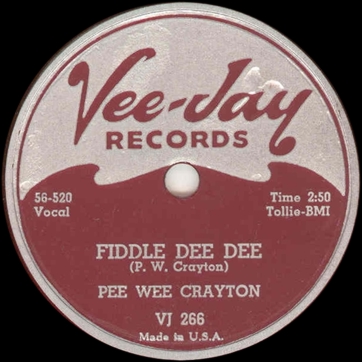
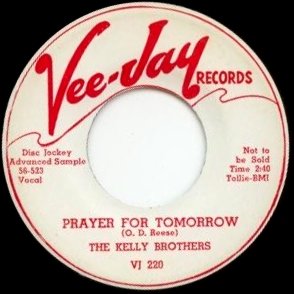
The Kelly Brothers were formed in 1948. The group was made up of three brothers—Andrew (baritone), Robert (tenor), and Curtis Kelly (high tenor)—plus tenor Offe Reese. The group recorded a session for Chance in 1954 that went unreleased. When the Kelly Brothers recorded their next session, for C. H. Brewer, in May 1956 according to the U3000 series matrix numbers, they added another member, T. C. "Charles" Lee. The record was released locally in Chicago. In September of the same year, this group recorded one session for Vee-Jay, producing one single. Offe Reese is listed in the discography as lead on "Prayer for Tomorrow," but on the other side, "God Said He Was Coming Back," no lead is listed. Interestingly, the group did the same songs for C. H. Brewer (although on C. H. Brewer it's "God Said He Is Coming Back Again") and for Vee-Jay.
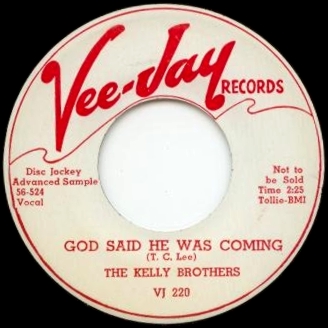
The Kelly Brothers subsequently recorded for Nashboro, Federal (where they recorded secular music under the name King Pins), and the Nashville-based Sims and Excello labels (where they recorded Southern soul hits, again as the Kelly Brothers).
On September 11 and 12, Vee-Jay ran a gospel marathon at Universal Recording. "Abner announced the diskery will cut sides with The Swan Silvertones, The Blind Boys, The Staple Singers, Macio [sic] Woods Singers, all in one week in order to meets demand of huge spiritual market" (Cash Box, September 22, 1956, p. 28). The list wasn't quite complete.
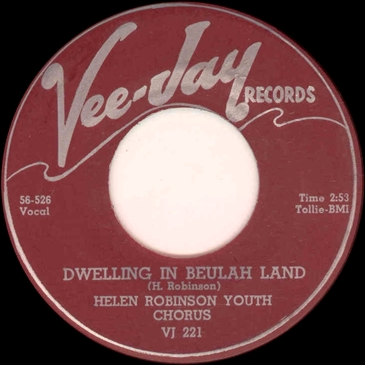
The Helen Robinson Youth Chorus was founded in Chicago in 1951 by New Orleans native Helen Robinson (who was born on January 31, 1915). Widowed in 1946 with seven children to care for, Robinson sought to create a positive outlet for her children and the boys and girls of their South Side neighborhood. She formed the Junior Robinson Singers, later renamed the Helen Robinson Youth Chorus. Initially, Robinson rehearsed the youth chorus on the first floor of her two-story home at 32nd Street and Wentworth Avenue. As the choir grew, however, rehearsals were moved to local churches.
Robinson developed a friendship with Lorenza Brown Porter, a member of the Argo Singers, a popular Vee-Jay gospel act, and Porter helped Robinson get her chorus on radio and also provided the introduction to Calvin Carter, who signed Robinson and her group. On September 11, 1956, Carter took the group to Universal Studios to make its debut record, "Time Is Winding Up"/"Dwelling in Beulah Land" (Vee Jay 221).
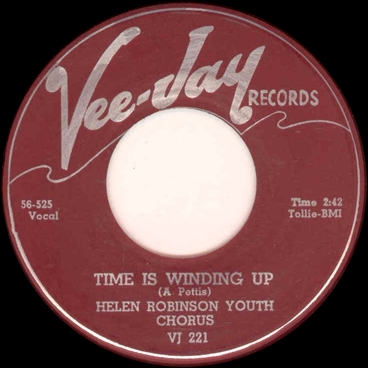
Bob Marovich raved about the group: "Far from being a novelty act in a day when touring and recording choirs were predominantly made up of adults, the Helen Robinson Youth Chorus could ‘hold their own against anybody,’ says the group's lead soloist, Jeanette Robinson Jones. And they did, time and again. The choir's most powerful asset was Jeanette Robinson herself. In my opinion, Jeanette was among the finest gospel singers of the early 1960s."
The Helen Robinson Youth Chorus later recorded for Specialty (1959), Mag-Oll (1962), Vee-Jay again (1964), and Atlantic (1967). The Atlantic LP was re-released on Cotillion in 1972, the last time the group would appear on vinyl. Although Helen Robinson died in 1993, the Helen Robinson Youth Chorus continued on, celebrating its 50th anniversary in 2000.
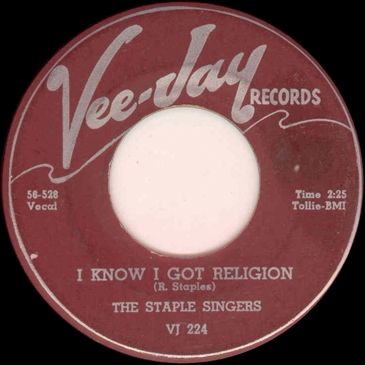
The Staple Singers shared Universal Studio on September 11 with three other gospel acts, but they were the ones who came up with the most transforming music. It was the session that produced "Uncloudy Day." Bob Marovich opined, "This recording, made during the Staple Family's fifth trip into a recording studio and second session for Vee Jay, defined their sound. With just one introductory strum of his twangy reverb guitar, Roebuck ‘Pops’ Staples immediately transported the listener far from the congestion of the cities where rural Blacks had migrated and back into the gentle breezes of the byways of rural America. The intense yet relaxed harmonies of Cleotha, Mavis and Pervis coupled with Mavis' haunting alto gave listeners a pleasant escape from the pulse-racing entertainment of the gospel quartets then touring the country." He goes on to say, that "the Staples’ trademark mixture of the blues, folk and gospel would flow through the remainder of their gospel as well as secular material but nowhere was it more evocative of their Southern roots than on ‘Uncloudy Day.’"
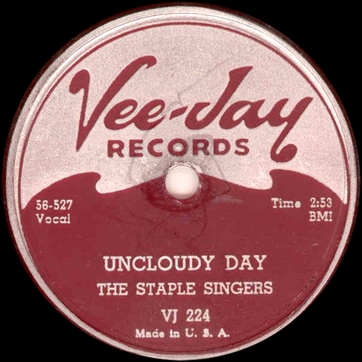
Other numbers on the session included "I Know I Got Religion," led by Roebuck, "Come on up in Glory," led by Roebuck and Mavis, and "Let Me Ride," led by Mavis (this last was eventually retitled "Swing Down Chariot").
Vee-Jay 224, "Uncloudy Day" b/w "I Know I Got Religion," was part of a package of gospel releases in the fall. It was advertised in Cash Box on November 17, 1956 (p. 39) and reviewed in the same issue (same page). Another ad ran on December 22 (p. 33); the single was also mentioned in the year-end ad of December 29, 1956 (p. 41).
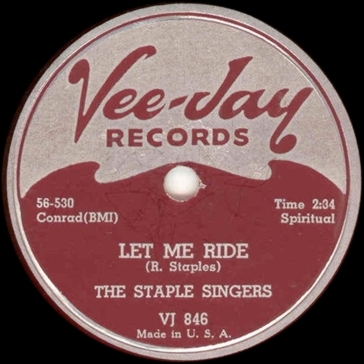
When Vee-Jay launched its gospel LP line in 1959, the first LP was by the Staple Singers, and it was called Uncloudy Day.
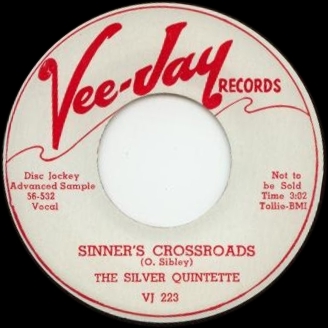
Members of the Silver Quintette were David Aron, Huey Brown, Roscoe Robinson, Joe Henderson and Willis Williams. Robinson was the famous member of the group, having performed with hard gospel group the Southern Sons (who recorded for Trumpet) in 1950. "Sinner’s Crossroads" brought the group notice, but according to Bob Marovich, "By September 11, 1956, when the Silver Quintette recorded ‘Father Don't Leave’ for Vee-Jay Records, hard gospel singing and rhythmic instrumentation were a matter of course. This track, the flip of the group's better known ‘Sinner's Crossroads,’ is gospel rock and roll. The drummer thumps hard on the second and fourth beats while the electric guitarist plays as if he were backing a rhythm and blues group. ‘Father Don't Leave,’ the better of the Quintette's two released cuts, is a long-forgotten gem and, like so many early Vee-Jay gospel recordings, deserves proper reissue."
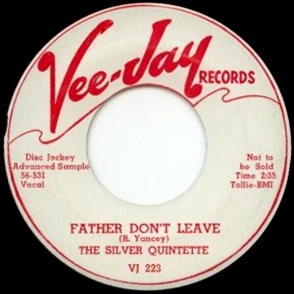
As the Silvertones, the group did one more session for Vee-Jay, in 1957, and then was never heard again on record. Roscoe Robinson joined the Original Five Blind Boys after the untimely death of Archie Brownlee and performed with the renowned quartet during the early 1960s. In 1960, Aron, Brown, Henderson and Williams joined Sam McCrary and the Fairfield Four and made an LP for the Old Town label. Joe Henderson also did a little pop recording, scoring a minor hit with "Snap Your Fingers" on the Todd label, in 1962.
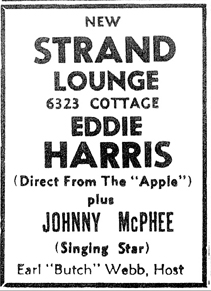
Johnny McPhee was a singer on the local scene. His manager was a South Side dentist, who was able to land him some gigs; for instance in February 1956 the New Strand Lounge advertised McPhee as a "singing star" appearing with Eddie Harris's jazz group. He made one session for Vee-Jay, in September, but none of the 4 titles have ever seen release. The titles indicate a definite jazz orientation on his part. Apparently the qualities that made McPhee somewhat interesting to South Side clubgoers weren't easily captured on vinyl.
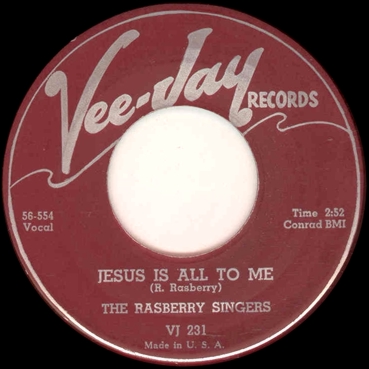
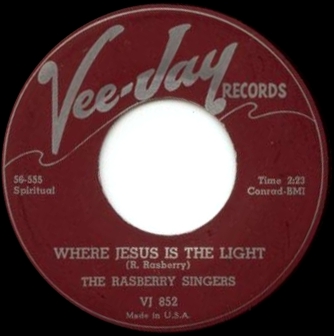
The Rasberry Singers’ October 1956 session for Vee-Jay was to be their last for the label. According to Horace Clarence Boyer, "No Tears in Heaven" proved to be a gospel hit.
The group would record extensively afterwards: sessions for Savoy in 1958, 1959, 1960, and 1966; for Choice in 1961, and for Halo in 1967-68. Raymond Rasberry died in Los Angeles, on October 20, 1995.
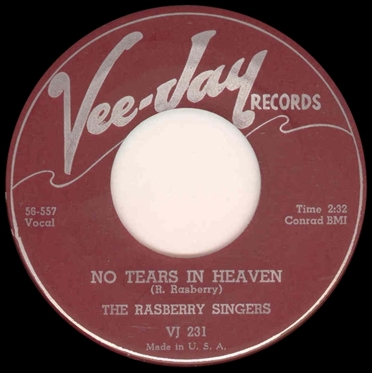
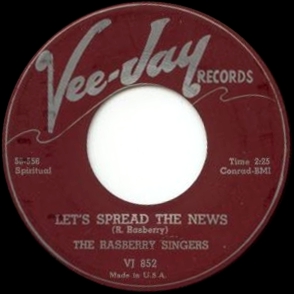
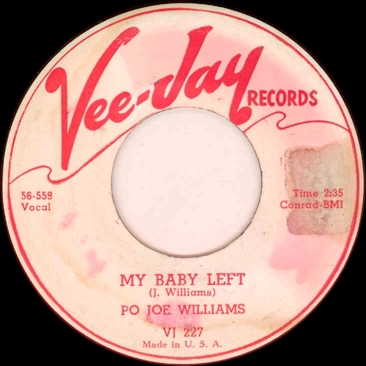
Po Joe Williams was in fact the famed country blues singer and nine-string guitarist Big Joe Williams. He was born October 16, 1903 in Crawford, Mississippi. By his late teens, Williams had become an itinerant musician, which he would be for the rest of his life. From 1935 to 1945, he recorded for RCA Victor’s Bluebird imprint. After World War II, Williams recorded for Columbia (1947), Bullet (1949), Trumpet (1951), and Specialty (1952), before he made this one session for Vee-Jay in 1956. His best known tune was "(Baby) Please Don’t Go." He re-recorded it several times, but did not include it on his Vee-Jay session.
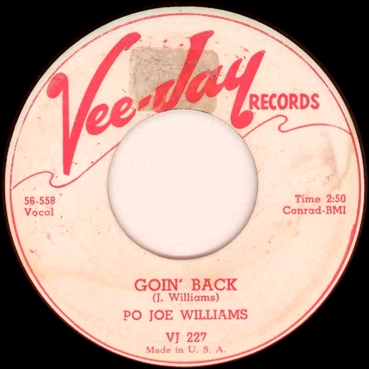
By the time of the Vee-Jay session, Williams was amplifying his nine-string instrument. Accompaniment was provided by Sam Fowler on harmonica and Alrook "Al" Duncan at the drums. The session produced the last recordings Williams made for essentially the African-American market. Vee-Jay 227 was released in December. The first ad (Cash Box, December 1, p. 35) spelled his name "Pojo." Sales must have been short of the company's targets, because Big Joe wasn't mentioned in the company's year-end Cash Box ad of December 29.
From 1957 to 1961, Williams extensively recorded LPs for Robert Koester’s Delmark label. Among the numerous other labels Big Joe Williams recorded for were Arhoolie (1960 and 1969), Folkways (1961), Bluesville (1961-62), Spivey (1962-64), Testament (1964), and Milestone (1964). Williams died on December 17, 1982, in Macon, Mississippi, while still an active musician.
Vee-Jay took Tommy Dean into the recording studio once in 1956, in October. He played organ, and was accompanied by Fred Lee (tenor sax), Grant Green (electric guitar), Hattuch Alexander (bass), Milton Wilson (bongos and drums), and Joe Buckner (vocals). Vee-Jay did not find anything in the session that sounded like a hit, and the entire session went unreleased. Grant Green, we might note, is said in other sources to have made his recording debut in 1959! If only because Green went on to greater fame, it is surprising that no attempt has ever been made to issue this material. Dean made one last session with Vee-Jay, in 1958, which also went unreleased. Dean continued to lead a combo in and around St. Louis for several years, then worked as a soloist until his death, in January 1965.
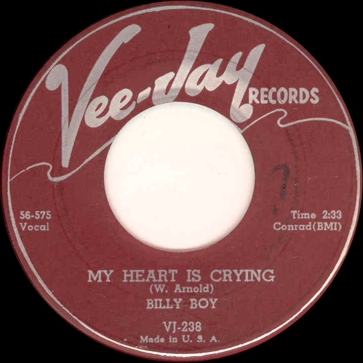
Billy Boy Arnold recorded his third session for Vee-Jay in November 1956. He was accompanied by Henry Gray (piano), Syl Johnson and Odell Campbell (electric guitars), and Fred Below (drums). The session produced one single, Vee-Jay 238, which the company first advertised on March 30, 1957 (Cash Box, p. 48). Another Cash Box ad for the single appeared on April 6 (p. 41), as did the review (p. 40). The single was advertised again on April 13 (p. 43) and May 11 (p. 49), but doesn't seem to have done much.
Arnold would make one last session for Vee-Jay, in September 1957, before leaving the label. He would go several years without a record deal.
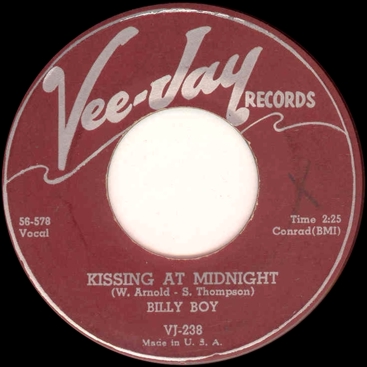
As the blues revival kicked in, Billy Boy Arnold recorded an LP, More Blues on the South Side, for Prestige (1964). During the 1960s and 1970s, Arnold was largely overlooked in the United States, but in Europe he toured and made a number of albums. During the 1990s, Arnold achieved the biggest successes of his career with two highly acclaimed CDs for the Chicago-based Alligator label, Back Where I Belong and Eldorado Cadillac.
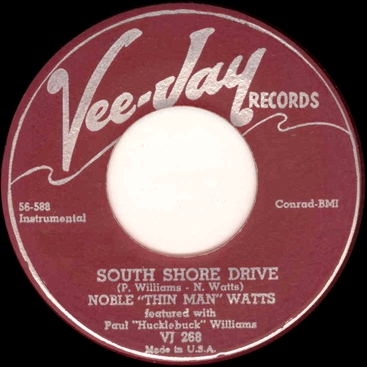
The final sesssion on our 1956 list featured the Paul "Hucklebuck" Williams orchestra starring his great tenor sax player Noble "Thin Man" Watts. Williams got top billing on the first release from the session; it went to Watts on the second. Following the Vee-Jay Master Book, Blues Records gives December 17 as the recording date. On the other hand Dan Kochakian in his Watts discography in Blues & Rhythm, Christmas 2003, gives August 1 as the date and New York the location. We infer that Vee-Jay picked up the sides that were recorded on August 1, and assigned them master numbers on December 17. An August 1 date would not fit the master number sequence.
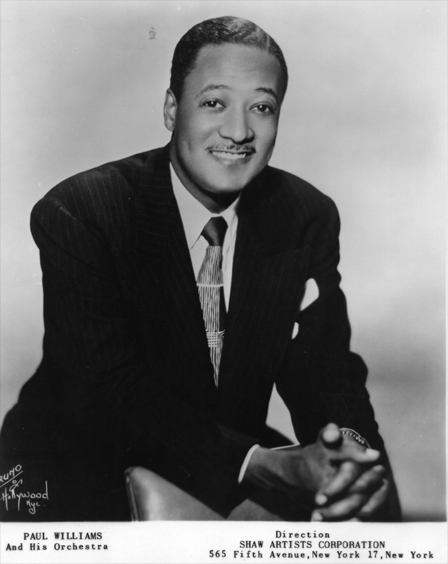
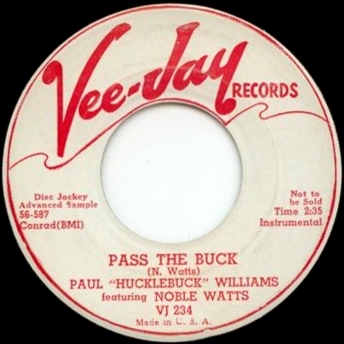
Bandleader and baritone sax player Paul Williams was born on July 15, 1915, in Lewisburg, Tennessee. He has come down in history for his gigantic 1949 hit, "The Hucklebuck." It was so big that the title became his new middle name. He began his professional career in 1946 with the Clarence Dorsey band. The following year he made his debut recording with Detroit bandleader King Porter for the Paradise label. In late 1947, Williams formed his own band and began recording for Savoy. During 1948-1949, Williams put eight records for Savoy on the national R&B charts. Upon his signing with Vee-Jay he had not had a hit in seven years, and he would not have any on Vee-Jay either. But he did have a torrid band that included Noble "Thin Man" Watts.
Famous hard blowing tenor sax man Noble Watts was born February 17, 1926 in Deland, Florida. He first recorded with the Griffin Brothers for Dot Records in 1951. In 1952 Watts joined the Paul Williams Orchestra. Watts made his first recordings on his own for Deluxe in 1954.
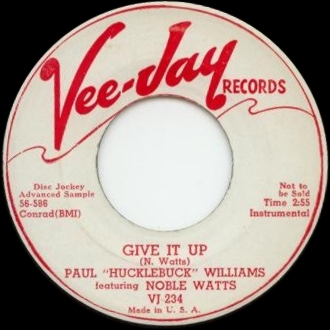
Vee-Jay 234 was released in February 1957. On February 9, Ewart Abner was boasting about audience response whenever DJs played the record (Cash Box, p. 40). The company advertised it in Cash Box on February 16 (p. 43) and Vee-Jay 234 was reviewed on February 23 (p. 39). As happened occasionally, the magazine ran a second review on March 9 (p. 42).
Vee-Jay 268 was held till the beginning of 1958. The likely intention was to draw on the sales Noble Watts was now drawing as a leader. The single was advertised in Cash Box on February 1, 1958 (p. 51). It did not sell anything like his Baton releases.
By the time the second Vee-Jay was released, Noble Watts had gone on to much greater success. He formed his own band in 1957, and for the next three years for New York-based Baton Records recorded a load of spectacular rock ‘n’ roll instrumentals. His biggest hit was "Hard Times (The Slop)," a major pop success from late 1957. During the 1960s he recorded on a variety of small labels, then retired for a couple of decades. Reentering the music business in the late 1980s, he recorded two albums—on Kingsnake (reissued on Alligator) and on Wild Dog. Watts died on August 24, 2004, in his hometown of Deland.
Paul Williams would subsequently lead the house band at Atlantic Records (into the 1960s), and for a spell directed the Lloyd Price and James Brown bands. By the end of the 1960s Williams was out of the music business. He died on September 14, 2002, in New York City.
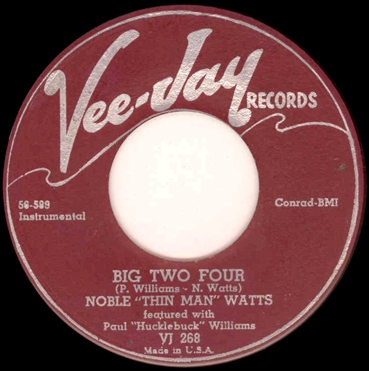
By the end of 1956, Vee-Jay had recorded 205 sides. National hits came from the Dells, the El Dorados, and Jimmy Reed. And the Vee-Jay gospel line was prospering, spearheaded by the success of the Staple Singers.
Vee-Jay would rush singles out if the company thought they were hot, and hold planned releases way back if they feared they not. 1956 releases included Vee-Jay 166, then ran from Vee-Jay 169 through Vee-Jay 229. The highest release number on a single from 1956 was Vee-Jay 232, by the Swan Silvertones. Vee-Jay 230 and 231 were pushed past the new year, and a couple of singles from the 220s (gospel releases got less attention from the trades) might have been comparably treated. If there were no holdbacks in the 220s, Vee-Jay got 63 singles out on the year.| 56-387 | The Spaniels | Baby Come along with Me | Vee-Jay 202 | Jan 19, 1956 | Jul 1956 |
| 56-388 | The Spaniels | Dear Heart | Vee-Jay 189 | Jan 19, 1956 | Jun 1956 |
| 56-389 | The Spaniels with Al Smiths Orchestra | Do You Really ? | Vee-Jay 178 | Jan 19, 1956 | late January 1956 |
| 56-390 | The Spaniels | Why Won't You Dance | Vee-Jay 189 | Jan 19, 1956 | Jun 1956 |
| 56-391 | The Spaniels with Al Smiths Orchestra | False Love | Vee-Jay 178 | Jan 19, 1956 | late January 1956 |
| 56-392 | The Magnificents | Yes, She's My Baby | (Solid Smoke LP 8030) | Jan 21, 1956 | |
| 56-393 | The Magnificents | Up on the Mountain | Vee-Jay 183 Vee-Jay 367 |
Jan 21, 1956 | Apr 1956 |
| 56-394 | The Magnificents | Lost Lover | Vee-Jay 235 | Jan 21, 1956 | Jan 1957 |
| 56-394 [alt.] | The Magnificents | Lost Lover [alt.] | (Vee-Jay NVD2-715 [CD]) | Jan 21, 1956 | |
| 56-395 | The Magnificents | Why Did She Go | Vee-Jay 183 | Jan 21, 1956 | Apr 1956 |
| 56-395 [alt.] | The Magnificents | Why Did She Go? [alt.] | (Vee-Jay NVD2-715 [CD]) | Jan 21, 1956 | |
| 56-396 | Priscilla Bowman and Jay McShann | I’ve Got News for You | Vee-Jay 179 | Jan 31, 1956 | Feb 1956 |
| 56-397 | Priscilla Bowman and Jay McShann | Who Needs a Man | unissued | Jan 31, 1956 | |
| 56-398 | Priscilla Bowman and Jay McShann | My Darkest Night | Vee-Jay 179 | Jan 31, 1956 | Feb 1956 |
| 56-399 | Priscilla Bowman and Jay McShan [sic] | Don’t Need Your Lovin’ | Vee-Jay 213 | Jan 31, 1956 | Nov 1956 |
| 56-400 | Newberry Singers | Name of Jesus | unissued | early Feb 1956 | |
| 56-401 | Newberry Singers | I Know He Lives in Me | unissued | early Feb 1956 | |
| 56-402 | Newberry Singers | I Could Tell the World | unissued | early Feb 1956 | |
| 56-403 | Newberry Singers | He's Everywhere | unissued | early Feb 1956 | |
| 56-404 | Newberry Singers | Do You Know | unissued | early Feb 1956 | |
| 56-405 | Newberry Singers | What Kind of Man | unissued | early Feb 1956 | |
| 56-406 | Newberry Singers | Eternal Life | unissued | early Feb 1956 | |
| 56-407 | Gospel Singers | Welcome Me | unissued | early Feb 1956 | |
| 56-408 | Gospel Singers | Too Close | unissued | early Feb 1956 | |
| 56-409 | Gospel Singers | Jesus Is Mine | unissued | early Feb 1956 | |
| 56-410 | The Hi-Liters | Feeling Alright This Morning | unissued | [Beltone NYC] Nov 10, 1955 |
|
| 56-411 | The Hi-Liters | Hello Dear | Vee-Jay 184 | [Beltone NYC] Nov 10, 1955 |
c. May 1956 |
| 56-412 | The Hi-Liters | Bobby Sox Baby | Vee-Jay 184 | [Beltone NYC] Nov 10, 1955 |
c. May 1956 |
| 56-413 | The Hi-Liters | Duncan's Box | unissued | [Beltone NYC] Nov 10, 1955 |
|
| 56-414 | The El Dorados | It's No Wonder | (Solid Smoke LP 8025) | Feb 10, 1956 | |
| 56-415 | The El Dorados | Love of My Own | (Solid Smoke LP 8025) | Feb 10, 1956 | |
| 56-416 | The El Dorados with Al Smith's Orchestra | Rock N Roll's for Me | Vee-Jay 180 | Feb 10, 1956 | Apr 1956 |
| 56-417 | The El Dorados | She Don't Run Around | (Charly LP 1022) | Feb 10, 1956 | |
| 56-418 | Edith Mackey with Arnett Cobb's Orch. | Skillets Gonna Fry | Vee-Jay 187 | Feb 17, 1956 | c. May 1956 |
| 56-419 | Edith Mackey with Arnett Cobb's Orch. | Rainy Morning Blues | Vee-Jay 187 | Feb 17, 1956 | c. May 1956 |
| 56-420 | Danny Cobb | I Pray for Your love | unissued | Feb 17, 1956 | |
| 56-421 | Danny Cobb | Some Day | unissued | Feb 17, 1956 | |
| 56-422 | Arnett Cobb | No Dues | Vee-Jay 190 | Feb 17, 1956 | c. Jun 1956 |
| 56-423 | Arnett Cobb | Slats | Vee-Jay 190 | Feb 17, 1956 | c. Jun 1956 |
| 56-424 | The Swan Silvertones | Jesus Remembers | Vee-Jay 182 | Feb 28, 1956 | Apr 1956 |
| 56-425 | The Swan Silvertones | Get Your Soul Right [My Soul Is a Witness*] |
(ABC 3418*, Oldies 45 206*, prob. Trip 9007*) | Feb 28, 1956 | |
| 56-426 | The Swan Silvertones | My Soul Is a Witness | Vee-Jay 182 | Feb 28, 1956 | Apr 1956 |
| 56-427 | The Swan Silvertones | The Lord’s Prayer | Vee-Jay 232 Vee-Jay 869 |
Feb 28, 1956 | Dec 1956 |
| 56-428 | Highway Q C’s | I Dreamed Heaven Was like This | Vee-Jay 195 | March 6, 1956 | Jul 1956 |
| 56-429 | The Highway Q C’s | I’ll Trust His Word | Vee-Jay 844 | March 6, 1956 | 1957 |
| 56-430 | The Highway Q C’s | I Was So Happy | Vee-Jay 844 | March 6, 1956 | 1957 |
| 56-431 | Highway Q C’s | He Lifted My Burdens | Vee-Jay 195 | March 6, 1956 | Jun 1956 |
| 56-432 | Maceo Woods Singers | Signs of the Judgment | Vee-Jay 193 | March 6, 1956 | Jun 1956 |
| 56-433 | Maceo Woods Singers | No Time to Lose | Vee-Jay 193 | March 6, 1956 | Jul 1956 |
| 56-434 | The Echoes of Eden | Jesus, the Man You Ought to Know | unissued | March 1956 | |
| 56-435 | The Echoes of Eden | The Crucified One | unissued | March 1956 | |
| 56-436 | The Echos of Eden [sic] | He’s My Everything | Vee-Jay 200 | March 1956 | Jul 1956 |
| 56-437 | The Echos of Eden [sic] | I Need Jesus | Vee-Jay 200 | March 1956 | Jul 1956 |
| 56-438 | The Echoes of Eden | He Knows My Heart | unissued | March 1956 | |
| 56-439 | The Argo Singers | He’s Alright With Me He's All Right with Me* |
Vee-Jay 201 Vee-Jay 900* |
March 9, 1956 | Jul 1956 |
| 56-440 | Argo Singers | He Never Said a Word | Vee-Jay 876 | March 9, 1956 | |
| 56-441 | Argo Singers | Somebody’s Knocking | Vee-Jay 876 | March 9, 1956 | |
| 56-442 | The Argo Singers | Lorenza Brown Soloist The Argo Singers* |
Near the Cross | Vee-Jay 201 Vee-Jay 900* |
March 9, 1956 | Jul 1956 |
| 56-443 | John Lee Hooker | I’m So Worried Baby | Vee-Jay 233 | March 27, 1956 | Jan 1957 |
| 56-444 | John Lee Hooker | Baby Lee | Vee-Jay 205 | March 27, 1956 | Oct 1956 |
| 56-445 | John Lee Hooker | Dimples | Vee-Jay 205 | March 27, 1956 | Oct 1956 |
| 56-446 | John Lee Hooker | Every Night | Vee-Jay 188 | March 27, 1956 | May 1956 |
| 56-447 | John Lee Hooker | The Road Is So Rough | Vee-Jay 233 | March 27, 1956 | Jan 1957 |
| 56-448 | John Lee Hooker | Trouble Blues | Vee-Jay 188 | March 27, 1956 | May 1956 |
| SO-44 56-449 |
The Spiritual Airs of Columbia, S. C. | Can’t Hide Sinner | Vee-Jay 181 | mastered April 1956 | May 1956 |
| SO-45 56-450 |
The Spiritual Airs of Columbia, S. C. | When the Saints Go Marching In | Vee-Jay 181 | mastered April 1956 | May 1956 |
| 56-451 | Camille Howard | Business Woman | Vee-Jay 198 | May 1, 1956 | Jul 1956 |
| 56-452 | Camille Howard | Rock 'n Roll Mama | Vee-Jay 198 | May 1, 1956 | Jul 1956 |
| 56-453 | Camille Howard | If You're Tired of Me | unissued | May 1, 1956 | |
| 56-454 | Camille Howard | In the Bag Boogie | (Charly CRB 1079) | May 1, 1956 | |
| 56-455 | The Original Five Blind Boys (Jackson Harmoneers) Soloist: Archie Brownlee | You Don’t Know | Vee-Jay 194 | May 2, 1956 | Jun 1956 |
| 56-456 | The Original Five Blind Boys (Jackson Harmoneers) Soloist: Archie Brownlee | I Never Heard a Man | Vee-Jay 194 | May 2, 1956 | Jun 1956 |
| 56-457 | The Original Five Blind Boys | No Need to Cry | unissued | May 2, 1956 | |
| 56-458 | The Orioles featuring Sonny Til | Happy 'till the Letter | Vee-Jay 196 | mid-May 1956 [Boulevard] |
Jun 1956 |
| 56-459 | Sonny Til’s Orioles | Didn't I Say | Vee-Jay 244 Abner 1016 |
mid-May 1956 [Boulevard] |
Apr 1957 |
| 56-460 | The Orioles featuring Sonny Til | I Just Got Lucky | Vee-Jay 196 | mid-May 1956 [Boulevard] |
Jun 1956 |
| 56-461 | Sonny Til’s Orioles | Sugar Girl | Vee-Jay 244 Abner 1016 |
mid-May 1956 [Boulevard] |
April 1957 |
| 56-462 | The Original Five Blind Boys (Jackson Harmoneers) | Jesus Loves Me | Vee-Jay 225 | May 17, 1956 | Nov 1956 |
| 56-463 | The Original Five Blind Boys (Jackson Harmoneers) | Don’t Forget the Bridge | Vee-Jay 240 | May 17, 1956 | Mar 1957 |
| 56-464 | The Original Five Blind Boys (Jackson Harmoneers) | Oh Why | Vee-Jay 225 | May 17, 1956 | Nov 1956 |
| 56-465 | The Dells | Oh What a Nite | Vee-Jay 204 Vee-Jay 338 |
May 21, 1956 | Sept 1956 |
| 56-466 | The Dells | Now I Pray | (Solid Smoke LP 8029) | May 21, 1956 | |
| 56-467 | The Dells | Jo-Jo | Vee-Jay 204 | May 21, 1956 | Sept 1956 |
| 56-468 | Dells | Baby Do | (Charly CRB 1056) | May 21, 1956 | |
| 56-469 | The El Dorados with Al Smith's Orchestra | There in the Night | Vee-Jay 211 | May 22, 1956 | Oct 1956 |
| 56-470 | The El Dorados | A Fallen Tear | Vee-Jay 197 | May 22, 1956 | Jun 1956 |
| 56-471 | The El Dorados | Chop Ling Soon | Vee-Jay 197 | May 22, 1956 | Jun 1956 |
| 56-472 | The El Dorados | Make Me a Sweetie | unissued | May 22, 1956 | |
| 56-473 | Sarah McLawler featuring Richard Otto | Molly and Me | unissued | May 26, 1956 | |
| 56-474 | Sarah Mc Lawler and Richard Otto | Relax Miss Frisky | Vee-Jay 239 | May 26, 1956 | Apr 1957 |
| 56-475-A | Sarah McLawler featuring Richard Otto | Babe in the Woods | Vee-Jay 199 | May 26, 1956 | Jul 1956 |
| 56-476 | Sarah McLawler featuring Richard Otto | Hot Toddy | unissued | May 26, 1956 | |
| 56-477 | Sarah McLawler featuring Richard Otto | Flamingo | Vee-Jay 199 | May 26, 1956 | Jul 1956 |
| 56-478 | Sarah McLawler featuring Richard Otto | Lonely Darling | unissued | May 26, 1956 | |
| 56-479 | John Lee Hooker | Don’t Get Tired | unissued | June 7, 1956 | |
| 56-480 | John Lee Hooker | Stop Talking | unissued | June 7, 1956 | |
| 56-481 | John Lee Hooker | Time and a Half | unissued | June 7, 1956 | |
| 56-482 | John Lee Hooker | Lonely Blues | unissued | June 7, 1956 | |
| 56-483 | Jimmy Reed | When You Left Me | (Vee-Jay LP 7303) | June 11, 1956 | |
| 56-484 | Jimmy Reed | I Love You Baby | Vee-Jay 203 | June 11, 1956 | Jul 1956 |
| 56-485 | Jimmy Reed | You So Sweet | unissued | June 11, 1956 | |
| 56-486 | Jimmy Reed | My First Plea | Vee-Jay 203 | June 11, 1956 | Jul 1956 |
| 56-487 | Eddie Taylor | You’ll Always Have a Home | Vee-Jay 206 | July 9, 1956 | Sept 1956 |
| 56-488 | Eddie Taylor | Don’t Knock at My Door | Vee-Jay 206 | July 9, 1956 | Sept 1956 |
| 56-489 | Eddie Taylor | Good Hearted | unissued | July 9, 1956 | |
| 56-490 | Eddie Taylor | Bongo Beat | unissued | July 9, 1956 | |
| 56-491 | The Kool Gents | I Just Can’t Help Myself | Vee-Jay 207 | July 1956 | Oct 1956 |
| 56-492 | The Kool Gents | When I Call on You | unissued | July 1956 | |
| 56-493 | The Delegates with Al Smith's Orchestra [sic] | I’m Gonna Be Glad | Vee-Jay 243 | July 1956 | 1957 |
| 56-494 | The Kool Gents | Just like a Fool | July 1956 | (Vee-Jay LP 1019 [?]) | |
| 56-495 | The Magnificents | Caddy Bo | rejected | July 13, 1956 | |
| 56-496 | The Magnificents | This Ole Love of Mine | rejected | July 13, 1956 | |
| 56-497 | The Magnificents | Hiccup | rejected | July 13, 1956 | |
| 56-498 | The Magnificents | Off the Mountain | rejected | July 13, 1956 | |
| 56-499 | Snooky Pryor | You Tried to Ruin Me | (Charly CRB 1042) | July 17, 1956 | |
| 56-500 | Snooky Pryor | Someone to Love Me | Vee-Jay 215 | July 17, 1956 | Oct 1956 |
| 56-500 [alt] | Snooky Pryor | Someone to Love Me [alt] | (Charly CRB 1042) | July 17, 1956 | |
| 56-501 | Snooky Pryor | A Date with My Baby | unissued | July 17, 1956 | |
| 56-502 | Snooky Pryor | Judgment Day | Vee-Jay 215 | July 17, 1956 | Oct 1956 |
| 56-502 [alt] | Snooky Pryor | Judgment Day [alt] | (Charly CRB 1042) | July 17, 1956 | |
| 56-503 | Duke Groner | Push | unissued | July 1956 | |
| 56-504 | Duke Groner | Chico’s Bounce | Vee-Jay 216 | July 1956 | Nov 1956 |
| 56-505 | Duke Groner | Oppin’ for Later | Vee-Jay 216 | July 1956 | Nov 1956 |
| 56-506 | Duke Groner | Five O'Clock Drag | unissued | July 1956 | |
| 56-507 | The Magnificents | Off the Mountain | Vee-Jay 235 | late July 1956 [Boulevard] | Jan 1957 |
| 56-507 [alt] | The Magnificents | Off the Mountain [alt.] | (Vee-Jay NVD2-715) | late July 1956 [Boulevard] | |
| 56-508 | The Magnificents | Caddy Bo | Vee-Jay 208 | late July [Boulevard] | Oct 1956 |
| 56-509 | The Magnificents | Hiccup | Vee-Jay 208 | late July [Boulevard] | Oct 1956 |
| 56-509 [alt] | The Magnificents | Hiccup [alt.] | (Vee-Jay NVD2-715) | late July [Boulevard] | |
| 56-510 | The Magnificents | This Ole Love of Mine | (Solid Smoke LP 8030) | late July 1956 [Boulevard] | |
| 56-511 | The Spiritualaires of Columbia, S. C. | I'm out on Life's Ocean | Vee-Jay 210 | Aug 1956 | c. Oct 1956 |
| 56-512 | The Spiritualaires of Columbia, S.C. | I'm Going on to Glory | Vee-Jay 210 | Aug 1956 | c. Oct 1956 |
| 56-513 | The El Dorados with Al Smith's Orchestra | Bim Bam Boom | Vee-Jay 211 | Aug 8, 1956 | Oct 1956 |
| 56-513 [alt] | El Dorados | Bim Bam Boom [alt] | (Famous Groove FG.971002 [CD]) | Aug 8, 1956 | |
| 56-514 | Jo Ann Raven | Supernatural Love | Vee-Jay 217 | prob. Aug 8, 1956 | Oct 1956 |
| 56-515 | Jo Ann Raven | Wait a Minute | Vee-Jay 217 | prob. Aug 8, 1956 | Oct 1956 |
| 56-516 | Red Holloway (Al Smith Orch.) | Red's Wailin' | unissued | Aug 21, 1956 | |
| 56-517 | The Delegates | The Convention | Vee-Jay 212 | Aug 21, 1956 | Sept 1956 |
| 56-518 | Al Smith | instrumental | unissued | Aug 21, 1956 | |
| 56-519 | Pee Wee Crayton | Tie It Down | unissued | Sept 7, 1956 | |
| 56-520 | Pee Wee Crayton | Fiddle Dee Dee | Vee-Jay 266 | Sept 7, 1956 | 1957 |
| 56-521 | Pee Wee Crayton | A Frosty Night | Vee-Jay 214 | Sept 7, 1956 | Oct 1956 |
| 56-522 | Pee Wee Crayton | The Telephone Is Ringing | Vee-Jay 214 | Sept 7, 1956 | Oct 1956 |
| 56-523 | The Kelly Brothers | Prayer for Tomorrow | Vee-Jay 220 | Sept 1956 | Dec 1956 |
| 56-524 | The Kelly Brothers | God Said He Was Coming | Vee-Jay 220 | Sept 1956 | Dec 1956 |
| 56-525 | Helen Robinson Youth Chorus | Time Is Winding Up | Vee-Jay 221 | Sept 11, 1956 | c. Dec 1956 |
| 56-526 | Helen Robinson Youth Chorus | Dwelling in Beulah Land | Vee-Jay 221 | Sept 11, 1956 | c. Dec 1956 |
| 56-527 | The Staple Singers | Uncloudy Day | Vee-Jay 224 | Sept 11, 1956 | Nov 1956 |
| 56-528 | The Staple Singers | I Know I Got Religion | Vee-Jay 224 | Sept 11, 1956 | Nov 1956 |
| 56-529 | The Staple Singers | Come on up in Glory | (Vee-Jay LP 5008) | Sept 11, 1956 | |
| 56-530 | The Staple Singers | Let Me Ride | Vee-Jay 846 | Sept 11, 1956 | 1957 |
| 56-531 | The Silver Quintette | Father Don’t Leave | Vee-Jay 223 | Sept 11, 1956 | Dec 1956 |
| 56-532 | The Silver Quintette | Sinner’s Crossroads | Vee-Jay 223 | Sept 11, 1956 | Dec 1956 |
| 56-533 | Maceo Woods Singers | Walls of Jericho | Vee-Jay 242 | Sept 11, 1956 | 1957 |
| 56-534 | Maceo Woods Singers | If You Miss Me Here | Vee-Jay 242 | Sept 11, 1956 | 1957 |
| 56-535 | Maceo Woods Singers | Handwriting on the Wall | unissued | Sept 11, 1956 | |
| 56-536 | Maceo Woods Singers | Leaning on the Lord | (Vee-Jay LP 5053) | Sept 11, 1956 | |
| 56-537 | Maceo Woods Singers | Just a Closer Walk with Thee | (Vee-Jay LP 5001) | Sept 11, 1956 | |
| 56-538 | The Swan Silvertones | The Lord Is Coming | (Vee-Jay LP 18008) | Sept 12, 1956 | |
| 56-539 | The Swan Silvertones | Traveling On | Vee-Jay 222 | Sept 12, 1956 | Nov 1956 |
| 56-540 | The Swan Silvertones | When Jesus Comes | Vee-Jay 222 | Sept 12, 1956 | Nov 1956 |
| 56-541 | The Swan Silvertones | Somebody Loves Me | (Vee-Jay LP 18008) | Sept 12, 1956 | |
| 56-542 | The Swan Silvertones | Great Day in December | Vee-Jay 232 Vee-Jay 869 |
Sept 12, 1956 | Dec 1956 |
| 56-543 | The Dells | It Takes Time | unissued | Sept 5, 1956 | |
| 56-544 | The Dells with Al Smith's Orchestra | I Wanna Go Home | Vee-Jay 230 Vee-Jay 338 |
Sept 5, 1956 | Dec 1956 |
| 56-545 | The Dells | When You Kiss Me | unissued | Sept 5, 1956 | |
| 56-546 | The Dells with Al Smith's Orchestra | Movin’ On | Vee-Jay 230 | Sept 5, 1956 | Dec 1956 |
| 56-547 | Johnny McPhee | Lullaby of Birdland | unissued | ||
| 56-548 | Johnny McPhee | Lester Leaps In | unissued | ||
| 56-549 | Johnny McPhee | How High the Moon | unissued | ||
| 56-550 | Johnny McPhee | Get the Butter | unissued | ||
| 56-551 | Jimmy Reed | You've Got Me Dizzy | Vee-Jay 226 | Oct 3, 1956 | Nov 1956 |
| 56-552 | Jimmy Reed | Honey, Don’t Let Me Go | Vee-Jay 226 | Oct 3, 1956 | Nov 1956 |
| 56-553 | Jimmy Reed | untitled instrumental | (Charly CD RED BOX9) | Oct 3, 1956 | |
| 56-554 | The Rasberry Singers | Jesus Is All to Me | Vee-Jay 231 | Oct 10, 1956 | c. Jan 1957 |
| 56-555 | The Rasberry Singers | Where Jesus Is the Light | Vee-Jay 852 | Oct 10, 1956 | 1957 |
| 56-556 | The Rasberry Singers | Let’s Spread the News | Vee-Jay 852 | Oct 10, 1956 | 1957 |
| 56-557 | The Rasberry Singers | No Tears in Heaven | Vee-Jay 231 | Oct 10, 1956 | c. Jan 1957 |
| 56-558 | Po Joe Williams | Goin' Back | Vee-Jay 227 | Oct 16, 1956 | Dec 1956 |
| 56-559 | Po Joe Williams | My Baby Left | Vee-Jay 227 | Oct 16, 1956 | Dec 1956 |
| 56-560 | Po Joe Williams | King’s Highway | (Vee-Jay LP 1000) | Oct 16, 1956 | |
| 56-561 | Po Joe Williams | Eula Mae | (Vee-Jay LP 1000) | Oct 16, 1956 | |
| 56-562 | Tommy Dean | Boogie Googie (part 1) | unissued | Oct 23, 1956 | |
| 56-563 | Tommy Dean | Boogie Googie (part 2) | unissued | Oct 23, 1956 | |
| 56-564 | Tommy Dean | Ain’t No Justice | unissued | Oct 23, 1956 | |
| 56-565 | Tommy Dean | She Left Me Alone | unissued | Oct 23, 1956 | |
| 56-566 | Tommy Dean | Come On | unissued | Oct 23, 1956 | |
| 56-567 | The Orioles | Fools will Be Fools | unissued | Oct 1956 | |
| 56-568 | The Orioles | Live It Up | (Vee-Jay LP 1021) | Oct 1956 | |
| 56-569 | Sonny Til’s Orioles | For All We Know | Vee-Jay 228 | Oct 1956 | Nov 1956 |
| 56-570 | Sonny Til’s Orioles | Never Leave Me Baby | Vee-Jay 228 | Oct 1956 | Nov 1956 |
| 56-571 | The Spaniels with Al Smiths Orchestra | Please Don’t Tease | Vee-Jay 229 | Nov 5, 1956 | Nov 1956 |
| 56-572 | The Spaniels | Jessie Mae | (Solid Smoke LP 8028) | Nov 5, 1956 | |
| 56-573 | The Spaniels with Al Smith's Orch. | I Need Your Kisses | Vee-Jay 257 | Nov 5, 1956 | Aug 1957 |
| 56-574 | The Spaniels with Al Smiths Orchestra | You Gave Me Peace of Mind | Vee-Jay 229 | Nov 5, 1956 | Nov 1956 |
| 56-575 | Billy Boy [Arnold] | My Heart Is Crying | Vee-Jay 238 | Nov 1956 | Mar 1957 |
| 56-576 | Billy Boy | How Come You Leave Heaven | unissued | Nov 1956 | |
| 56-577 | Billy Boy | Heartache and Trouble | unissued | Nov 1956 | |
| 56-578 | Billy Boy | Kissing at Midnight | Vee-Jay 238 | Nov 1956 | Mar 1957 |
| 56-579 | Sarah McLawler featuring Richard Otto | Sorghum Switch | unissued | Nov 21, 1956 | |
| 56-580 | Sarah McLawler featuring Richard Otto | Talk of the Town | unissued | Nov 21, 1956 | |
| 56-581 | Sarah McLawler featuring Richard Otto | I Only Have Eyes for You | unissued | Nov 21, 1956 | |
| 56-582 | Sarah McLawler featuring Richard Otto | I've Got It Bad | unissued | Nov 21, 1956 | |
| 56-583 | Sarah McLawler featuring Richard Otto | Tenderly | unissued | Nov 21, 1956 | |
| 56-584A | Sarah Mc Lawler and Richard Otto | Snowfall | Vee-Jay 239 | Nov 21, 1956 | Apr 1957 |
| 56-585 | Sarah McLawler featuring Richard Otto | What’s New | unissued | Nov 21, 1956 | |
| 56-586 | Paul "Hucklebuck" Williams featuring Noble Watts | Give It Up | Vee-Jay 234 | [New York] Aug 1, 1956 |
Feb 1957 |
| 56-587 | Paul "Hucklebuck" Williams featuring Noble Watts | Pass the Buck | Vee-Jay 234 | [New York] Aug 1, 1956 |
Feb 1957 |
| 56-588 | Noble "Thin Man" Watts featured with Paul "Hucklebuck" Williams | South Shore Drive | Vee-Jay 268 | [New York] Aug 1, 1956 |
Jan 1958 |
| 56-589 | Noble "Thin Man" Watts featured with Paul "Hucklebuck" Williams | Big Two Four | Vee-Jay 268 | [New York] Aug 1, 1956 |
Jan 1958 |
In 1957, Vee-Jay separated its gospel releases from its popular series. The company created an 800 series, beginning with 843, for all gospel releases. Apparently the series began at 843 because the last gospel release in the main series was 242…and that happened to be the company's 42nd gospel release. Vee-Jay advertised 240 by The Original Five Blind Boys and 843 by The Swan Silvertones in Cash Box for March 30, 1957 (p. 45); an ad for Vee-Jay 238 and 843 ran on April 6 (p. 41).
That same year, Vee-Jay launched its first subsidiary label, called Falcon. In 1958, when it was brought to the company's attention that the Rio Grande Valley of Texas already had its own Falcon label, the subsidiary’s name was changed to Abner. The label art wasn't changed, however. Abner kept going through 1959, then was briefly revived in 1962. In 1957, Vee-Jay also finally got to LPs, in a 1000 series. These concentrated on rhythm and blues and jazz, eventually adding rock and pop. The LP release schedule was initially modest—two in 1957, and two in 1958. The big launch came with ten in 1959.
In 1959, Vee-Jay bought a two-story building at 1449 South Michigan Avenue and moved its headquarters there. With the move the company quit handling its distribution in Chicago, handing the local market off to M. S. Distributing. The company remained in this building until its liquidation in 1966.
In 1959, the company inaugurated its 5000 LP series for gospel, starting with six releases: the Staple Singers, Maceo Woods, the Harmonizing Four, the Swan Silvertones, the Five Blind Boys of Mississippi, and the Highway QC’s. Many of the early LPs gathered gospel material recorded during the company’s first four years.
Also in 1959, Vee-Jay launched a line of jazz albums, with A&R handled by Sid McCoy, one of Chicago’s best known jazz deejays. Vee-Jay was involved in the ownership of the Sutherland Lounge on the South Side. Miles Davis played there around this time, and the company ended up signing some prominent Davis sidemen—Wynton Kelly and Paul Chambers—as well as Wayne Shorter, Frank Strozier, and Lee Morgan. Initially, the jazz was released on the 1000 series, with LPs by Bennie Green and Gene Ammons, Paul Chambers, Bill Henderson, Wynton Kelly, and Richard Otto and Sarah McLawler. In 1960, a separate 3000 series was begun for the jazz line.
A 4000 comedy series was launched in 1962. While singles continued to be the mainstay of the company’s operations, LPs developed into a solid segment of the Vee-Jay’s sales, especially in its growing jazz and gospel lines.
In 1961 Abner became president. Under his stewardship the company became a major independent by not only getting hits with such R&B acts as Jerry Butler, Gene Chandler, Dee Clark, and Betty Everett, but also for signing major pop acts. The Four Seasons were brought in via a deal with an independent production company, and the rights to issue Beatles material for 5 years were acquired from EMI after Capitol (which handled most EMI material in the United States) passed on the offer.
But trouble was brewing. In 1963 Abner was fired from Vee Jay and formed a new label called Constellation. James and Vivian Carter brought in a new management team, who because their homes were on the West Coast moved the company’s headquarters to Los Angeles in early 1964. The company ran into financial trouble in 1965, and the Brackens fired the West Coast management team in June. Jimmy Bracken assumed the presidency and brought back Ewart Abner as general manager. In October, Vee-Jay closed its West Coast offices and moved the headquarters back to Chicago. In December, in a desperate bid to save the company, Abner sold Vee-Jay’s most valuable properties, its three publishing companies—Conrad Publishing, Tollie Music, and Gladstone Music—to Arc Music.
In May 1966 Vee-Jay was forced into bankruptcy. The remaining assets were auctioned off in 1967. After Vee-Jay, Abner continued his high profile in the music business. In 1967, Berry Gordy brought Abner into Motown to handle the company's artist management, and from 1973 to 1975 Abner served as the company's president. Abner continued an indirect association with Motown by handling the business affairs for Stevie Wonder. After Gordy sold Motown in 1988, he brought Abner in as an executive at his newly formed Gordy Company. Abner died in Los Angeles on December 27, 1997.
Calvin Carter continued to work as an independent producer, getting several hits on Betty Everett. He operated a small label during 1972-73, recording Bobby Rush. In 1975 he moved to the West Coast where the music business had migrated. On July 9, 1986, he died in Los Angeles.
After Vee-Jay went bankrupt in 1966, James and Vivian Bracken continued for a few more months putting out Vee-Jay product on the Exodus label. After that, Jimmy Bracken struggled with various ventures in the record business, including a blues label, none of which got off the ground. He died in Chicago, on February 20, 1972. Vivian Carter divorced Jimmy Bracken, and returned to radio in Gary. After suffering a stroke, she died in a nursing home on June 12, 1989.
We gathered this discography from various published sources—jazz, blues, and gospel—and from consulting the actual records. We have also had the good fortune to be able to get corrections from copies of the Vee-Jay Master Book that are in the hands of collectors. Bill Daniels provided us with release dates, which we are now able to supplement from the American Radio History online archives of Cash Box.
We used a vast variety of sources in compiling this Vee-Jay page. Discographical sources include Blues Records 1943-1970, Volume One A to K, compiled by Mike Leadbitter and Neil Slaven (London: Record Information Services, 1987); Blues Records 1943-1970, Volume Two L to Z, compiled by Mike Leadbitter, Leslie Fancourt, and Paul Pelletier (London: Record Information Services, 1994); Gospel Records, 1943-1969, A Black Music Discography, Volume One, compiled by Cedric Hayes and Robert Laughton (London: Record Information Services, 1992); Gospel Records, 1943-1969, A Black Music Discography, Volume Two, compiled by Cedric Hayes and Robert Laughton (London: Record Information Services, 1992); The Jazz Discography, compiled by Tom Lord (West Vancouver, Canada: Lord Music Reference, 1993-2000); Bez Turner, "Vee-Jay Records," Blues Unlimited, No. 135/136 (July/September 1979): 21-26; Album Discographies [http://www.bsnpubs.com/discog.html], compiled by Mike Callahan, David Edwards, and Patrice Eyries, December 20, 2003; and Sarah McLawler-Richard Otto Draft Discography, by Anthony Barnett, May 20, 2004 [http://www.abar.net/otto.htm]. We also made use of the Mohr-Flückiger-Demeusy (MFD) files, a collection of discographical information created by two Swiss discographers and a French colleague.
History sources include Mike Callahan and David Edwards, "The Vee-Jay Story" [http://www.bsnpubs.com/veejay/veejay.html], April 13, 1999; and Horace Clarence Boyer (text) and Lloyd Yearwood (photography), How Sweet The Sound: The Golden Age of Gospel (Washington, DC: Elliot & Clark, 1995).
Artist sources include All Music Guide to Blues, third edition, edited by Vladimir Bogdanov, Chris Woodstra, and Stephen Thomas Erlewine (Ann Arbor, Mich.: 2003); Robert Santelli, The Big Book of Blue: A Biographical Encyclopedia, revised and updated (New York: Penguin Books, 2001); Bob Marovich, "The Gospel Highway, Building the Ultimate Gospel Collection," Gospel [http://www.island.net/~blues/gospel.htm]. We are particularly indebted to Marovich, whose reviews of what he considers essential gospel recordings we have quoted liberally.
Nonprint sources include the Robert Pruter interview with Art Sheridan, Oak Brook, Illinois, July 2, 1992; Portia Maultsby interview with Ewart Abner, Santa Monica, California, October 21, 1984; email correspondence with Dr. Robert Stallworth who provided label copy data; an email from Alan Balfour providing the proper credit for the 1959 photo of the four prinicipals at Vee-Jay; an email from Dave Sax with further discographical corrections; an email from Dani Gugolz with corrections to the first Jay McShann session, emails from Dave Sax with corrections to several sessions, and scans from their collections provided by Dr. Robert Stallworth, Tom Kelly, Big Joe Louis, Billy Vera, Victor Pearlin, and Robert L. Campbell.
Click here to return to Red Saunders Research Foundation page.